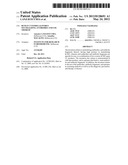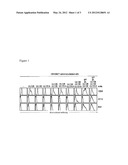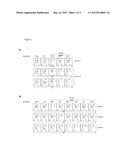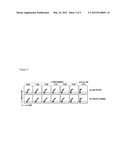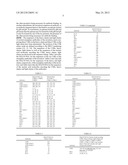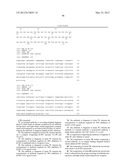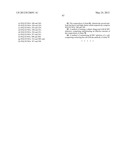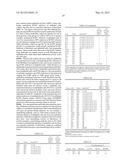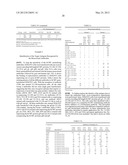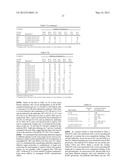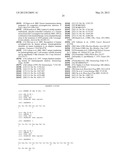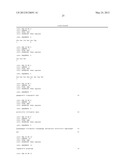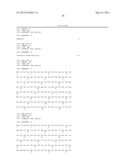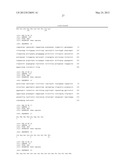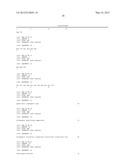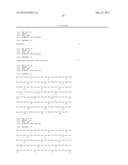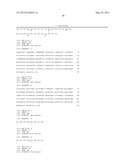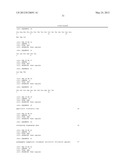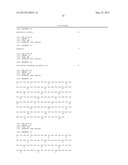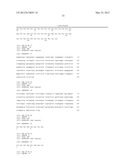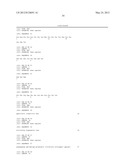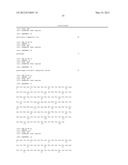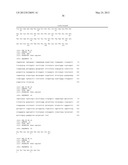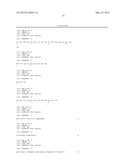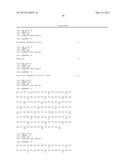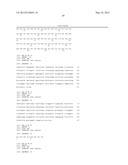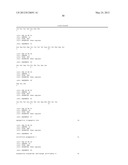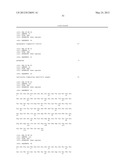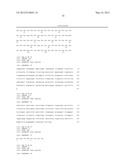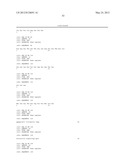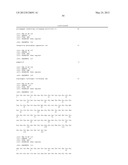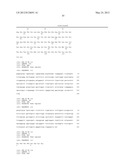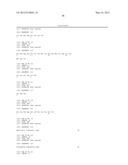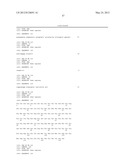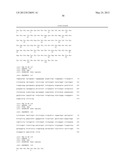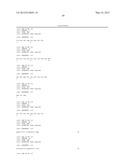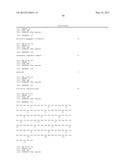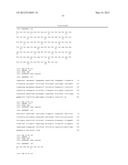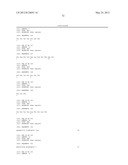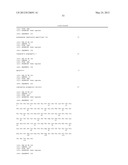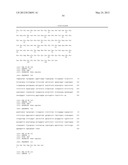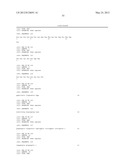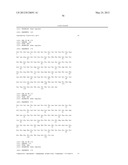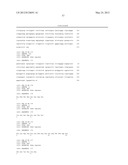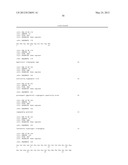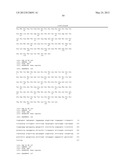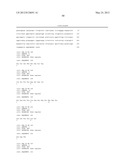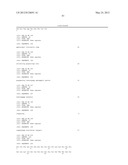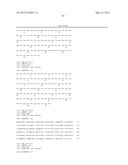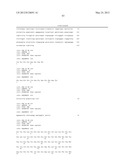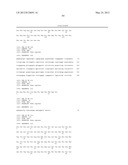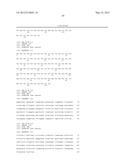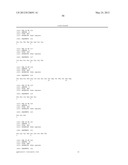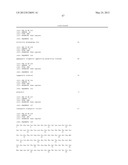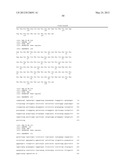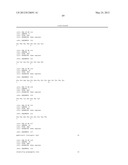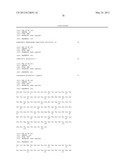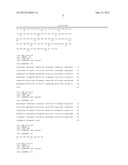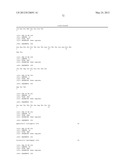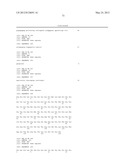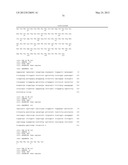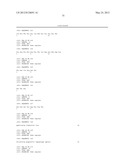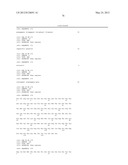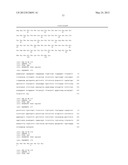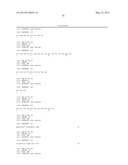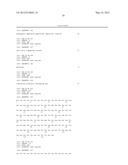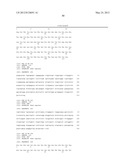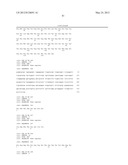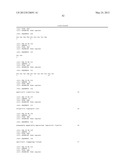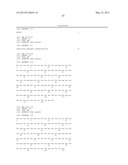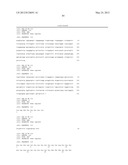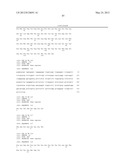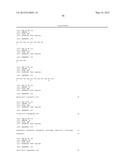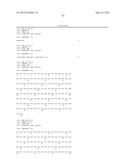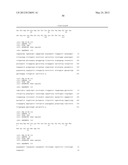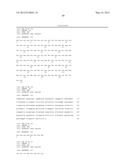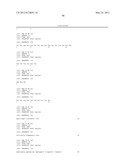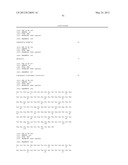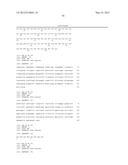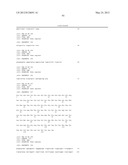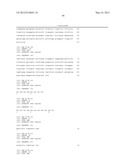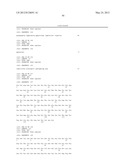Patent application title: HUMAN CYTOMEGALOVIRUS NEUTRALIZING ANTIBODIES AND USE THEREOF
Inventors:
Antonio Lanzavecchia (Bellinzona, CH)
Antonio Lanzavecchia (Bellinzona, CH)
Annalisa Macagno (Bellinzona, CH)
Annalisa Macagno (Bellinzona, CH)
Assignees:
INSTITUTE FOR RESEARCH IN BIOMEDICINE
IPC8 Class: AA61K3942FI
USPC Class:
4241591
Class name: Drug, bio-affecting and body treating compositions immunoglobulin, antiserum, antibody, or antibody fragment, except conjugate or complex of the same with nonimmunoglobulin material binds virus or component thereof
Publication date: 2012-05-24
Patent application number: 20120128691
Abstract:
The invention relates to neutralizing antibodies, and antibody fragments
thereof, having high potency in neutralizing hCMV, wherein said
antibodies and antibody fragments are specific for one, or a combination
of two or more, hCMV gene UL products. The invention also relates to
immortalized B cells that produce, and to epitopes that bind to, such
antibodies and antibody fragments. In addition, the invention relates to
the use of the antibodies, antibody fragments, and epitopes in screening
methods as well as in the diagnosis, prevention, and therapy of disease.Claims:
1-70. (canceled)
71. An isolated antibody, or an antigen binding fragment thereof, which binds an epitope recognized by an antibody having heavy and light chains which respectively comprise amino acid sequences as set forth in SEQ ID NOs. 61 and 62, wherein the antibody or fragment inhibits hCMV infection.
72. The antibody or fragment of claim 71, which is specific for a complex comprising hCMV proteins UL130 and UL131A.
73. The antibody or fragment of claim 71, wherein the concentration of antibody required for 50% inhibition of hCMV in epithelial cells is 10 μg/ml or less.
74. The antibody or fragment of claim 73, wherein the concentration of antibody required for 50% inhibition of hCMV is 0.2 μg/ml or less.
75. The antibody or fragment of claim 73, wherein the concentration of antibody required for 50% inhibition of hCMV is 0.1 μg/ml or less.
76. The antibody or fragment of claim 73, wherein the concentration of antibody required for 50% inhibition of hCMV is 0.01 μg/ml.
77. The antibody or fragment of claim 71, wherein the antibody is a human antibody, a monoclonal antibody, a single chain antibody, Fab, Fab', F(ab')2, Fv or scFv.
78. A composition comprising the antibody or fragment of claim 71, and a diluent or carrier.
79. The composition of claim 78, further comprising a second antibody, or an antigen binding fragment thereof, which inhibits hCMV infection.
80. The composition of claim 79, wherein the second antibody binds to an hCMV gB protein.
81. The composition of claim 80 wherein the second antibody is selected from the group consisting of antibodies having heavy and light chains which respectively comprise: (a) SEQ ID NOs: 348 and 349; (b) SEQ ID NOs: 328 and 329; (c) SEQ ID NOs: 334 and 329; (d) SEQ ID NOs: 290 and 291; (d) SEQ ID NOs: 294 and 291; (e) SEQ ID NOs: 357 and 291; (f) SEQ ID NOs: 308 and 309; (g) SEQ ID NOs: 314 and 309; and (h) SEQ ID NOs: 367 and 368.
82. The composition of claim 81, wherein the second antibody has heavy and light chains which respectively comprise SEQ ID NOs: 348 and 349.
83. A method of treating a subject diagnosed with hCMV infection, comprising administering an effective amount of the composition of claim 78.
84. A method of neutralizing hCMV infection of a cell, comprising contacting the cell with the antibody of claim 71.
Description:
[0001] This application claims the benefit of priority of U.S. provisional
Application No. 61/081,334, filed Jul. 16, 2008, the disclosures of which
is hereby incorporated by reference as if written herein in its entirety.
BACKGROUND
[0002] Human cytomegalovirus (hCMV) is a widely distributed pathogen that may cause severe pathology in immunosuppressed adults and upon infection of the fetus and has been implicated in chronic diseases such as atherosclerosis. hCMV infects multiple cell types including fibroblasts, endothelial, epithelial and hematopoietic cells [1]. In vitro propagated attenuated strains of hCMV, which are being developed as candidate vaccines, have lost the tropism for endothelial cells, while retaining the capacity to infect fibroblasts [2]. Two viral glycoprotein complexes are believed to control the cellular tropism of hCMV. A complex of glycoproteins such as gH, gL and gO appears to be required for infection of fibroblasts, while a complex of gH, gL and proteins encoded by the UL131-UL128 genes is implicated in infection of endothelial cells, epithelial cells and dendritic cells [2-8].
[0003] Hyperimmune globulins are already commercialized for the prophylaxis of hCMV disease associated with transplantation and recent evidence indicates that they have therapeutic effect in pregnant women [9]. This therapeutic approach is limited by the low amount of neutralizing antibody that can be transferred and for this reason the availability of human antibodies (such as human monoclonal antibodies) with high neutralizing capacity would be highly desirable. Although some antibodies to gH, gB and UL128 and UL130 gene products have demonstrated in vitro neutralizing activities [7, 10, 11] and an antibody to gH was evaluated in clinical trials (that were discontinued due to lack of therapeutic effects), the neutralizing potency of the antibodies isolated so far is modest. Neutralization by these antibodies was observed at antibody concentrations ranging from 0.5 to 20 μg/ml. Further, the current methods typically measure the neutralizing potency of anti-hCMV antibodies using fibroblasts as target cells. However, hCMV is also known to cause pathology by infecting other cell types such as endothelial, epithelial cells and leukocytes. Known antibodies to UL128 and UL130 show very low potency in neutralizing infection of endothelial cells [7] and there do not appear to be any monoclonal antibodies available that would be capable of neutralizing infection of non-fibroblast target cells with high potency.
[0004] There is therefore a need for antibodies that neutralize hCMV infection, particularly hCMV infection of non-fibroblast target cells, with high potency, as well as the elucidation of the target(s) to which such antibodies bind.
SUMMARY OF INVENTION
[0005] The invention is based, in part, on the discovery of novel antibodies that neutralize hCMV infection with high potency as well as novel epitopes to which the antibodies of the invention bind. Accordingly, in one aspect, the invention comprises an antibody and antigen binding fragments thereof that have high potency in neutralizing hCMV.
[0006] In one embodiment of the invention, the invention comprises a monoclonal antibody, or an antigen binding fragment thereof, that binds to an epitope in the hCMV UL128 protein, wherein the antibody neutralizes hCMV infection. In another embodiment of the invention, the invention comprises an antibody, or an antigen binding fragment thereof, that binds to an epitope formed by the hCMV proteins gH, gL, UL128 and UL130, the hCMV proteins UL128, UL130 and UL131A, or the hCMV proteins UL130 and UL131A, wherein the antibody neutralizes hCMV infection.
[0007] In yet another embodiment of the invention, the invention comprises an antibody, or an antigen binding fragment thereof, comprising at least one complementarity determining region ("CDR") sequence having at least 95% sequence identity to any one of SEQ ID NOs: 188-193, 204, 205, 210, 174-177, 149, 178, 65-70, 81-86, 97-102, 129-134, 145-150, 113, 161-164, 1-6, 17-22, 33-38, 49-54, or 114-118, wherein the antibody neutralizes hCMV infection.
[0008] In yet another embodiment of the invention, the invention comprises a heavy chain CDR1 selected from the group consisting of SEQ ID NOs: 188, 174, 65, 81, 97, 129, 145, 113, 1, 17, 33, and 49; a heavy chain CDR2 selected from the group consisting of SEQ ID NOs: 189, 204, 175, 66, 82, 98, 130, 146, 161, 2, 2, 18, 34, 50, and 114; and a heavy chain CDR3 selected from the group consisting of SEQ ID NOs: 190, 205, 210, 176, 67, 83, 99, 131, 147, 162, 3, 19, 35, 51, and 115, wherein the antibody neutralizes hCMV infection. In yet another embodiment of the invention, the invention comprises an antibody, or an antigen binding fragment thereof, comprising a light chain CDR1 selected from the group consisting of SEQ ID NOs: 191, 177, 68, 84, 100, 132, 148, 163, 4, 20, 36, 52, and 116; a light chain CDR2 selected from the group consisting of SEQ ID NOs: 192, 149, 69, 85, 101, 133, 5, 21, 37, 53, and 117; and a light chain CDR3 selected from the group consisting of SEQ ID NOs: 193, 178, 70, 86, 102, 134, 150, 164, 6, 22, 38, 54, and 118, wherein the antibody neutralizes hCMV infection.
[0009] In still another embodiment of the invention, the invention comprises an antibody, or an antigen binding fragment thereof, wherein the antibody comprises a heavy chain variable region comprising the amino acid sequence of SEQ ID NO: 200 and a light chain variable region comprising the amino acid sequence of SEQ ID NO: 201; or a heavy chain variable region comprising the amino acid sequence of SEQ ID NO: 200 and a light chain variable region comprising the amino acid sequence of SEQ ID NO: 213; or a heavy chain variable region comprising the amino acid sequence of SEQ ID NO: 208 and a light chain variable region comprising the amino acid sequence of SEQ ID NO: 201; or a heavy chain variable region comprising the amino acid sequence of SEQ ID NO: 208 and a light chain variable region comprising the amino acid sequence of SEQ ID NO: 213; or a heavy chain variable region comprising the amino acid sequence of SEQ ID NO: 212 and a light chain variable region comprising the amino acid sequence of SEQ ID NO: 201; or a heavy chain variable region comprising the amino acid sequence of SEQ ID NO: 212 and a light chain variable region comprising the amino acid sequence of SEQ ID NO: 213; or a heavy chain variable region comprising the amino acid sequence of SEQ ID NO: 184 and a light chain variable region comprising the amino acid sequence of SEQ ID NO: 185; or a heavy chain variable region comprising the amino acid sequence of SEQ ID NO: 77 and a light chain variable region comprising the amino acid sequence of SEQ ID NO: 78; or a heavy chain variable region comprising the amino acid sequence of SEQ ID NO: 93 and a light chain variable region comprising the amino acid sequence of SEQ ID NO: 94; or a heavy chain variable region comprising the amino acid sequence of SEQ ID NO: 109 and a light chain variable region comprising the amino acid sequence of SEQ ID NO: 110; or a heavy chain variable region comprising the amino acid sequence of SEQ ID NO: 141 and a light chain variable region comprising the amino acid sequence of SEQ ID NO: 142; or a heavy chain variable region comprising the amino acid sequence of SEQ ID NO: 157 and a light chain variable region comprising the amino acid sequence of SEQ ID NO: 158; or a heavy chain variable region comprising the amino acid sequence of SEQ ID NO: 170 and a light chain variable region comprising the amino acid sequence of SEQ ID NO: 171; or a heavy chain variable region comprising the amino acid sequence of SEQ ID NO: 13 and a light chain variable region comprising the amino acid sequence of SEQ ID NO: 14; or a heavy chain variable region comprising the amino acid sequence of SEQ ID NO: 29 and a light chain variable region comprising the amino acid sequence of SEQ ID NO: 30; or a heavy chain variable region comprising the amino acid sequence of SEQ ID NO: 45 and a light chain variable region comprising the amino acid sequence of SEQ ID NO: 46; or a heavy chain variable region comprising the amino acid sequence of SEQ ID NO: 61 and a light chain variable region comprising the amino acid sequence of SEQ ID NO: 62; or a heavy chain variable region comprising the amino acid sequence of SEQ ID NO: 125 and a light chain variable region comprising the amino acid sequence of SEQ ID NO: 126, and wherein the antibody neutralizes hCMV infection.
[0010] In a further embodiment of the invention, the invention comprises an antibody, or an antigen binding fragment thereof, that neutralizes infection of endothelial cells, epithelial cells, retinal cells, myeloid cells, dendritic cells, fibroblasts, or mesenchymal stromal cells by a clinical isolate of hCMV, wherein the concentration of antibody required for 90% neutralisation of hCMV is 1.2 μg/ml or less. In another embodiment of the invention, the invention comprises an antibody, or an antigen binding fragment thereof, that neutralizes infection of endothelial cells, epithelial cells, retinal cells, myeloid cells, dendritic cells, fibroblasts, or mesenchymal stromal cells by a clinical isolate of hCMV, wherein the concentration of antibody required for 90% neutralisation of hCMV is 10 μg/ml or less, and wherein the antibody is not MSL-109 or 8F9.
[0011] In yet another embodiment of the invention, the invention comprises an antibody, or an antigen binding fragment thereof, comprising at least one CDR sequence having at least 95% sequence identity to any one of SEQ ID NOs: 216-221, 232-235, 149, 236, 246-251, 278-283, 296-301, 312, 316-321, 332, 336-341, 352, 360, 361 or 262-267, wherein the antibody neutralizes hCMV infection.
[0012] In yet another embodiment of the invention, the invention comprises an antibody, or an antigen binding fragment thereof, comprising a heavy chain CDR1 selected from the group consisting of SEQ ID NOs: 216, 232, 246, 278, 296, 316, 336, 352, 360 and 262; a heavy chain CDR2 selected from the group consisting of SEQ ID NOs: 217, 233, 247, 279, 297, 312, 317, 337 and 263; and a heavy chain CDR3 selected from the group consisting of SEQ ID NOs: 218, 234, 248, 280, 298, 318, 332, 338, and 264, wherein the antibody neutralizes hCMV infection.
[0013] In yet another embodiment of the invention, the invention comprises an antibody, or an antigen binding fragment thereof, comprising a light chain CDR1 selected from the group consisting of SEQ ID NOs: 219, 235, 249, 281, 299, 319, 339 and 265; a light chain CDR2 selected from the group consisting of SEQ ID NOs: 220, 149, 250, 282, 300, 320, 340 and 266; and a light chain CDR3 selected from the group consisting of SEQ ID NOs: 221, 236, 251, 283, 301, 321, 341, 361 and 267, wherein the antibody neutralizes hCMV infection.
[0014] In still another embodiment of the invention, the invention comprises an antibody, or an antigen binding fragment thereof, wherein the antibody comprises a heavy chain variable region comprising the amino acid sequence of SEQ ID NO: 228 and a light chain variable region comprising the amino acid sequence of SEQ ID NO: 229; or a heavy chain variable region comprising the amino acid sequence of SEQ ID NO: 242 and a light chain variable region comprising the amino acid sequence of SEQ ID NO: 243; or a heavy chain variable region comprising the amino acid sequence of SEQ ID NO: 258 and a light chain variable region comprising the amino acid sequence of SEQ ID NO: 259; or a heavy chain variable region comprising the amino acid sequence of SEQ ID NO: 290, and a light chain variable region comprising the amino acid sequence of SEQ ID NO: 291; or a heavy chain variable region comprising the amino acid sequence of SEQ ID NO: 294, and a light chain variable region comprising the amino acid sequence of SEQ ID NO: 291; or a heavy chain variable region comprising the amino acid sequence of SEQ ID NO: 308, and a light chain variable region comprising the amino acid sequence of SEQ ID NO: 309; or a heavy chain variable region comprising the amino acid sequence of SEQ ID NO: 314, and a light chain variable region comprising the amino acid sequence of SEQ ID NO: 309; or a heavy chain variable region comprising the amino acid sequence of SEQ ID NO: 328, and a light chain variable region comprising the amino acid sequence of SEQ ID NO: 329; or a heavy chain variable region comprising the amino acid sequence of SEQ ID NO: 334, and a light chain variable region comprising the amino acid sequence of SEQ ID NO: 329; or a heavy chain variable region comprising the amino acid sequence of SEQ ID NO: 348 and a light chain variable region comprising the amino acid sequence of SEQ ID NO: 349; or a heavy chain variable region comprising the amino acid sequence of SEQ ID NO: 357 and a light chain variable region comprising the amino acid sequence of SEQ ID NO: 291; or a heavy chain variable region comprising the amino acid sequence of SEQ ID NO: 367 and a light chain variable region comprising the amino acid sequence of SEQ ID NO: 368; or a heavy chain variable region comprising the amino acid sequence of SEQ ID NO: 274 and a light chain variable region comprising the amino acid sequence of SEQ ID NO: 275, and wherein the antibody neutralizes hCMV infection.
[0015] The invention further comprises an antibody, or an antigen binding fragment thereof, produced by immortalised B cell clone 8I21, 2C12, 8C15, 4N10, 11B12, 3G16, 4H9, 6B4, 10C6, or 6L3 deposited with the Advanced Biotechnology Center (ABC), Largo Rossana Benzi 10, 16132 Genoa (Italy), under the terms of the Budapest Treaty, on Jul. 9, 2008 (under Accession Numbers PD 08005, PD 08007, PD 08006, PD 08009, PD 08011, PD 08012, PD 08013, PD 08004, PD 08014, and PD 08010, respectively) and by immortalized B cell clone 7H3 deposited on Jul. 16, 2008 under Accession Number PD 08017. Antibodies and antigen binding fragments thereof, with the same amino acid sequence as those expressed from the aforementioned deposited immortalised B cells are also considered to be within the scope of the invention.
[0016] In another aspect, the invention comprises a nucleic acid molecule comprising a polynucleotide encoding an antibody or antibody fragment of the invention that neutralizes hCMV infection. In yet another aspect, the invention comprises a cell expressing an antibody of the invention. In still another aspect, the invention comprises an isolated or purified immunogenic polypeptide comprising an epitope that binds to an antibody of the invention.
[0017] The invention further comprises a pharmaceutical composition comprising an antibody of the invention or an antigen binding fragment thereof, a nucleic acid molecule of the invention, or an immunogenic polypeptide of the invention, and a pharmaceutically acceptable diluent or carrier. The invention also comprises a pharmaceutical composition comprising a first antibody or an antigen binding fragment thereof, and a second antibody, or an antigen binding fragment thereof, wherein the first antibody is an antibody of the invention, and the second antibody is an antibody that neutralizes hCMV infection.
[0018] Use of an antibody of the invention, or an antigen binding fragment thereof, a nucleic acid of the invention, an immunogenic polypeptide of the invention, or a pharmaceutical composition of the invention (i) in the manufacture of a medicament for the treatment of hCMV infection, (ii) in a vaccine, or (iii) in diagnosis of hCMV infection is also contemplated to be within the scope of the invention. Further, use of an antibody of the invention, or an antigen binding fragment thereof, for monitoring the quality of anti-hCMV vaccines by checking that the antigen of said vaccine contains the specific epitope in the correct conformation is also contemplated to be within the scope of the invention.
[0019] In a further aspect, the invention comprises an epitope which specifically binds to an antibody of any one of the invention, or an antigen binding fragment thereof, for use (i) in therapy, (ii) in the manufacture of a medicament for treating hCMV infection, (iii) as a vaccine, or (iv) in screening for ligands able to neutralise hCMV infection.
BRIEF DESCRIPTION OF THE DRAWINGS
[0020] FIG. 1 shows staining of HEK293T cells transfected with hCMV UL128, UL130, UL131A, gH and gL genes, alone or in different combinations, by representative monoclonal antibodies (15D8, 2C12 and 8I21).
[0021] FIG. 2 shows cross-competition experiments in which HEK293T cells transfected with hCMV gH (A) or gB (B) gene were first incubated with an unlabeled competitor antibody followed by staining with a biotinylated anti-gH or anti-gB antibody.
[0022] FIG. 3 shows staining of HEK293T cells expressing either the wild type VR1814 UL128 gene or a pan-mutated UL128 gene by human monoclonal antibody 15D8 and a non-competing anti-UL128 mouse monoclonal antibody. The pan-mutated UL128 gene contains substitutions of the wild type VR1814 sequence with known variants described in other clinical isolates and laboratory strains of hCMV.
DETAILED DESCRIPTION OF THE INVENTION
[0023] The invention is based, in part, on the discovery of novel antibodies that neutralize hCMV infection with high potency as well as novel epitopes to which the antibodies of the invention bind. Such antibodies are desirable, as only low concentrations are required in order to neutralize a given amount of virus. This facilitates higher levels of protection whilst administering lower amounts of antibody. Accordingly, in one aspect, the invention comprises a neutralizing antibody and antigen binding fragments thereof having high potency in neutralizing hCMV infection. Human monoclonal antibodies and the immortalised B cell clones that secrete such antibodies are also included within the scope of the invention.
[0024] As used herein, the terms "fragment," "antigen binding fragment" and "antibody fragment" are used interchangeably to refer to any fragment of an antibody of the invention that retains the antigen-binding activity of the antibodies. Exemplary antibody fragments include, but are not limited to, a single chain antibody, Fab, Fab', F(ab')2, Fv or scFv.
[0025] As used herein, the term "high potency" is used to refer to an antibody of the invention or an antigen binding fragment thereof that neutralizes hCMV infection with an IC90 of less than about 2 μg/ml, (i.e. the concentration of antibody required for 90% neutralisation of a clinical isolate of hCMV is about 2 μg/ml or less, for example 1.9, 1.8, 1.75, 1.7, 1.6, 1.5, 1.4, 1.3, 1.25, 1.2, 1.15, 1.1, or 1.05 μg/ml or less). In one embodiment, the antibody of the present invention, or antigen binding fragment thereof, has an IC90 of 1 μg/ml or less (i.e. 0.95, 0.9, 0.85, 0.8, 0.75, 0.7, 0.6, 0.5, 0.4, 0.3, 0.2, 0.1, 0.05, 0.01 μg/ml or less). In another embodiment, the antibody of the present invention, or antigen binding fragment thereof, has an IC90 of 0.16 μg/ml or less (i.e. 0.15, 0.125, 0.1, 0.075, 0.05, 0.025, 0.02, 0.015, 0.0125, 0.01, 0.0075, 0.005, 0.004, 0.003, 0.002 μg/ml or less). In another embodiment, the antibody can neutralize hCMV infection at a concentration of 0.016 μg/ml or less (i.e. at 0.015, 0.013, 0.01, 0.008, 0.005, 0.003, 0.002, 0.001, 0.0005 μg/ml or less). This means that only very low concentrations of antibody are required for 90% neutralisation of a clinical isolate of hCMV in vitro compared to the concentration of known antibodies, e.g., MSL-109, 8F9 or 3E3, required for neutralisation of the same titre of hCMV. Potency can be measured using a standard neutralisation assay as known to one of skill in the art.
[0026] In one embodiment, the invention provides an antibody, for example, a monoclonal antibody or a human monoclonal antibody, or an antigen binding fragment thereof, that binds to an epitope in the hCMV UL128 protein and neutralizes hCMV infection with an IC90 of less than about 2 μg/ml, for example 1.9, 1.8, 1.75, 1.7, 1.6, 1.5, 1.4, 1.3, 1.25, 1.2, 1.15, 1.1, 1.05, 1, 0.95, 0.9, 0.85, 0.8, 0.75, 0.7, 0.6, 0.5, 0.4, 0.3, 0.2, 0.15, 0.125, 0.1, 0.075, 0.05, 0.025, 0.02, 0.015, 0.0125, 0.01, 0.0075, 0.005, 0.004, 0.003, 0.002 0.001, 0.0005 μg/ml or less.
[0027] In another embodiment, the invention provides an antibody, or an antigen binding fragment thereof, that binds to an epitope formed by the hCMV proteins gH, gL, UL128 and UL130, and neutralizes hCMV infection with an IC90 of less than about 2 μg/ml, for example 1.9, 1.8, 1.75, 1.7, 1.6, 1.5, 1.4, 1.3, 1.25, 1.2, 1.15, 1.1, 1.05, 1, 0.95, 0.9, 0.85, 0.8, 0.75, 0.7, 0.6, 0.5, 0.4, 0.3, 0.2, 0.15, 0.125, 0.1, 0.075, 0.05, 0.025, 0.02, 0.015, 0.0125, 0.01, 0.0075, 0.005, 0.004, 0.003, 0.002 0.001, 0.0005 μg/ml or less.
[0028] In another embodiment, the invention provides an antibody, or an antigen binding fragment thereof, that binds to an epitope formed by the hCMV proteins UL128, UL130, and UL131A, and neutralizes hCMV infection with an IC90 of less than about 2 μg/ml, for example 1.9, 1.8, 1.75, 1.7, 1.6, 1.5, 1.4, 1.3, 1.25, 1.2, 1.15, 1.1, 1.05, 1, 0.95, 0.9, 0.85, 0.8, 0.75, 0.7, 0.6, 0.5, 0.4, 0.3, 0.2, 0.15, 0.125, 0.1, 0.075, 0.05, 0.025, 0.02, 0.015, 0.0125, 0.01, 0.0075, 0.005, 0.004, 0.003, 0.002 0.001, 0.0005 μg/ml or less.
[0029] In another embodiment, the invention provides an antibody, or an antigen binding fragment thereof, that binds to an epitope formed by the hCMV proteins UL130 and UL131A, and neutralizes hCMV infection with an IC90 of less than about 2 μg/ml, for example 1.9, 1.8, 1.75, 1.7, 1.6, 1.5, 1.4, 1.3, 1.25, 1.2, 1.15, 1.1, 1.05, 1, 0.95, 0.9, 0.85, 0.8, 0.75, 0.7, 0.6, 0.5, 0.4, 0.3, 0.2, 0.15, 0.125, 0.1, 0.075, 0.05, 0.025, 0.02, 0.015, 0.0125, 0.01, 0.0075, 0.005, 0.004, 0.003, 0.002 0.001, 0.0005 μg/ml or less.
[0030] In yet another embodiment, the invention provides an antibody, or an antigen binding fragment thereof, that binds to an epitope in the hCMV gH protein and neutralizes hCMV infection with an IC90 of less than about 2 μg/ml, for example 1.9, 1.8, 1.75, 1.7, 1.6, 1.5, 1.4, 1.3, 1.25, 1.2, 1.15, 1.1, 1.05, 1, 0.95, 0.9, 0.85, 0.8, 0.75, 0.7, 0.6, 0.5, 0.4, 0.3, 0.2, 0.15, 0.125, 0.1, 0.075, 0.05, 0.025, 0.02, 0.015, 0.0125, 0.01, 0.0075, 0.005, 0.004, 0.003, 0.002 0.001, 0.0005 μg/ml or less.
[0031] In yet another embodiment, the invention provides an antibody, or an antigen binding fragment thereof, that binds to an epitope in the hCMV gB protein and neutralizes hCMV infection with an IC90 of less than about 2 μg/ml, for example 1.9, 1.8, 1.75, 1.7, 1.6, 1.5, 1.4, 1.3, 1.25, 1.2, 1.15, 1.1, 1.05, 1, 0.95, 0.9, 0.85, 0.8, 0.75, 0.7, 0.6, 0.5, 0.4, 0.3, 0.2, 0.15, 0.125, 0.1, 0.075, 0.05, 0.025, 0.02, 0.015, 0.0125, 0.01, 0.0075, 0.005, 0.004, 0.003, 0.002 0.001, 0.0005 μg/ml or less.
[0032] In another embodiment, the invention provides an antibody, or an antigen binding fragment thereof, that binds to an epitope formed by the hCMV proteins gM and gN and neutralizes hCMV infection with an IC90 of less than about 2 μg/ml, for example 1.9, 1.8, 1.75, 1.7, 1.6, 1.5, 1.4, 1.3, 1.25, 1.2, 1.15, 1.1, 1.05, 1, 0.95, 0.9, 0.85, 0.8, 0.75, 0.7, 0.6, 0.5, 0.4, 0.3, 0.2, 0.15, 0.125, 0.1, 0.075, 0.05, 0.025, 0.02, 0.015, 0.0125, 0.01, 0.0075, 0.005, 0.004, 0.003, 0.002 0.001, 0.0005 μg/ml or less.
Antibodies of the Invention
[0033] The invention provides antibodies having particularly high potency in neutralizing hCMV. As used herein, an "antibody that neutralizes" is one that prevents, reduces, delays or interferes with the ability of a pathogen, e.g., hCMV, to initiate and/or perpetuate an infection in a host. The antibodies of the invention and antigen-binding fragments thereof are able to neutralize hCMV infection of several kinds of cells. In one embodiment, an antibody according to the invention neutralizes infection of epithelial cells, retinal cells, endothelial cells, myeloid cells and dendritic cells. The antibodies of the invention may also neutralize hCMV infection of fibroblasts and mesenchymal stromal cells. These antibodies can be used as prophylactic or therapeutic agents upon appropriate formulation, or as a diagnostic tool, as described herein.
[0034] The antibodies of the invention may be monoclonal antibodies, human antibodies, or recombinant antibodies. In one embodiment, the antibodies of the invention are monoclonal antibodies, e.g., human monoclonal antibodies. The invention also provides fragments of the antibodies of the invention, particularly fragments that retain the antigen-binding activity of the antibodies and neutralize hCMV infection. Although the specification, including the claims, may, in some places, refer explicitly to antibody fragment(s), variant(s) and/or derivative(s) of antibodies, it is understood that the term "antibody" or "antibody of the invention" includes all categories of antibodies, namely, antibody fragment(s), variant(s) and derivative(s) of antibodies.
[0035] In one embodiment, the antibodies of the invention and antigen binding fragments thereof bind to one or more hCMV proteins. The antibodies of the invention may bind to an epitope formed by a single hCMV protein or by a combination of two or more hCMV proteins. Exemplary hCMV proteins include, but are not limited to, products of viral genes UL55 (envelope glycoprotein B, "gB"), UL75 (envelope glycoprotein H, "gH"), UL100 (glycoprotein M, "gM"), UL73 (glycoprotein N, "gN"), UL115 (glycoprotein L, "gL"), UL74 (glycoprotein 0, "g0"), UL128 (glycoprotein UL128, "UL128"), UL130 (glycoprotein UL130, "UL130") or UL131A (glycoprotein UL131A, "UL131A"). In one embodiment, the antibodies of the invention bind to an epitope formed by a single hCMV protein. In another embodiment, the antibodies bind to an epitope formed by the combination of 2, 3, or more hCMV proteins.
[0036] In an exemplary embodiment, the invention comprises an antibody, or an antibody fragment thereof, that binds to an epitope in the hCMV protein UL128, or to an epitope formed by the hCMV proteins UL130 and UL131A, or to an epitope formed by the hCMV proteins UL128, UL130 and UL131A, or to an epitope formed by the hCMV proteins gH, gL, UL128, and UL130, or to an epitope in the hCMV protein gH, or the hCMV protein gB or to an epitope formed by the hCMV proteins gM and gN.
[0037] In one embodiment, the invention comprises an antibody, or an antibody fragment thereof, that binds to an epitope in UL128. In another embodiment, the invention comprises an antibody, or an antibody fragment thereof, that binds to an epitope formed by UL130 and UL131A. As used herein, an epitope formed by UL130 and UL131A means that the epitope may be formed by both UL130 and UL131A protein or may be formed by one of the two proteins, the presence of the other protein being necessary for antibody binding. In yet another embodiment, the invention comprises an antibody, or an antibody fragment thereof, that binds to an epitope formed by UL128, UL130 and UL131A. As used herein, an epitope formed by UL128, UL130 and UL131A means that the epitope may be formed by all three proteins (UL128, UL130 and UL131A) or may be formed by one or more protein(s), the presence of the other protein(s) being necessary for antibody binding. In still another embodiment, the invention comprises an antibody, or an antibody fragment thereof, that binds to an epitope formed by gH, gL, UL128, and UL130. As used herein, an epitope formed by gH, gL, UL128, and UL130 means that the epitope may be formed by all four proteins (gH, gL, UL128, and UL130) or may be formed by one or more of the four protein(s), the presence of the other protein(s) being necessary for antibody binding. In another embodiment, the invention comprises an antibody, or an antibody fragment thereof, that binds to an epitope formed by gM and gN. As used herein, an epitope formed by gM and gN means that the epitope may be formed by both gM and gN or may be formed by one of the two proteins, the presence of the other protein being necessary for antibody binding.
[0038] The sequences of the heavy chains and light chains of several exemplary antibodies of the invention, each comprising three CDRs on the heavy chain and three CDRs on the light chain have been determined. The position of the CDR amino acids are defined according to the IMGT numbering system [12, 13, 14]. The sequences of the CDRs, heavy chains, light chains as well as the sequences of the nucleic acid molecules encoding the CDRs, heavy chains, light chains are disclosed in the sequence listing. Table 1 provides the SEQ ID NOs. for the sequences of the six CDRs of the exemplary antibodies of the invention. Tables 2 and 3 provide the SEQ ID NOs for the sequences of the heavy and light chains, respectively, of the exemplary antibodies of the invention, and Table 4 provides the SEQ ID NOs for the sequences of the nucleic acid molecules encoding the CDRs, heavy chains and light chains of the antibodies.
TABLE-US-00001 TABLE 1 SEQ ID NOs. for SEQ ID NOs. CDRH1, CDRH3, for CDRL1, Antibody CDRH3 CDRL2, CDRL3 15D8 188, 189, 190 191, 192, 193 15D8 variant 1 188, 204, 205 191, 192, 193 15D8 variant 2 188, 189, 210 191, 192, 193 4N10 1, 2, 3 4, 5, 6 10F7 17, 18, 19 20, 21, 22 10P3 33, 34, 35 36, 37, 38 4I22 49, 50, 51 52, 53, 54 8L13 113, 114, 115 116, 117, 118 2C12 65, 66, 67 68, 69, 70 8C15 81, 82, 83 84, 85, 86 9I6 97, 98, 99 100, 101, 102 7B13 129, 130, 131 132, 133, 134 8J16 145, 146, 147 148, 149, 150 8I21 174, 175, 176 177, 149, 178 7I13 113, 161, 162 163, 149, 164 7H3 316, 317, 318 319, 320, 321 7H3 variant 1 316, 317, 332 319, 320, 321 6B4 336, 337, 338 339, 340, 341 5F1 278, 279, 280 281, 282, 283 10C6 352, 279, 280 281, 282, 283 4H9 296, 297, 298 299, 300, 301 4H9 variant 1 296, 312, 298 299, 300, 301 11B12 232, 233, 234 235, 149, 236 13H11 216, 217, 218 219, 220, 221 3G16 246, 247, 248 249, 250, 251 2B11 360, 279, 280 281, 282, 361 6L3 262, 263, 264 265, 266, 267
TABLE-US-00002 TABLE 2 SEQ ID NOs for Antibody Heavy Chains 15D8 200 15D8 variant 1 208 15D8 variant 2 212 4N10 13 10F7 29 10P3 45 4I22 61 8L13 125 2C12 77 8C15 93 9I6 109 7B13 141 8J16 157 8I21 184 7I13 170 7H3 328 7H3 variant 1 334 6B4 348 5F1 290 5F1 variant 1 294 10C6 357 4H9 308 4H9 variant 1 314 11B12 242 13H11 228 3G16 258 2B11 367 6L3 274
TABLE-US-00003 TABLE 3 SEQ ID NO for Antibody Light Chains 15D8 201 15D8 variant 1 201 15D8 variant 2 213 4N10 14 10F7 30 10P3 46 4I22 62 8L13 126 2C12 78 8C15 94 9I6 110 7B13 142 8J16 158 8I21 185 7I13 171 7H3 329 7H3 variant 1 329 6B4 349 5F1 291 5F1 variant 1 291 10C6 291 4H9 309 4H9 variant 1 309 11B12 243 13H11 229 3G16 259 2B11 368 6L3 275
TABLE-US-00004 TABLE 4 SEQ ID NO for Nucleic Acids encoding CDRs, Heavy Chains, Light Chains and Variants (CDRH1, CDRH2, CDRH3, CDRL1, CDRL2, CDRL3 and variants; Heavy Chain and variants; and Light Antibody Chains and variants) 15D8 194-199 and 206, 207, 211; 202 and 209, 214; 203 and 215 4N10 7-12; 15; 16 10F7 23-28; 31; 32 10P3 39-44; 47; 48 4I22 55-60; 63; 64 8L13 119-124; 127; 128 2C12 71-76; 79; 80 8C15 87-92; 95; 96 9I6 103-108, 111, 112 7B13 135-140; 143; 144 8J16 151-156; 159; 160 8I21 179-182, 155, 183; 186; 187 7I13 165, 166, 167, 168, 155, 169; 172; 173 7H3 322-327 and 333; 330 and 335; 331 6B4 342-347; 350; 351 5F1 284-289; 292 and 295; 293 10C6 353-355, 287, 288, 356; 358; 359 4H9 302-307 and 313; 310 and 315; 311 11B12 237-240, 155, 241; 244; 245 13H11 222-227; 230; 231 3G16 252-257; 260; 261 2B11 362-364; 287, 365, 366; 369; 370 6L3 268-273; 276; 277
[0039] In one embodiment, the antibodies or antibody fragments of the invention comprise one or more heavy or light chain CDRs of the exemplary antibodies of the invention. In an exemplary embodiment, the antibodies or antibody fragments of the invention comprise an amino acid sequence selected from the group consisting of SEQ ID NOs: 188-193, 204-205, 210, 1-6, 17-22, 33-38, 49-54, 113-118, 65-70, 81-86, 97-102, 129-134, 145-150, 174-178, and 161-164.
[0040] In another embodiment, the antibodies of the invention comprise a heavy chain comprising an amino acid sequence of one or more of SEQ ID NOs: 188-190, 204, 205, 210, 1-3, 17-19, 33-35, 49-51, 113-115, 65-67, 81-83, 97-99, 129-131, 145-147, 174-176, 161 or 162. For example, the antibodies of the invention comprise a heavy chain comprising SEQ ID NO: 188 for CDRH1, SEQ ID NO: 189 for CDRH2, SEQ ID NO: 190 for CDRH3; SEQ ID NO: 188 for CDRH1, SEQ ID NO; 204 for CDRH2, SEQ ID NO: 205 for CDRH3; SEQ ID NO; 188 for CDRH1, SEQ ID NO: 189 for CDRH2, SEQ ID NO: 210 for CDRH3; SEQ ID NO: 1 for CDRH1, SEQ ID NO: 2 for CDRH2, SEQ ID NO: 3 for CDRH3; SEQ ID NO; 17 for CDRH1, SEQ ID NO; 18 for CDRH2, SEQ ID NO: 19 for CDRH3; SEQ ID NO: 33 for CDRH1, SEQ ID NO: 34 for CDRH2, SEQ ID NO: 35 for CDRH3; SEQ ID NO 49 for CHRH1, SEQ ID NO: 50 for CHRH2, SEQ ID NO: 51 for CDRH3; SEQ ID NO: 113 for CDRH1, SEQ ID NO: 114 for CDRH2, SEQ ID NO: 115 for CDRH3; SEQ ID NO: 65 for CDRH1, SEQ ID NO: 66 for CDRH2, SEQ ID NO: 67 for CDRH3; SEQ ID NO: 81 for CDRH1, SEQ ID NO 82 for CDRH2, SEQ ID NO: 83 for CDRH3; SEQ ID NO: 97 for CDRH1, SEQ ID NO: 98 for CDRH2, SEQ ID NO: 99 for CDRH3; SEQ ID NO: 129 for CDRH1, SEQ ID NO: 130 for CDRH2, SEQ ID NO: 131 for CDRH3; SEQ ID NO: 145 for CDRH1, SEQ ID NO: 146 for CDRH2, SEQ ID NO: 147 for CDRH3; SEQ ID NO: 174 for CDRH1, SEQ ID NO: 175 for CDRH2, SEQ ID NO: 176 for CDRH3; and SEQ ID NO: 113 for CDRH1, SEQ ID NO: 161 for CDRH2, SEQ ID NO: 162 for CDRH3.
[0041] In yet another embodiment, the antibodies of the invention comprise a light chain comprising an amino acid sequence of one or more of SEQ ID NOs: 191-193, 4-6, 20-22, 36-38, 52-54, 116-118, 68-70, 84-86, 100-102, 132-134, 148-150, 177, 178, 163, or 164. For example, the antibodies of the invention comprise a light chain comprising SEQ ID NO: 191 for CDRL1, SEQ ID NO: 192 for CDRL2; SEQ ID NO: 193 for CDRL3; SEQ ID NO: 4 for CDRL1, SEQ ID NO: 5 for CDRL2 and SEQ ID NO: 6 for CDRL3; SEQ ID NO: 20 for CDRL1, SEQ ID NO: 21 for CDRL2, SEQ ID NO: 22 for CDRL3; SEQ ID NO; 36 for CDRL1, SEQ ID NO: 37 for CDRL2, SEQ ID NO: 38 for CDRL3; SEQ ID NO: 52 for CDRL1, SEQ ID NO: 53 for CDRL2, SEQ ID NO: 54 for CDRL3; SEQ ID NO: 116 for CDRL1, SEQ ID NO: 117 for CDRL2, SEQ ID NO: 118 for CDRL3; SEQ ID NO: 68 for CDRL1, SEQ ID NO: 69 for CDRL2, SEQ ID NO: 70 for CDRL3; SEQ ID NO 84 for CDRL1, SEQ ID NO: 85 for CDRL2, SEQ ID NO: 86 for CDRL3; SEQ ID NO: 100 for CDRL1, SEQ ID NO: 101 for CDRL2, SEQ ID NO: 102 for CDRL3; SEQ ID NO: 132 for CDRL1, SEQ ID NO: 133 for CDRL2, SEQ ID NO: 134 for CDRL3; SEQ ID NO: 148 for CDRL1, SEQ ID NO: 149 for CDRL2, SEQ ID NO: 150 for CDRL3; SEQ ID NO: 177 for CDRL1, SEQ ID NO: 149 for CDRL2, SEQ ID NO: 178 for CDRL3; SEQ ID NO: 163 for CDRL1, SEQ ID NO: 149 for CDRL2 and SEQ ID NO: 164 for CDRL3.
[0042] In still another embodiment, the antibodies of the invention comprise a heavy chain with an amino acid sequence that is at least 70% identical to those of SEQ ID NOs: 200, 208, 212, 13, 29, 45, 61, 125, 77, 93, 109, 141, 157, 184, or 170, and neutralize hCMV infection. In one embodiment, the antibody binds to an epitope in the hCMV UL128 protein and comprises a heavy chain having an amino acid sequence that is at least 70%, at least 75%, at least 80%, at least 85%, at least 90%, at least 95%, at least 98%, or at least 99% identical to the amino acid sequence of SEQ ID NO: 200, 208 or 212, and neutralizes hCMV infection. In one embodiment, an antibody according to the invention comprises a heavy chain having the sequence recited in SEQ ID NO: 200, 208 or 212, and neutralizes hCMV infection.
[0043] In another embodiment, the antibody binds to an epitope formed by the hCMV proteins UL130 and UL131A and comprises a heavy chain having an amino acid sequence that is at least 70%, at least 75%, at least 80%, at least 85%, at least 90%, at least 95%, at least 98%, or at least 99% identical to the amino acid sequence of SEQ ID NO: 13, 29, 45, 61 or 125, and neutralizes hCMV infection. In one embodiment, an antibody according to the invention comprises a heavy chain having the sequence recited in SEQ ID NO: 13, 29, 45, 61 or 125, and neutralizes hCMV infection.
[0044] In yet another embodiment, the antibody binds to an epitope formed by the hCMV proteins UL128, UL130 and UL131A and comprises a heavy chain having an amino acid sequence that is at least 70%, at least 75%, at least 80%, at least 85%, at least 90%, at least 95%, at least 98%, or at least 99% identical to the amino acid sequence of SEQ ID NO: 77, 93, 109, 141, 157, or 170, and neutralizes hCMV infection. In one embodiment, an antibody according to the invention comprises a heavy chain having the sequence recited in SEQ ID NO: 77, 93, 109, 141, 157, or 170, and neutralizes hCMV infection.
[0045] In a further embodiment, the antibody binds to an epitope formed by the hCMV proteins gH, gL, UL128 and UL130 and comprises a heavy chain having an amino acid sequence that is at least 70%, at least 75%, at least 80%, at least 85%, at least 90%, at least 95%, at least 98%, or at least 99% identical to the amino acid sequence of SEQ ID NO: 184, and neutralizes hCMV infection. In one embodiment, an antibody according to the invention comprises a heavy chain having the sequence recited in SEQ ID NO: 184, and neutralizes hCMV infection.
[0046] In yet another embodiment, the antibodies of the invention comprise a light chain with an amino acid sequence that is at least 70% identical to those of SEQ ID NOs: 201, 213, 14, 30, 46, 62, 126, 78, 94, 110, 142, 158, 185, or 171, and neutralize hCMV infection.
[0047] In one embodiment, the antibody binds to an epitope in the hCMV UL128 protein and comprises a light chain having an amino acid sequence that is at least 70%, at least 75%, at least 80%, at least 85%, at least 90%, at least 95%, at least 98%, or at least 99% identical to the amino acid sequence of SEQ ID NO: 201 or 213, and neutralizes hCMV infection. In one embodiment, an antibody according to the invention comprises a light chain having the sequence recited in SEQ ID NO: 201 or 213, and neutralizes hCMV infection.
[0048] In one embodiment, the antibody binds to an epitope formed by the hCMV proteins UL130 and UL131A and comprises a light chain having an amino acid sequence that is at least 70%, at least 75%, at least 80%, at least 85%, at least 90%, at least 95%, at least 98%, or at least 99% identical to the amino acid sequence of SEQ ID NO: 14, 30, 46, 62 or 126, and neutralizes hCMV infection. In one embodiment, an antibody according to the invention comprises a light chain having the sequence recited in SEQ ID NO: 14, 30, 46, 62 or 126, and neutralizes hCMV infection.
[0049] In another embodiment, the antibody binds to an epitope formed by the hCMV proteins UL128, UL130 and UL131A and comprises a light chain having an amino acid sequence that is at least 70%, at least 75%, at least 80%, at least 85%, at least 90%, at least 95%, at least 98%, or at least 99% identical to the amino acid sequence of SEQ ID NO: 78, 94, 110, 142, 158, or 171, and neutralizes hCMV infection. In one embodiment, an antibody according to the invention comprises a light chain having the sequence recited in SEQ ID NO: 78, 94, 110, 142, 158, or 171, and neutralizes hCMV infection.
[0050] In a further embodiment, the antibody binds to an epitope formed by the hCMV proteins gH, gL, UL128 and UL130 and comprises a light chain having an amino acid sequence that is at least 70%, at least 75%, at least 80%, at least 85%, at least 90%, at least 95%, at least 98%, or at least 99% identical to the amino acid sequence of SEQ ID NO: 185, and neutralizes hCMV infection. In one embodiment, an antibody according to the invention comprises a light chain having the sequence recited in SEQ ID NO: 185, and neutralizes hCMV infection.
[0051] In another embodiment, the antibodies or antibody fragments of the invention comprise one or more heavy or light chain CDRs of the exemplary antibodies of the invention. In an exemplary embodiment, the antibodies or antibody fragments of the invention comprise an amino acid sequence selected from the group consisting of SEQ ID NOs: 316-321, 332, 336-341, 278-283, 352, 296-301, 312, 232-236, 149, 216-221, 246-251, 360, 361 and 262-267, and neutralize hCMV infection.
[0052] In yet another embodiment, the antibodies of the invention comprise a heavy chain comprising an amino acid sequence of one or more of SEQ ID NOs: 316-318, 332, 336-338, 278-280, 352, 296-298, 312, 232-234, 216-218, 246-248, 360, 361 and 262-264. For example, the antibodies of the invention comprise a heavy chain comprising SEQ ID NO: 316 for CDRH1, SEQ ID NO: 317 for CDRH2, SEQ ID NO: 318 for CDRH3; SEQ ID NO: 316 for CDRH1, SEQ ID NO: 317 for CDRH2, and SEQ ID NO: 332 for CDRH3; SEQ ID NO: 336 for CDRH1, SEQ ID NO: 337 for CDRH2, SEQ ID NO: 338 for CDRH3; SEQ ID NO: 278 for CDRH1, SEQ ID NO: 279 for CDRH2, SEQ ID NO: 280 for CDRH3; SEQ ID NO: 352 for CDRH1, SEQ ID NO: 279 for CDRH2, SEQ ID NO: 280 for CDRH3; SEQ ID NO: 296 for CDRH1, SEQ ID NO: 297 for CDRH2, SEQ ID NO: 298 for CDRH3; SEQ ID NO: 296 for CDRH1, SEQ ID NO: 312 for CDRH2, SEQ ID NO: 298 for CDRH3; SEQ ID NO: 232 for CDRH1, SEQ ID NO: 233 for CDRH2, SEQ ID NO: 234 for CDRH3; SEQ ID NO: 216 for CDRH1, SEQ ID NO: 217 for CDRH2, SEQ ID NO: 218 for CDRH3; SEQ ID NO: 246 for CDRH1, SEQ ID NO: 247 for CDRH2, SEQ ID NO: 248 for CDRH3; and SEQ ID NO: 360 for CDRH1, SEQ ID NO: 279 for CDRH2, SEQ ID NO: 280 for CDRH3; and SEQ ID NO: 262 for CDRH1, SEQ ID NO: 263 for CDRH2, SEQ ID NO: 264 for CDRH3.
[0053] In still another embodiment, the antibodies of the invention comprise a light chain comprising an amino acid sequence of one or more of SEQ ID NOs: 319-321, 339-341, 281-283, 299-301, 149, 235, 236, 219-221, 249-251, 265-267. For example, the antibodies of the invention comprise a light chain comprising SEQ ID NO: 319 for CDRL1, SEQ ID NO: 320 for CDRL2, SEQ ID NO: 321 for CDRL3; SEQ ID NO: 339 for CDRL1, SEQ ID NO: 340 for CDRL2, SEQ ID NO: 341 for CDRL3; SEQ ID NO: 281 for CDRL1, SEQ ID NO: 282 for CDRL2, SEQ ID NO: 283 for CDRL3; SEQ ID NO: 299 for CDRL1, SEQ ID NO: 300 for CDRL2, SEQ ID NO: 301 for CDRL3; SEQ ID NO: 235 for CDRL1, SEQ ID NO: 149 for CDRL2, SEQ ID NO: 236 for CDRL3; SEQ ID NO: 219 for CDRL1, SEQ ID NO: 220 for CDRL2, SEQ ID NO: 221 for CDRL3; SEQ ID NO: 249 for CDRL1, SEQ ID NO: 250 for CDRL2, SEQ ID NO: 251 for CDRL3; and SEQ ID NO: 281 for CDRL1, SEQ ID NO: 282 for CDRL2, SEQ ID NO: 361 for CDRL3; and SEQ ID NO: 265 for CDRL1, SEQ ID NO: 266 for CDRL2, SEQ ID NO: 267 for CDRL3.
[0054] In a further embodiment, the antibodies of the invention comprise a heavy chain with an amino acid sequence that is at least 70% identical to those of SEQ ID NOs: 328, 334, 348, 290, 294, 357, 308, 314, 242, 228, 258, 367 or 274, and neutralizes hCMV infection.
[0055] In one embodiment, the antibody binds to an epitope in the hCMV gB protein and comprises a heavy chain having an amino acid sequence that is at least 70%, at least 75%, at least 80%, at least 85%, at least 90%, at least 95%, at least 98%, or at least 99% identical to the amino acid sequence of SEQ ID NO: 328, 334, 348, 290, 294, 308, 357, 314 or 367, and neutralizes hCMV infection. In one embodiment, an antibody according to the invention comprises a heavy chain having the sequence recited in SEQ ID NO: 328, 334, 348, 290, 294, 308, 357, 314 or 367 and neutralizes hCMV infection.
[0056] In another embodiment, the antibody binds to an epitope in the hCMV gH protein and comprises a heavy chain having an amino acid sequence that is at least 70%, at least 75%, at least 80%, at least 85%, at least 90%, at least 95%, at least 98%, or at least 99% identical to the amino acid sequence of SEQ ID NO: 242, 228, or 258, and neutralizes hCMV infection. In one embodiment, an antibody according to the invention comprises a heavy chain having the sequence recited in SEQ ID NO: 242, 228, or 258, and neutralizes hCMV infection.
[0057] In another embodiment, the antibody binds to an epitope formed by the hCMV proteins gM and gN and comprises a heavy chain having an amino acid sequence that is at least 70%, at least 75%, at least 80%, at least 85%, at least 90%, at least 95%, at least 98%, or at least 99% identical to the amino acid sequence of SEQ ID NO: 274, and neutralizes hCMV infection. In one embodiment, an antibody according to the invention comprises a heavy chain having the sequence recited in SEQ ID NO: 274, and neutralizes hCMV infection.
[0058] In yet another embodiment, the antibodies of the invention comprise a light chain with an amino acid sequence that is at least 70% identical to those of SEQ ID NOs: 329, 349, 291, 309, 243, 229, 259, 368 or 275, and neutralize hCMV infection.
[0059] In one embodiment, the antibody binds to an epitope in the hCMV gB protein and comprises a light chain having an amino acid sequence that is at least 70%, at least 75%, at least 80%, at least 85%, at least 90%, at least 95%, at least 98%, or at least 99% identical to the amino acid sequence of SEQ ID NO: 329, 349, 291, 309, or 368 and neutralizes hCMV infection. In one embodiment, an antibody according to the invention comprises a light chain having the sequence recited in SEQ ID NO: 329, 349, 291, 309 or 368, and neutralizes hCMV infection.
[0060] In another embodiment, the antibody binds to an epitope in the hCMV gH protein and comprises a light chain having an amino acid sequence that is at least 70%, at least 75%, at least 80%, at least 85%, at least 90%, at least 95%, at least 98%, or at least 99% identical to the amino acid sequence of SEQ ID NO: 243, 229, or 259, and neutralizes hCMV infection. In one embodiment, an antibody according to the invention comprises a light chain having the sequence recited in SEQ ID NO: 243, 229, or 259, and neutralizes hCMV infection.
[0061] In another embodiment, the antibody binds to an epitope formed by the hCMV proteins gM and gN and comprises a light chain having an amino acid sequence that is at least 70%, at least 75%, at least 80%, at least 85%, at least 90%, at least 95%, at least 98%, or at least 99% identical to the amino acid sequence of SEQ ID NO: 275, and neutralizes hCMV infection. In one embodiment, an antibody according to the invention comprises a light chain having the sequence recited in SEQ ID NO: 275, and neutralizes hCMV infection.
[0062] In one embodiment, the antibody of the invention is not MSL-109, 8F9, 3E3 or R551A. In another embodiment, the antibody of the invention is not 1F11, 2F4, 5A2 or 6G4, disclosed in U.S. application Ser. Nos. 11/969,104 and 12/174,568.
[0063] Exemplary antibodies of the invention include, but are not limited to, 15D8, 4N10, 10F7, 10P3, 4I22, 8L13, 2C12, 8C15, 916, 7B13, 8J16, 8I21, 7I13, 7H3, 6B4, 5F1, 1006, 4H9, 2B11, 11B12, 13H11, 3G16 and 6L3.
[0064] Variants of 15D8 that neutralize hCMV infection consist of a heavy chain variant having amino acid sequence recited in SEQ ID NO: 208 ("15D8 variant 1"), and SEQ ID NO: 212 ("15D8 variant 2"), and a light chain having the amino acid sequence recited in SEQ ID NO: 213 (15D8 variant 2). The nucleic acid sequences encoding the variant heavy chain variants are recited in SEQ ID NO: 209 (15D8 variant 1) and SEQ ID NO: 214 (15D8 variant 2). The nucleic acid encoding the variant light chain is recited in SEQ ID NO: 215 (15D8 variant 2). Thus, antibodies comprising the 15D8 variant heavy chains (SEQ ID NO: 208, 212) and variant light chain (SEQ ID NO: 213) that neutralize hCMV infection are included within the scope of the invention.
[0065] As used herein, the term "15D8" is used to refer to any and/or all variants of 15D8 that neutralize hCMV infection, for example, those with heavy chains corresponding to SEQ ID NO: 208 and 212 and light chains corresponding to SEQ ID NO; 213.
[0066] A variant of 7H3 that neutralizes hCMV infection consists of a heavy chain having the amino acid sequence recited in SEQ ID NO: 334 ("7H3 variant 1"). The nucleic acid sequence encoding the variant heavy chain is recited in SEQ ID NO: 335. Thus, antibodies comprising the 7H3 variant heavy chain (SEQ ID NO: 334) that neutralize hCMV infection are included within the scope of the invention.
[0067] As used herein, the term "7H3" is used to refer to any and/or all variants of 7H3 that neutralize hCMV infection, for example, those with heavy chains corresponding to SEQ ID NO:334.
[0068] A variant of 5F1 that neutralizes hCMV infection consists of a heavy chain having the amino acid sequence recited in SEQ ID NO: 294 ("5F1 variant 1"). The nucleic acid sequence encoding the variant heavy chain is recited in SEQ ID NO: 295. Thus, antibodies comprising the 5F1 variant heavy chain (SEQ ID NO: 294) that neutralize hCMV infection are included within the scope of the invention.
[0069] As used herein, the term "5F1" is used to refer to any and/or all variants of 5F1 that neutralize hCMV infection, for example, those with heavy chains corresponding to SEQ ID NO:294.
[0070] A variant of 4H9 that neutralizes hCMV infection consists of a heavy chain having the amino acid sequence recited in SEQ ID NO: 314 ("4H9 variant 1"). The nucleic acid sequence encoding the variant heavy chain is recited in SEQ ID NO: 315. Thus, antibodies comprising the 4H9 variant heavy chain (SEQ ID NO: 314), that neutralize hCMV infection are included within the scope of the invention.
[0071] As used herein, the term "4H9" is used to refer to any and/or all variants of 4H9 that neutralize hCMV infection, for example, those with heavy chains corresponding to SEQ ID NO:314.
[0072] In one embodiment, an antibody of the invention, or antigen binding fragment thereof, comprises all of the CDRs of antibody 15D8 as listed in Table 1, and neutralizes hCMV infection in a human host. In another embodiment, an antibody of the invention, or antigen binding fragment thereof, comprises all of the CDRs of antibody 15D8 variant 1 as listed in Table 1, and neutralizes hCMV infection in a human host. In another embodiment, an antibody of the invention, or antigen binding fragment thereof, comprises all of the CDRs of antibody 15D8 variant 2 as listed in Table 1, and neutralizes hCMV infection in a human host. In yet another embodiment, an antibody of the invention, or antigen binding fragment thereof, comprises all of the CDRs of antibody 8121 as listed in Table 1, and neutralizes hCMV infection in a human host.
[0073] In yet another embodiment, an antibody of the invention, or antigen binding fragment thereof, comprises all of the CDRs of antibody 4N10 as listed in Table 1, and neutralizes hCMV infection in a human host. In another embodiment, an antibody of the invention, or antigen binding fragment thereof, comprises all of the CDRs of antibody 10F7 as listed in Table 1, and neutralizes hCMV infection in a human host. In another embodiment, an antibody of the invention, or antigen binding fragment thereof, comprises all of the CDRs of antibody 10P3 as listed in Table 1, and neutralizes hCMV infection in a human host. In another embodiment, an antibody of the invention, or antigen binding fragment thereof, comprises all of the CDRs of antibody 4I22 as listed in Table 1, and neutralizes hCMV infection in a human host. In another embodiment, an antibody of the invention, or antigen binding fragment thereof, comprises all of the CDRs of antibody 8L13 as listed in Table 1, and neutralizes hCMV infection in a human host.
[0074] In yet another embodiment, an antibody of the invention, or antigen binding fragment thereof, comprises all of the CDRs of antibody 2C12 as listed in Table 1, and neutralizes hCMV infection in a human host. In another embodiment, an antibody of the invention, or antigen binding fragment thereof, comprises all of the CDRs of antibody 8C15 as listed in Table 1, and neutralizes hCMV infection in a human host. In another embodiment, an antibody of the invention, or antigen binding fragment thereof, comprises all of the CDRs of antibody 916 as listed in Table 1, and neutralizes hCMV infection in a human host. In another embodiment, an antibody of the invention, or antigen binding fragment thereof, comprises all of the CDRs of antibody 7B13 as listed in Table 1, and neutralizes hCMV infection in a human host. In another embodiment, an antibody of the invention, or antigen binding fragment thereof, comprises all of the CDRs of antibody 8J16 as listed in Table 1, and neutralizes hCMV infection in a human host. In another embodiment, an antibody of the invention, or antigen binding fragment thereof, comprises all of the CDRs of antibody 7113 as listed in Table 1, and neutralizes hCMV infection in a human host.
[0075] In yet another embodiment, an antibody of the invention, or antigen binding fragment thereof, comprises all of the CDRs of antibody 7H3 as listed in Table 1, and neutralizes hCMV infection in a human host. In another embodiment, an antibody of the invention, or antigen binding fragment thereof, comprises all of the CDRs of antibody 7H3 variant 1 as listed in Table 1, and neutralizes hCMV infection in a human host. In another embodiment, an antibody of the invention, or antigen binding fragment thereof, comprises all of the CDRs of antibody 6B4 as listed in Table 1, and neutralizes hCMV infection in a human host. In another embodiment, an antibody of the invention, or antigen binding fragment thereof, comprises all of the CDRs of antibody 5F1 as listed in Table 1, and neutralizes hCMV infection in a human host. In another embodiment, an antibody of the invention, or antigen binding fragment thereof, comprises all of the CDRs of antibody 1006 as listed in Table 1, and neutralizes hCMV infection in a human host. In another embodiment, an antibody of the invention, or antigen binding fragment thereof, comprises all of the CDRs of antibody 4H9 as listed in Table 1, and neutralizes hCMV infection in a human host. In another embodiment, an antibody of the invention, or antigen binding fragment thereof, comprises all of the CDRs of antibody 4H9 variant 1 as listed in Table 1, and neutralizes hCMV infection in a human host. In another embodiment, an antibody of the invention, or antigen binding fragment thereof, comprises all of the CDRs of antibody 2B11 as listed in Table 1, and neutralizes hCMV infection in a human host.
[0076] In yet another embodiment, an antibody of the invention, or antigen binding fragment thereof, comprises all of the CDRs of antibody 11B12 as listed in Table 1, and neutralizes hCMV infection in a human host. In another embodiment, an antibody of the invention, or antigen binding fragment thereof, comprises all of the CDRs of antibody 13H11 as listed in Table 1, and neutralizes hCMV infection in a human host. In another embodiment, an antibody of the invention, or antigen binding fragment thereof, comprises all of the CDRs of antibody 3G16 as listed in Table 1, and neutralizes hCMV infection in a human host. In yet another embodiment, an antibody of the invention, or antigen binding fragment thereof, comprises all of the CDRs of antibody 6L3 as listed in Table 1, and neutralizes hCMV infection in a human host.
[0077] The invention further comprises an antibody, or fragment thereof, that binds to an epitope capable of binding to an antibody of the invention, or an antibody that competes with an antibody of the invention.
[0078] Antibodies of the invention also include hybrid antibody molecules that comprise one or more CDRs from an antibody of the invention and one or more CDRs from another antibody to the same epitope. In one embodiment, such hybrid antibodies comprise three CDRs from an antibody of the invention and three CDRs from another antibody to the same epitope. Exemplary hybrid antibodies comprise i) the three light chain CDRs from an antibody of the invention and the three heavy chain CDRs from another antibody to the same epitope, or ii) the three heavy chain CDRs from an antibody of the invention and the three light chain CDRs from another antibody to the same epitope.
[0079] In another aspect, the invention also includes nucleic acid sequences encoding part or all of the light and heavy chains and CDRs of the antibodies of the present invention. In one embodiment, nucleic acid sequences according to the invention include nucleic acid sequences having at least 70%, at least 75%, at least 80%, at least 85%, at least 90%, at least 95%, at least 98%, or at least 99% identity to the nucleic acid encoding a heavy or light chain of an antibody of the invention. In another embodiment, a nucleic acid sequence of the invention has the sequence of a nucleic acid encoding a heavy or light chain CDR of an antibody of the invention. For example, a nucleic acid sequence according to the invention comprises a sequence that is at least 75% identical to the nucleic acid sequences of SEQ ID NOs: 7-12, 15, 16, 23-28, 31, 32, 39-44, 47, 48, 55-60, 63, 64, 71-76, 79, 80, 87-92, 95, 96, 103-108, 111, 112, 119-124, 127, 128, 135-140, 143, 144, 151-156, 159, 160, 165-169, 172, 173, 179-183, 186, 187, 194-199, 202, 203, 206, 207, 209, 211, 214, 215, 222-227, 230, 231, 237-241, 244, 245, 252-257, 260, 261, 268-273, 276, 277, 284-289, 292, 293, 295, 302-307, 310, 311, 313, 315, 322-327, 330, 331, 333, 335, 342-347, 350, 351, 353-356, 358, 359, 362-364, 365, 366, 369 and 370. In one embodiment, the nucleic acid sequence according to the invention comprises a sequence that is at least 80%, at least 85%, at least 90%, at least 95%, at least 97%, at least 98%, or at least 99% identical to the nucleic acid sequences of the above listed SEQ ID NOs.
[0080] Due to the redundancy of the genetic code, variants of these sequences will exist that encode the same amino acid sequences. These variants are included within the scope of the invention.
[0081] Variant antibodies that neutralize hCMV infection are also included within the scope of the invention. Thus, variants of the sequences recited in the application are also included within the scope of the invention. Such variants include natural variants generated by somatic mutation in vivo during the immune response or in vitro upon culture of immortalized B cell clones. Alternatively, variants may arise due to the degeneracy of the genetic code, as mentioned above or may be produced due to errors in transcription or translation.
[0082] Further variants of the antibody sequences having improved affinity and/or potency may be obtained using methods known in the art and are included within the scope of the invention. For example, amino acid substitutions may be used to obtain antibodies with further improved affinity. Alternatively, codon optimisation of the nucleotide sequence may be used to improve the efficiency of translation in expression systems for the production of the antibody. Further, polynucleotides comprising a sequence optimized for antibody specificity or neutralizing activity by the application of a directed evolution method to any of the nucleic acid sequences of the invention are also within the scope of the invention.
[0083] In one embodiment variant antibody sequences that neutralize hCMV infection may share 70% or more (i.e. 75%, 80%, 85%, 90%, 95%, 97%, 98%, 99% or more) amino acid sequence identity with the sequences recited in the application. In some embodiments such sequence identity is calculated with regard to the full length of the reference sequence (i.e. the sequence recited in the application). In some further embodiments, percentage identity, as referred to herein, is as determined using BLAST version 2.1.3 using the default parameters specified by the NCBI (the National Center for Biotechnology Information) [Blosum 62 matrix; gap open penalty=11 and gap extension penalty=1].
[0084] Further included within the scope of the invention are vectors, for example expression vectors, comprising a nucleic acid sequence according to the invention. Cells transformed with such vectors are also included within the scope of the invention. Examples of such cells include but are not limited to, eukaryotic cells, e.g. yeast cells, animal cells or plant cells. In one embodiment the cells are mammalian, e.g. human, CHO, HEK293T, PER.C6, NSO, myeloma or hybridoma cells.
[0085] The invention also relates to monoclonal antibodies that bind to an epitope capable of binding the antibodies of the invention, including, but not limited to, a monoclonal antibody selected from the group consisting of 15D8, 4N10, 10F7, 10P3, 4I22, 8L13, 2C12, 8C15, 9I6, 7B13, 8J16, 8I21, 7I13, 7H3, 6B4, 5F1, 10C6, 4H9, 11B12, 13H11, 3G16, 2B11 and 6L3.
[0086] Monoclonal and recombinant antibodies are particularly useful in identification and purification of the individual polypeptides or other antigens against which they are directed. The antibodies of the invention have additional utility in that they may be employed as reagents in immunoassays, radioimmunoassays (RIA) or enzyme-linked immunosorbent assays (ELISA). In these applications, the antibodies can be labelled with an analytically-detectable reagent such as a radioisotope, a fluorescent molecule or an enzyme. The antibodies may also be used for the molecular identification and characterisation (epitope mapping) of antigens.
[0087] Antibodies of the invention can be coupled to a drug for delivery to a treatment site or coupled to a detectable label to facilitate imaging of a site comprising cells of interest, such as cells infected with hCMV. Methods for coupling antibodies to drugs and detectable labels are well known in the art, as are methods for imaging using detectable labels. Labelled antibodies may be employed in a wide variety of assays, employing a wide variety of labels. Detection of the formation of an antibody-antigen complex between an antibody of the invention and an epitope of interest (an hCMV epitope) can be facilitated by attaching a detectable substance to the antibody. Suitable detection means include the use of labels such as radionuclides, enzymes, coenzymes, fluorescers, chemiluminescers, chromogens, enzyme substrates or co-factors, enzyme inhibitors, prosthetic group complexes, free radicals, particles, dyes, and the like. Examples of suitable enzymes include horseradish peroxidase, alkaline phosphatase, β-galactosidase, or acetylcholinesterase; examples of suitable prosthetic group complexes include streptavidin/biotin and avidin/biotin; examples of suitable fluorescent materials include umbelliferone, fluorescein, fluorescein isothiocyanate, rhodamine, dichlorotriazinylamine fluorescein, dansyl chloride or phycoerythrin; an example of a luminescent material is luminol; examples of bioluminescent materials include luciferase, luciferin, and aequorin; and examples of suitable radioactive material include 125I, 131I, 35S, or 3H. Such labeled reagents may be used in a variety of well-known assays, such as radioimmunoassays, enzyme immunoassays, e.g., ELISA, fluorescent immunoassays, and the like. See for example, references 15-18.
[0088] An antibody according to the invention may be conjugated to a therapeutic moiety such as a cytotoxin, a therapeutic agent, or a radioactive metal ion or radioisotope. Examples of radioisotopes include, but are not limited to, I-131, I-123, I-125, Y-90, Re-188, Re-186, At-211, Cu-67, Bi-212, Bi-213, Pd-109, Tc-99, In-111, and the like. Such antibody conjugates can be used for modifying a given biological response; the drug moiety is not to be construed as limited to classical chemical therapeutic agents. For example, the drug moiety may be a protein or polypeptide possessing a desired biological activity. Such proteins may include, for example, a toxin such as abrin, ricin A, pseudomonas exotoxin, or diphtheria toxin.
[0089] Techniques for conjugating such therapeutic moiety to antibodies are well known. See, for example, Amon et al. (1985) "Monoclonal Antibodies for Immunotargeting of Drugs in Cancer Therapy," in Monoclonal Antibodies and Cancer Therapy, ed. Reisfeld et al. (Alan R. Liss, Inc.), pp. 243-256; ed. Hellstrom et al. (1987) "Antibodies for Drug Delivery," in Controlled Drug Delivery, ed. Robinson et al. (2d ed; Marcel Dekker, Inc.), pp. 623-653; Thorpe (1985) "Antibody Carriers of Cytotoxic Agents in Cancer Therapy: A Review," in Monoclonal Antibodies '84: Biological and Clinical Applications, ed. Pinchera et al. pp. 475-506 (Editrice Kurtis, Milano, Italy, 1985); "Analysis, Results, and Future Prospective of the Therapeutic Use of Radiolabeled Antibody in Cancer Therapy," in Monoclonal Antibodies for Cancer Detection and Therapy, ed. Baldwin et al. (Academic Press, New York, 1985), pp. 303-316; and Thorpe et al. (1982) Immunol. Rev. 62:119-158.
[0090] Alternatively, an antibody can be conjugated to a second antibody to form an antibody heteroconjugate as described in reference 19. In addition, linkers may be used between the labels and the antibodies of the invention [20]. Antibodies or, antigen-binding fragments thereof may be directly labelled with radioactive iodine, indium, yttrium, or other radioactive particle known in the art [21]. Treatment may consist of a combination of treatment with conjugated and non-conjugated antibodies administered simultaneously or subsequently [22, 23].
[0091] Antibodies of the invention may also be attached to a solid support.
[0092] Additionally, antibodies of the invention, or functional antibody fragments thereof, can be chemically modified by covalent conjugation to a polymer to, for example, increase their circulating half-life, for example. Examples of polymers, and methods to attach them to peptides, are shown in references 24-27. In some embodiments the polymers may be selected from polyoxyethylated polyols and polyethylene glycol (PEG). PEG is soluble in water at room temperature and has the general formula: R(O--CH2--CH2)nO--R where R can be hydrogen, or a protective group such as an alkyl or alkanol group. In one embodiment the protective group may have between 1 and 8 carbons. In a further embodiment the protective group is methyl. The symbol n is a positive integer. In one embodiment n is between 1 and 1,000. In another embodiment n is between 2 and 500. In one embodiment the PEG has an average molecular weight between 1,000 and 40,000. In a further embodiment the PEG has a molecular weight between 2,000 and 20,000. In yet a further embodiment the PEG has a molecular weight of between 3,000 and 12,000. In one embodiment PEG has at least one hydroxy group. In another embodiment the PEG has a terminal hydroxy group. In yet another embodiment it is the terminal hydroxy group which is activated to react with a free amino group on the inhibitor. However, it will be understood that the type and amount of the reactive groups may be varied to achieve a covalently conjugated PEG/antibody of the present invention.
[0093] Water-soluble polyoxyethylated polyols are also useful in the present invention. They include polyoxyethylated sorbitol, polyoxyethylated glucose, polyoxyethylated glycerol (POG), and the like. In one embodiment. POG is used. Without being bound by any theory, because the glycerol backbone of polyoxyethylated glycerol is the same backbone occurring naturally in, for example, animals and humans in mono-, di-, triglycerides, this branching would not necessarily be seen as a foreign agent in the body. In some embodiments POG has a molecular weight in the same range as PEG. The structure for POG is shown in reference 28, and a discussion of POG/IL-2 conjugates is found in reference 24.
[0094] Another drug delivery system that can be used for increasing circulatory half-life is the liposome. Methods of preparing liposome delivery systems are discussed in references 29, 30 and 31. Other drug delivery systems are known in the art and are described in, for example, references 32 and 33.
[0095] Antibodies of the invention may be provided in purified form. Typically, the antibody will be present in a composition that is substantially free of other polypeptides e.g. where less than 90% (by weight), usually less than 60% and more usually less than 50% of the composition is made up of other polypeptides.
[0096] Antibodies of the invention may be immunogenic in non-human (or heterologous) hosts e.g. in mice. In particular, the antibodies may have an idiotope that is immunogenic in non-human hosts, but not in a human host. Antibodies of the invention for human use include those that cannot be easily isolated from hosts such as mice, goats, rabbits, rats, non-primate mammals, etc. and cannot generally be obtained by humanisation or from xeno-mice.
[0097] Antibodies of the invention can be of any isotype (e.g. IgA, IgG, IgM i.e. an α, γ or μ heavy chain), but will generally be IgG. Within the IgG isotype, antibodies may be IgG1, IgG2, IgG3 or IgG4 subclass. Antibodies of the invention may have a κ or a λ light chain.
Production of Antibodies
[0098] Monoclonal antibodies according to the invention can be made by any method known in the art. The general methodology for making monoclonal antibodies using hybridoma technology is well known [34, 35]. Preferably, the alternative EBV immortalisation method described in reference 36 is used.
[0099] Using the method described in reference 36, B cells producing the antibody of the invention can be transformed with EBV in the presence of a polyclonal B cell activator. Transformation with EBV is a standard technique and can easily be adapted to include polyclonal B cell activators.
[0100] Additional stimulants of cellular growth and differentiation may optionally be added during the transformation step to further enhance the efficiency. These stimulants may be cytokines such as IL-2 and IL-15. In one aspect, IL-2 is added during the immortalisation step to further improve the efficiency of immortalisation, but its use is not essential.
[0101] The immortalised B cells produced using these methods can then be cultured using methods known in the art and antibodies isolated therefrom.
[0102] The antibodies of the invention can also be made by culturing single plasma cells in microwell culture plates using the method described in UK Patent Application 0819376.5. Further, from single plasma cell cultures, RNA can be extracted and single cell PCR can be performed using methods known in the art. The VH and VL regions of the antibodies can be amplified by RT-PCR, sequenced and cloned into an expression vector that is then transfected into HEK293T cells or other host cells. The cloning of nucleic acid in expression vectors, the transfection of host cells, the culture of the transfected host cells and the isolation of the produced antibody can be done using any methods known to one of skill in the art.
[0103] Monoclonal antibodies may be further purified, if desired, using filtration, centrifugation and various chromatographic methods such as HPLC or affinity chromatography. Techniques for purification of monoclonal antibodies, including techniques for producing pharmaceutical-grade antibodies, are well known in the art.
[0104] Fragments of the monoclonal antibodies of the invention can be obtained from the monoclonal antibodies by methods that include digestion with enzymes, such as pepsin or papain, and/or by cleavage of disulfide bonds by chemical reduction. Alternatively, fragments of the monoclonal antibodies can be obtained by cloning and expression of part of the sequences of the heavy or light chains. Antibody "fragments" may include Fab, Fab', F(ab')2 and Fv fragments. The invention also encompasses single-chain Fv fragments (scFv) derived from the heavy and light chains of a monoclonal antibody of the invention e.g. the invention includes a scFv comprising the CDRs from an antibody of the invention. Also included are heavy or light chain monomers and dimers as well as single chain antibodies, e.g. single chain Fv in which the heavy and light chain variable domains are joined by a peptide linker.
[0105] Standard techniques of molecular biology may be used to prepare DNA sequences coding for the antibodies or fragments of the antibodies of the present invention. Desired DNA sequences may be synthesised completely or in part using oligonucleotide synthesis techniques. Site-directed mutagenesis and polymerase chain reaction (PCR) techniques may be used as appropriate.
[0106] Any suitable host cell/vector system may be used for expression of the DNA sequences encoding the antibody molecules of the present invention or fragments thereof. Bacterial, for example E. coli, and other microbial systems may be used, in part, for expression of antibody fragments such as Fab and F(ab')2 fragments, and especially Fv fragments and single chain antibody fragments, for example, single chain Fvs. Eukaryotic, e.g. mammalian, host cell expression systems may be used for production of larger antibody molecules, including complete antibody molecules. Suitable mammalian host cells include CHO, HEK293T, PER.C6, NSO, myeloma or hybridoma cells.
[0107] The present invention also provides a process for the production of an antibody molecule according to the present invention comprising culturing a host cell comprising a vector of the present invention under conditions suitable for leading to expression of protein from DNA encoding the antibody molecule of the present invention, and isolating the antibody molecule.
[0108] The antibody molecule may comprise only a heavy or light chain polypeptide, in which case only a heavy chain or light chain polypeptide coding sequence needs to be used to transfect the host cells. For production of products comprising both heavy and light chains, the cell line may be transfected with two vectors, a first vector encoding a light chain polypeptide and a second vector encoding a heavy chain polypeptide. Alternatively, a single vector may be used, the vector including sequences encoding light chain and heavy chain polypeptides.
[0109] Alternatively, antibodies according to the invention may be produced by i) expressing a nucleic acid sequence according to the invention in a cell, and ii) isolating the expressed antibody product. Additionally, the method may include iii) purifying the antibody.
Screening and Isolation of B Cells
[0110] Transformed B cells may be screened for those producing antibodies of the desired antigen specificity, and individual B cell clones may then be produced from the positive cells.
[0111] The screening step may be carried out by ELISA, by staining of tissues or cells (including transfected cells), a neutralisation assay or one of a number of other methods known in the art for identifying desired antigen specificity. The assay may select on the basis of simple antigen recognition, or may select on the additional basis of a desired function e.g. to select neutralizing antibodies rather than just antigen-binding antibodies, to select antibodies that can change characteristics of targeted cells, such as their signalling cascades, their shape, their growth rate, their capability of influencing other cells, their response to the influence by other cells or by other reagents or by a change in conditions, their differentiation status, etc.
[0112] The cloning step for separating individual clones from the mixture of positive cells may be carried out using limiting dilution, micromanipulation, single cell deposition by cell sorting or another method known in the art.
[0113] The immortalised B cell clones of the invention can be used in various ways e.g. as a source of monoclonal antibodies, as a source of nucleic acid (DNA or mRNA) encoding a monoclonal antibody of interest, for research, etc.
[0114] The invention provides a composition comprising immortalised B memory cells, wherein the cells produce antibodies with high neutralizing potency specific for hCMV, and wherein the antibodies are produced at ≧5 pg per cell per day. The invention also provides a composition comprising clones of an immortalised B memory cell, wherein the clones produce a monoclonal antibody with a high affinity specific for hCMV, and wherein the antibody is produced at ≧5 pg per cell per day. Preferably said clones produce a monoclonal antibody with a high potency in neutralizing hCMV infection.
[0115] Exemplary immortalised B cell clone according to the invention include, but are not limited to, 15D8, 4N10, 10F7, 10P3, 4I22, 8L13, 2C12, 8C15, 916, 7B13, 8J16, 8I21, 7I13, 7H3, 6B4, 5F1, 10C6, 4H9, 11B12, 13H11, 3G16, 2B11 and 6L3.
Epitopes
[0116] As mentioned above, the antibodies of the invention can be used to map the epitopes to which they bind. The inventors have discovered that the several antibodies neutralizing hCMV infection of endothelial cells, epithelial cells, retinal cells and dendritic cells, are directed towards epitopes in the hCMV UL128 protein, epitopes formed by the hCMV proteins UL130 and UL131A, epitopes formed by the hCMV proteins UL128, UL130 and UL131A, epitopes formed by the hCMV proteins gH, gL, UL128 and UL130, gB, gH, or epitopes formed by the hCMV proteins gM and gN. The epitopes to which the antibodies of the invention bind may be linear (continuous) or conformational (discontinuous) and formed by a single hCMV protein or by the combination of 2, 3 or more hCMV proteins.
[0117] The epitopes recognised by the antibodies of the present invention may have a number of uses. The epitope and mimotopes thereof in purified or synthetic form can be used to raise immune responses (i.e. as a vaccine, or for the production of antibodies for other uses) or for screening patient serum for antibodies that immunoreact with the epitope or mimotopes thereof. In one embodiment such an epitope or mimotope, or antigen comprising such an epitope or mimotope may be used as a vaccine for raising an immune response. The antibodies and antibody fragments of the invention can also be used in a method of monitoring the quality of vaccines. In particular the antibodies can be used to check that the antigen in a vaccine contains the specific immunogenic epitope in the correct conformation.
[0118] The epitope may also be useful in screening for ligands that bind to said epitope. Such ligands, include but are not limited to antibodies; including those from camels, sharks and other species, fragments of antibodies, peptides, phage display technology products, aptamers, adnectins or fragments of other viral or cellular proteins, may block the epitope and so prevent infection. Such ligands are encompassed within the scope of the invention.
Recombinant Expression
[0119] The immortalised B memory cells of the invention may also be used as a source of nucleic acid for the cloning of antibody genes for subsequent recombinant expression. Expression from recombinant sources is more common for pharmaceutical purposes than expression from B cells or hybridomas e.g. for reasons of stability, reproducibility, culture ease, etc.
[0120] Thus the invention provides a method for preparing a recombinant cell, comprising the steps of: (i) obtaining one or more nucleic acids (e.g. heavy and/or light chain genes) from the B cell clone that encodes the antibody of interest; and (ii) inserting the nucleic acid into an expression host in order to permit expression of the antibody of interest in that host.
[0121] Similarly, the invention provides a method for preparing a recombinant cell, comprising the steps of: (i) sequencing nucleic acid(s) from the B cell clone that encodes the antibody of interest; and (ii) using the sequence information from step (i) to prepare nucleic acid(s) for insertion into an expression host in order to permit expression of the antibody of interest in that host. The nucleic acid may, but need not, be manipulated between steps (i) and (ii) to introduce restriction sites, to change codon usage, and/or to optimise transcription and/or translation regulatory sequences.
[0122] The invention also provides a method of preparing a recombinant cell, comprising the step of transforming a host cell with one or more nucleic acids that encode a monoclonal antibody of interest, wherein the nucleic acids are nucleic acids that were derived from an immortalised B cell clone of the invention. Thus the procedures for first preparing the nucleic acid(s) and then using it to transform a host cell can be performed at different times by different people in different places (e.g. in different countries).
[0123] These recombinant cells of the invention can then be used for expression and culture purposes. They are particularly useful for expression of antibodies for large-scale pharmaceutical production. They can also be used as the active ingredient of a pharmaceutical composition. Any suitable culture techniques can be used, including but not limited to static culture, roller bottle culture, ascites fluid, hollow-fiber type bioreactor cartridge, modular minifermenter, stirred tank, microcarrier culture, ceramic core perfusion, etc.
[0124] Methods for obtaining and sequencing immunoglobulin genes from B cells are well known in the art (e.g. see reference 37).
[0125] The expression host is preferably a eukaryotic cell, including yeast and animal cells, particularly mammalian cells (e.g. CHO cells, NSO cells, human cells such as PER.C6 [Crucell; reference 38] or HKB-11 [Bayer; references 39 & 40] cells, myeloma cells [41 & 42], etc.), as well as plant cells. Preferred expression hosts can glycosylate the antibody of the invention, particularly with carbohydrate structures that are not themselves immunogenic in humans. In one embodiment the expression host may be able to grow in serum-free media. In a further embodiment the expression host may be able to grow in culture without the presence of animal-derived products.
[0126] The expression host may be cultured to give a cell line.
[0127] The invention provides a method for preparing one or more nucleic acid molecules (e.g. heavy and light chain genes) that encode an antibody of interest, comprising the steps of: (i) preparing an immortalised B cell clone according to the invention; (ii) obtaining from the B cell clone nucleic acid that encodes the antibody of interest. The invention also provides a method for obtaining a nucleic acid sequence that encodes an antibody of interest, comprising the steps of: (i) preparing an immortalised B cell clone according to the invention; (ii) sequencing nucleic acid from the B cell clone that encodes the antibody of interest.
[0128] The invention also provides a method of preparing nucleic acid molecule(s) that encodes an antibody of interest, comprising the step of obtaining the nucleic acid from a B cell clone that was obtained from a transformed B cell of the invention. Thus the procedures for first obtaining the B cell clone and then preparing nucleic acid(s) from it can be performed at very different times by different people in different places (e.g. in different countries).
[0129] The invention provides a method for preparing an antibody (e.g. for pharmaceutical use), comprising the steps of: (i) obtaining and/or sequencing one or more nucleic acids (e.g. heavy and light chain genes) from the selected B cell clone expressing the antibody of interest; (ii) inserting the nucleic acid(s) into or using the nucleic acid(s) to prepare an expression host that can express the antibody of interest; (iii) culturing or sub-culturing the expression host under conditions where the antibody of interest is expressed; and, optionally, (iv) purifying the antibody of the interest.
[0130] The invention also provides a method of preparing an antibody comprising the steps of: culturing or sub-culturing an expression host cell population under conditions where the antibody of interest is expressed and, optionally, purifying the antibody of the interest, wherein said expression host cell population has been prepared by (i) providing nucleic acid(s) encoding a selected B cell the antibody of interest that is produced by a population of B memory lymphocytes prepared as described above, (ii) inserting the nucleic acid(s) into an expression host that can express the antibody of interest, and (iii) culturing or sub-culturing expression hosts comprising said inserted nucleic acids to produce said expression host cell population. Thus the procedures for first preparing the recombinant expression host and then culturing it to express antibody can be performed at very different times by different people in different places (e.g. in different countries).
[0131] Further, cell lines expressing exemplary antibodies of the invention, 4N10, 2C12, 8C15, 8121, 6B4, 1006, 4H9, 11B12, 3G16, and 6L3 were deposited with the Advanced Biotechnology Center (ABC), Largo Rossana Benzi 10, 16132 Genoa (Italy), under the terms of the Budapest Treaty, on Jul. 9, 2008, (under Accession Numbers PD 08009, PD 08007, PD 08006, PD 08005, PD 08004, PD 08014, PD 08013, PD 08011, PD 08012, and PD 08010, respectively) and an immortalized B cell line expressing 7H3 was deposited on Jul. 16, 2008 under Accession Number PD 08017. An antibody, or an antigen binding fragment thereof, expressed from the above cell lines as well as antibodies, and antigen binding fragments thereof, with the same amino acid sequence as those expressed from the above cell lines are also considered to be within the scope of the invention.
[0132] These deposits are provided for the convenience of those skilled in the art and are neither an admission that such deposits are required to practice the invention nor that equivalent embodiments are not within the skill of the art in view of the present disclosure. The public availability of these deposits is not a grant of a license to make, use or sell the deposited materials under this or any other patents. The nucleic acid sequences of the deposited materials are incorporated in the present disclosure by reference and are controlling if in conflict with any sequence described herein.
Pharmaceutical Compositions
[0133] The invention provides a pharmaceutical composition containing the antibodies and/or antibody fragments of the invention and/or nucleic acid encoding such antibodies and/or immortalised B cells that express such antibodies and/or the epitopes recognised by the antibodies of the invention. A pharmaceutical composition may also contain a pharmaceutically acceptable carrier to allow administration. The carrier should not itself induce the production of antibodies harmful to the individual receiving the composition and should not be toxic. Suitable carriers may be large, slowly metabolised macromolecules such as proteins, polypeptides, liposomes, polysaccharides, polylactic acids, polyglycolic acids, polymeric amino acids, amino acid copolymers and inactive virus particles.
[0134] Pharmaceutically acceptable salts can be used, for example mineral acid salts, such as hydrochlorides, hydrobromides, phosphates and sulphates, or salts of organic acids, such as acetates, propionates, malonates and benzoates.
[0135] Pharmaceutically acceptable carriers in therapeutic compositions may additionally contain liquids such as water, saline, glycerol and ethanol. Additionally, auxiliary substances, such as wetting or emulsifying agents or pH buffering substances, may be present in such compositions. Such carriers enable the pharmaceutical compositions to be formulated as tablets, pills, dragees, capsules, liquids, gels, syrups, slurries and suspensions, for ingestion by the patient.
[0136] Within the scope of the invention, forms of administration may include those forms suitable for parenteral administration, e.g. by injection or infusion, for example by bolus injection or continuous infusion. Where the product is for injection or infusion, it may take the form of a suspension, solution or emulsion in an oily or aqueous vehicle and it may contain formulatory agents, such as suspending, preservative, stabilising and/or dispersing agents. Alternatively, the antibody molecule may be in dry form, for reconstitution before use with an appropriate sterile liquid.
[0137] Once formulated, the compositions of the invention can be administered directly to the subject. In one embodiment the compositions are adapted for administration to human subjects.
[0138] The pharmaceutical compositions of this invention may be administered by any number of routes including, but not limited to, oral, intravenous, intramuscular, intra-arterial, intramedullary, intraperitoneal, intrathecal, intraventricular, transdermal, transcutaneous, topical, subcutaneous, intranasal, enteral, sublingual, intravaginal or rectal routes. Hyposprays may also be used to administer the pharmaceutical compositions of the invention. Typically, the therapeutic compositions may be prepared as injectables, either as liquid solutions or suspensions. Solid forms suitable for solution in, or suspension in, liquid vehicles prior to injection may also be prepared.
[0139] Direct delivery of the compositions will generally be accomplished by injection, subcutaneously, intraperitoneally, intravenously or intramuscularly, or delivered to the interstitial space of a tissue. The compositions can also be administered into a lesion. Dosage treatment may be a single dose schedule or a multiple dose schedule. Known antibody-based pharmaceuticals provide guidance relating to frequency of administration e.g. whether a pharmaceutical should be delivered daily, weekly, monthly, etc. Frequency and dosage may also depend on the severity of symptoms.
[0140] Compositions of the invention may be prepared in various forms. For example, the compositions may be prepared as injectables, either as liquid solutions or suspensions. Solid forms suitable for solution in, or suspension in, liquid vehicles prior to injection can also be prepared (e.g. a lyophilised composition, like Synagis® and Herceptin®, for reconstitution with sterile water containing a preservative). The composition may be prepared for topical administration e.g. as an ointment, cream or powder. The composition may be prepared for oral administration e.g. as a tablet or capsule, as a spray, or as a syrup (optionally flavoured). The composition may be prepared for pulmonary administration e.g. as an inhaler, using a fine powder or a spray. The composition may be prepared as a suppository or pessary. The composition may be prepared for nasal, aural or ocular administration e.g. as drops. The composition may be in kit form, designed such that a combined composition is reconstituted just prior to administration to a patient. For example, a lyophilised antibody can be provided in kit form with sterile water or a sterile buffer.
[0141] It will be appreciated that the active ingredient in the composition will be an antibody molecule, an antibody fragment or variants and derivatives thereof. As such, it will be susceptible to degradation in the gastrointestinal tract. Thus, if the composition is to be administered by a route using the gastrointestinal tract, the composition will need to contain agents which protect the antibody from degradation but which release the antibody once it has been absorbed from the gastrointestinal tract.
[0142] A thorough discussion of pharmaceutically acceptable carriers is available in Gennaro (2000) Remington: The Science and Practice of Pharmacy, 20th edition, ISBN: 0683306472.
[0143] Pharmaceutical compositions of the invention generally have a pH between 5.5 and 8.5, in some embodiments this may be between 6 and 8, and in further embodiments about 7. The pH may be maintained by the use of a buffer. The composition may be sterile and/or pyrogen free. The composition may be isotonic with respect to humans. In one embodiment pharmaceutical compositions of the invention are supplied in hermetically-sealed containers.
[0144] Pharmaceutical compositions will include an effective amount of one or more antibodies of the invention and/or one or more immortalised B cells of the invention and/or a polypeptide comprising an epitope that binds an antibody of the invention i.e. an amount that is sufficient to treat, ameliorate, or prevent a desired disease or condition, or to exhibit a detectable therapeutic effect. Therapeutic effects also include reduction in physical symptoms. The precise effective amount for any particular subject will depend upon their size and health, the nature and extent of the condition, and the therapeutics or combination of therapeutics selected for administration. The effective amount for a given situation is determined by routine experimentation and is within the judgment of a clinician. For purposes of the present invention, an effective dose will generally be from about 0.01 mg/kg to about 50 mg/kg, or about 0.05 mg/kg to about 10 mg/kg of the compositions of the present invention in the individual to which it is administered. Known antibody-based pharmaceuticals provide guidance in this respect e.g. Herceptin® is administered by intravenous infusion of a 21 mg/ml solution, with an initial loading dose of 4 mg/kg body weight and a weekly maintenance dose of 2 mg/kg body weight; Rituxan® is administered weekly at 375 mg/m2; etc.
[0145] In one embodiment compositions can include more than one (e.g. 2, 3, 4, 5, etc.) antibody of the invention to provide an additive or synergistic therapeutic effect. In a further embodiment the composition may comprise one or more (e.g. 2, 3, 4, 5, etc.) antibody of the invention and one or more (e.g. 2, 3, 4, 5, etc.) additional antibodies that neutralize hCMV infection.
[0146] For example, one antibody may bind to an epitope in the hCMV UL128 protein, an epitope formed by the hCMV proteins UL130 and UL131A, an epitope formed by the hCMV proteins UL128, UL130 and UL131A, an epitope formed by the hCMV proteins gH, gL, UL128 and UL130, an epitope in the hCMV gB protein, an epitope in the hCMV gH protein, or an epitope formed by the hCMV proteins gM and gN, while another may bind to a different epitope in the hCMV UL128 protein, an epitope formed by UL130 and UL131A, an epitope formed by UL128, UL130 and UL131A, an epitope formed by gH, gL, UL128 and UL130, gB, gH, gL, gM, gN, gO, or an epitope formed by gM and gN. Without being bound to any theory, one antibody may be targeted to the mechanism that mediates infection of fibroblasts, while the other antibody may be targeted to the mechanism that mediates infection of endothelial cells. For optimal clinical effect it may well be advantageous to address both mechanisms of hCMV infection and maintenance.
[0147] In one embodiment, the invention provides a pharmaceutical composition comprising two or more antibodies, wherein the first antibody is specific for a first UL128 epitope, and the second antibody is specific for a second UL128 epitope, a combination of UL130 and UL131A, a combination of UL128, UL130 and UL131A, a combination of gH, gL, UL128 and UL130, gB, gH, gL, gM, gN, gO, or a combination of gM and gN.
[0148] In another embodiment, the invention provides a pharmaceutical composition comprising two or more antibodies, wherein the first antibody is specific for a first epitope on a combination of UL130 and 131A, and the second antibody is specific for UL128, a second epitope on a combination of UL130 and 131A, a combination of UL128, UL130 and UL131A, a combination of gH, gL, UL128 and UL130, gB, gH, gL, gM, gN, gO, or a combination of gM and gN.
[0149] In yet another embodiment, the invention provides a pharmaceutical composition comprising two or more antibodies, wherein the first antibody is specific for a first epitope on a combination of UL128, UL130 and 131A, and the second antibody is specific for UL128, a combination of UL130 and UL131A, a second epitope on a combination of UL128, UL130 and 131A, a combination of gH, gL, UL128 and UL130, gB, gH, gL, gM, gN, gO, or a combination of gM and gN.
[0150] In still another embodiment, the invention provides a pharmaceutical composition comprising two or more antibodies, wherein the first antibody is specific for a first epitope on a combination of gH, gL, UL128, UL130 and UL131A, and the second antibody is specific for UL128, a combination of UL130 and UL131A, a combination of UL128, UL130 and 131A, a second epitope on a combination of gH, gL, UL128 and UL130, gB, gH, gL, gM, gN, gO, or a combination of gM and gN.
[0151] In a further embodiment, the invention provides a pharmaceutical composition comprising two or more antibodies, wherein the first antibody is specific for a first gB epitope, and the second antibody is specific for UL128, a combination of UL130 and UL131A, a combination of UL128, UL130 and UL131A, a combination of gH, gL, UL128 and UL130, a second gB epitope, gH, gL, gM, gN, gO, or a combination of gM and gN.
[0152] In another embodiment, the invention provides a pharmaceutical composition comprising two or more antibodies, wherein the first antibody is specific for a first gH epitope, and the second antibody is specific for UL128, a combination of UL130 and UL131A, a combination of UL128, UL130 and UL131A, a combination of gH, gL, UL128 and UL130, gB, a second gH epitope, gL, gM, gN, gO, or a combination of gM and gN.
[0153] In yet another embodiment, the invention provides a pharmaceutical composition comprising two or more antibodies, wherein the first antibody is specific for a first epitope on a combination of gM and gN, and the second antibody is specific for UL128, a combination of UL130 and UL131A, a combination of UL128, UL130 and UL131A, a combination of gH, gL, UL128 and UL130, gB, gH, gL, gM, gN, gO, or a second epitope on a combination of gM and gN.
[0154] Exemplary antibodies of the invention for use in a pharmaceutical composition that bind to an epitope in the hCMV UL128 protein include, but are not limited to, 15D8. Exemplary antibodies of the invention for use in a pharmaceutical composition that bind an epitope formed by the hCMV proteins UL130 and UL131A include, but are not limited to, 4N10, 10F7, 10P3, 4I22, 8L13, 1F11, 2F4 and 5A2 (see U.S. application Ser. No. 11/969,104, filed Jan. 3, 2008). Exemplary antibodies of the invention for use in a pharmaceutical composition that bind an epitope formed by the hCMV proteins UL128, UL130 and UL131A include, but are not limited to, 2C12, 7B13, 7I13, 8C15, 8J16, 9I6, and 6G4 (see U.S. application Ser. No. 12/174,568, filed Jul. 16, 2008). Exemplary antibodies of the invention for use in a pharmaceutical composition that bind an epitope formed by the hCMV proteins gH, gL, UL128 and UL130 include, but are not limited to, 8121. Exemplary antibodies of the invention for use in a pharmaceutical composition that bind to an epitope in the hCMV gB protein include, but are not limited to, 7H3, 10C6, 5F1, 6B4, 4H9 and 2B11. Exemplary antibodies of the invention for use in a pharmaceutical composition that bind to an epitope in the hCMV gH protein include, but are not limited to, 11B12, 13H11, and 3G16. Exemplary antibodies of the invention for use in a pharmaceutical composition that bind an epitope formed by the hCMV proteins gM and gN include, but are not limited to, 6L3. The invention further provides a pharmaceutical composition comprising two or more antibodies, wherein the first antibody is an antibody or antibody fragment of the invention and the second antibody is an antibody now known in the art, or later discovered, that neutralises hCMV infection. Examples of such antibodies include, but are not limited to MSL-109, 8F9 or 3E3.
[0155] In one embodiment, the invention provides a pharmaceutical composition comprising the antibody 15D8 or an antigen binding fragment thereof, and a pharmaceutically acceptable carrier. In another embodiment, the invention provides a pharmaceutical composition comprising the antibody 15D8 variant for an antigen binding fragment thereof, and a pharmaceutically acceptable carrier. In another embodiment, the invention provides a pharmaceutical composition comprising the antibody 15D8 variant 2 or an antigen binding fragment thereof, and a pharmaceutically acceptable carrier. In another embodiment, the invention provides a pharmaceutical composition comprising the antibody 8I21 or an antigen binding fragment thereof, and a pharmaceutically acceptable carrier.
[0156] In yet another embodiment, the invention provides a pharmaceutical composition comprising the antibody 2C12 or an antigen binding fragment thereof, and a pharmaceutically acceptable carrier. In another embodiment, the invention provides a pharmaceutical composition comprising the antibody 8C15 or an antigen binding fragment thereof, and a pharmaceutically acceptable carrier. In another embodiment, the invention provides a pharmaceutical composition comprising the antibody 916 or an antigen binding fragment thereof, and a pharmaceutically acceptable carrier. In another embodiment, the invention provides a pharmaceutical composition comprising the antibody 7B13 or an antigen binding fragment thereof, and a pharmaceutically acceptable carrier. In another embodiment, the invention provides a pharmaceutical composition comprising the antibody 8J16 or an antigen binding fragment thereof, and a pharmaceutically acceptable carrier. In another embodiment, the invention provides a pharmaceutical composition comprising the antibody 7I13 or an antigen binding fragment thereof, and a pharmaceutically acceptable carrier.
[0157] In yet another embodiment, the invention provides a pharmaceutical composition comprising the antibody 4N10 or an antigen binding fragment thereof, and a pharmaceutically acceptable carrier. In another embodiment, the invention provides a pharmaceutical composition comprising the antibody 10F7 or an antigen binding fragment thereof, and a pharmaceutically acceptable carrier. In another embodiment, the invention provides a pharmaceutical composition comprising the antibody 10P3 or an antigen binding fragment thereof, and a pharmaceutically acceptable carrier. In another embodiment, the invention provides a pharmaceutical composition comprising the antibody 4I22 or an antigen binding fragment thereof, and a pharmaceutically acceptable carrier. In another embodiment, the invention provides a pharmaceutical composition comprising the antibody 8L13 or an antigen binding fragment thereof, and a pharmaceutically acceptable carrier.
[0158] In yet another embodiment, the invention provides a pharmaceutical composition comprising the antibody 7H3 or an antigen binding fragment thereof, and a pharmaceutically acceptable carrier. In another embodiment, the invention provides a pharmaceutical composition comprising the antibody 7H3 variant 1 or an antigen binding fragment thereof, and a pharmaceutically acceptable carrier. In another embodiment, the invention provides a pharmaceutical composition comprising the antibody 10O6 or an antigen binding fragment thereof, and a pharmaceutically acceptable carrier. In another embodiment, the invention provides a pharmaceutical composition comprising the antibody 5F1 or an antigen binding fragment thereof, and a pharmaceutically acceptable carrier. In another embodiment, the invention provides a pharmaceutical composition comprising the antibody 6B4 or an antigen binding fragment thereof, and a pharmaceutically acceptable carrier. In another embodiment, the invention provides a pharmaceutical composition comprising the antibody 4H9 or an antigen binding fragment thereof, and a pharmaceutically acceptable carrier. In another embodiment, the invention provides a pharmaceutical composition comprising the antibody 4H9 variant 1 or an antigen binding fragment thereof, and a pharmaceutically acceptable carrier. In another embodiment, the invention provides a pharmaceutical composition comprising the antibody 2B11 or an antigen binding fragment thereof, and a pharmaceutically acceptable carrier.
[0159] In yet another embodiment, the invention provides a pharmaceutical composition comprising the antibody 13H11 or an antigen binding fragment thereof, and a pharmaceutically acceptable carrier. In another embodiment, the invention provides a pharmaceutical composition comprising the antibody 11B12 or an antigen binding fragment thereof, and a pharmaceutically acceptable carrier. In another embodiment, the invention provides a pharmaceutical composition comprising the antibody 3G16 or an antigen binding fragment thereof, and a pharmaceutically acceptable carrier. In another embodiment, the invention provides a pharmaceutical composition comprising the antibody 6L3 or an antigen binding fragment thereof, and a pharmaceutically acceptable carrier.
[0160] In one embodiment, the pharmaceutical compositions of the invention may comprise the above antibodies or antigen binding fragments thereof, as the sole active ingredient. In another embodiment, the pharmaceutical composition may comprise 2 or more, e.g., 2, 3, 4, 5, 6, 7, 8, or more of the above antibodies or antigen binding fragment thereof. As discussed herein, the pharmaceutical compositions of the invention may also comprise one or more antibodies, or antigen binding fragment thereof, and a second antibody, or antigen binding fragment thereof, that neutralises hCMV infection.
[0161] Antibodies of the invention may be administered (either combined or separately) with other therapeutics e.g. with chemotherapeutic compounds, with radiotherapy, etc. Preferred therapeutic compounds include anti-viral compounds such as ganciclovir, foscarnet and cidofovir. Such combination therapy provides an additive or synergistic improvement in therapeutic efficacy relative to the individual therapeutic agents when administered alone. The term "synergy" is used to describe a combined effect of two or more active agents that is greater than the sum of the individual effects of each respective active agent. Thus, where the combined effect of two or more agents results in "synergistic inhibition" of an activity or process, it is intended that the inhibition of the activity or process is greater than the sum of the inhibitory effects of each respective active agent. The term "synergistic therapeutic effect" refers to a therapeutic effect observed with a combination of two or more therapies wherein the therapeutic effect (as measured by any of a number of parameters) is greater than the sum of the individual therapeutic effects observed with the respective individual therapies.
[0162] Antibodies may be administered to those patients who have previously shown no response to treatment for hCMV infection, i.e. have been shown to be refractive to anti-hCMV treatment. Such treatment may include previous treatment with an anti-viral agent. This may be due to, for example, infection with an anti-viral resistant strain of hCMV.
[0163] In compositions of the invention that include antibodies of the invention, the antibodies may make up at least 50% by weight (e.g. 60%, 70%, 75%, 80%, 85%, 90%, 95%, 97%, 98%, 99% or more) of the total protein in the composition. The antibodies are thus in purified form.
[0164] The invention provides a method of preparing a pharmaceutical, comprising the steps of: (i) preparing an antibody of the invention; and (ii) admixing the purified antibody with one or more pharmaceutically-acceptable carriers.
[0165] The invention also provides a method of preparing a pharmaceutical, comprising the step of admixing an antibody with one or more pharmaceutically-acceptable carriers, wherein the antibody is a monoclonal antibody that was obtained from a transformed B cell of the invention. Thus the procedures for first obtaining the monoclonal antibody and then preparing the pharmaceutical can be performed at very different times by different people in different places (e.g. in different countries).
[0166] As an alternative to delivering antibodies or B cells for therapeutic purposes, it is possible to deliver nucleic acid (typically DNA) that encodes the monoclonal antibody (or active fragment thereof) of interest to a subject, such that the nucleic acid can be expressed in the subject in situ to provide a desired therapeutic effect. Suitable gene therapy and nucleic acid delivery vectors are known in the art.
[0167] Compositions of the invention may be immunogenic compositions, and in some embodiments may be vaccine compositions comprising an antigen comprising an epitope in the hCMV UL128 protein, formed by the hCMV proteins UL130 and 131A, formed by the hCMV proteins UL128, UL130 and UL131A, formed by the hCMV proteins gH, gL, UL128 and UL130, in the hCMV gB protein, in the hCMV gH protein, or formed by the hCMV proteins gM and gN.
[0168] Alternative compositions may comprise (i) an antigen comprising an epitope formed by a combination of hCMV proteins UL128, UL130 and UL131A, and (ii) an antigen comprising an epitope found on gB, gH, gL, gM, gN, gO, UL128, UL130 or UL131A, or a combination thereof. Vaccines according to the invention may either be prophylactic (i.e. to prevent infection) or therapeutic (i.e. to treat infection).
[0169] Compositions may include an antimicrobial, particularly if packaged in a multiple dose format. They may comprise a detergent e.g., a Tween (polysorbate), such as Tween 80. Detergents are generally present at low levels e.g. <0.01%. Compositions may also include sodium salts (e.g. sodium chloride) to give tonicity. A concentration of 10±2 mg/mlNaCl is typical.
[0170] Compositions may comprise a sugar alcohol (e.g. mannitol) or a disaccharide (e.g. sucrose or trehalose) e.g. at around 15-30 mg/ml (e.g. 25 mg/ml), particularly if they are to be lyophilised or if they include material which has been reconstituted from lyophilised material. The pH of a composition for lyophilisation may be adjusted to around 6.1 prior to lyophilisation.
[0171] The compositions of the invention may also comprise one or more immunoregulatory agents. In one embodiment, one or more of the immunoregulatory agents include(s) an adjuvant.
[0172] The epitope compositions of the invention may elicit both a cell mediated immune response as well as a humoral immune response in order to effectively address a hCMV infection. This immune response may induce long lasting (e.g. neutralizing) antibodies and a cell mediated immunity that can quickly respond upon exposure to hCMV.
Medical Treatments and Uses
[0173] The antibodies, antibody fragments of the invention or derivatives and variants thereof may be used for the treatment of hCMV infection, for the prevention of hCMV infection or for the diagnosis of hCMV infection.
[0174] Methods of diagnosis may include contacting an antibody or an antibody fragment with a sample. Such samples may be tissue samples taken from, for example, salivary glands, lung, liver, pancreas, kidney, ear, eye, placenta, alimentary tract, heart, ovaries, pituitary, adrenals, thyroid, brain or skin. The methods of diagnosis may also include the detection of an antigen/antibody complex.
[0175] The invention therefore provides (i) an antibody, an antibody fragment, or variants and derivatives thereof according to the invention, (ii) an immortalised B cell clone according to the invention, (iii) an epitope capable of binding an antibody of the invention or (iv) a ligand, preferably an antibody, capable of binding an epitope that binds an antibody of the invention for use in therapy.
[0176] Also provided is a method of treating a patient comprising administering to that patient (i) an antibody, an antibody fragment, or variants and derivatives thereof according to the invention, or, a ligand, preferably an antibody, capable of binding an epitope that binds an antibody of the invention.
[0177] The invention also provides the use of (i) an antibody, an antibody fragment, or variants and derivatives thereof according to the invention, (ii) an immortalised B cell clone according to the invention, (iii) an epitope capable of binding an antibody of the invention, or (iv) a ligand, preferably an antibody, that binds to an epitope capable of binding an antibody of the invention, in the manufacture of a medicament for the prevention or treatment of hCMV infection.
[0178] The invention provides a composition for use as a medicament for the prevention or treatment of an hCMV infection. It also provides the use of an antibody and/or a protein comprising an epitope to which such an antibody binds in the manufacture of a medicament for treatment of a patient and/or diagnosis in a patient. It also provides a method for treating a subject in need of treatment, comprising the step of administering a composition of the invention to the subject. In some embodiments the subject may be a human. One way of checking efficacy of therapeutic treatment involves monitoring disease symptoms after administration of the composition of the invention. Treatment can be a single dose schedule or a multiple dose schedule.
[0179] In one embodiment, an antibody of the invention, an antigen-binding fragment thereof, an epitope or a composition of the invention is administered to a subject in need of such prophylactic or therapeutic treatment. Such a subject includes, but is not limited to, one who is particularly at risk of, or susceptible to, hCMV infection. Exemplary subjects include, but are not limited to, immunocompromised subjects or hCMV-seronegative or hCMV recently infected pregnant women. Exemplary immunocompromised subjects include, but are not limited to, those afflicted with HIV or those undergoing immunosuppressive therapy.
[0180] Antibodies of the invention and antigen-biding fragments thereof can also be used in passive immunisation. Further, as described in the present invention, they may also be used in a kit for the diagnosis of hCMV infection.
[0181] Epitopes capable of binding an antibody of the invention, e.g., the monoclonal antibodies 15D8, 4N10, 10F7, 10P3, 4I22, 8L13, 2C12, 8C15, 9I6, 7B13, 8J16, 8I21, 7I13, 7H3, 6B4, 5F1, 10C6, 4H9, 2B11, 11B12, 13H11, 3G16, and 6L3, may be used in a kit for monitoring the efficacy of vaccination procedures by detecting the presence of protective anti-hCMV antibodies.
[0182] Antibodies, antibody fragment, or variants and derivatives thereof, as described in the present invention may also be used in a kit for monitoring vaccine manufacture with the desired immunogenicity.
[0183] The invention also provides a method of preparing a pharmaceutical, comprising the step of admixing a monoclonal antibody with one or more pharmaceutically-acceptable carriers, wherein the monoclonal antibody is a monoclonal antibody that was obtained from an expression host of the invention. Thus the procedures for first obtaining the monoclonal antibody (e.g. expressing it and/or purifying it) and then admixing it with the pharmaceutical carrier(s) can be performed at very different times by different people in different places (e.g. in different countries).
[0184] Starting with a transformed B cell of the invention, various steps of culturing, sub-culturing, cloning, sub-cloning, sequencing, nucleic acid preparation etc. can be performed in order to perpetuate the antibody expressed by the transformed B cell, with optional optimisation at each step. In a preferred embodiment, the above methods further comprise techniques of optimisation (e.g. affinity maturation or optimisation) applied to the nucleic acids encoding the antibody. The invention encompasses all cells, nucleic acids, vectors, sequences, antibodies etc. used and prepared during such steps.
[0185] In all these methods, the nucleic acid used in the expression host may be manipulated to insert, delete or amend certain nucleic acid sequences. Changes from such manipulation include, but are not limited to, changes to introduce restriction sites, to amend codon usage, to add or optimise transcription and/or translation regulatory sequences, etc. It is also possible to change the nucleic acid to alter the encoded amino acids. For example, it may be useful to introduce one or more (e.g. 1, 2, 3, 4, 5, 6, 7, 8, 9, 10, etc.) amino acid substitutions, deletions and/or insertions into the antibody's amino acid sequence. Such point mutations can modify effector functions, antigen-binding affinity, post-translational modifications, immunogenicity, etc., can introduce amino acids for the attachment of covalent groups (e.g. labels) or can introduce tags (e.g. for purification purposes). Mutations can be introduced in specific sites or can be introduced at random, followed by selection (e.g. molecular evolution). For instance, one or more nucleic acids encoding any of the CDR regions, heavy chain variable regions or light chain variable regions of antibodies of the invention can be randomly or directionally mutated to introduce different properties in the encoded amino acids. Such changes can be the result of an iterative process wherein initial changes are retained and new changes at other nucleotide positions are introduced. Moreover, changes achieved in independent steps may be combined. Different properties introduced into the encoded amino acids may include, but are not limited to, enhanced affinity.
General
[0186] The term "comprising" encompasses "including" as well as "consisting" e.g. a composition "comprising" X may consist exclusively of X or may include something additional e.g. X+Y.
[0187] The word "substantially" does not exclude "completely" e.g. a composition which is "substantially free" from Y may be completely free from Y. Where necessary, the word "substantially" may be omitted from the definition of the invention.
[0188] The term "about" in relation to a numerical value x means, for example, x+10%.
[0189] The term "disease" as used herein is intended to be generally synonymous, and is used interchangeably with, the terms "disorder" and "condition" (as in medical condition), in that all reflect an abnormal condition of the human or animal body or of one of its parts that impairs normal functioning, is typically manifested by distinguishing signs and symptoms, and causes the human or animal to have a reduced duration or quality of life.
[0190] As used herein, reference to "treatment" of a patient is intended to include prevention and prophylaxis. The term "patient" means all mammals including humans. Examples of patients include humans, cows, dogs, cats, horses, goats, sheep, pigs, and rabbits. Generally, the patient is a human.
EXAMPLES
[0191] Exemplary embodiments of the present invention are provided in the following examples. The following examples are presented only by way of illustration and to assist one of ordinary skill in using the invention. The examples are not intended in any way to otherwise limit the scope of the invention.
Example 1
Cloning of B Cells and Screening for hCMV Neutralizing Activity
[0192] Donors with high hCMV neutralizing antibody titres in the serum were identified. Memory B cells were isolated and immortalised using EBV and CpG as described in reference 36. Briefly, memory B cells were isolated by negative selection using CD22 beads, followed by removal of IgM.sup.+, IgD.sup.+ IgA.sup.+ B cells using specific antibodies and cell sorting. The sorted cells (IgG.sup.+) were immortalized with EBV in the presence of CpG 2006 and irradiated allogeneic mononuclear cells. Replicate cultures each containing 50 memory B cells were set up in twenty 96 well U bottom plates. After two weeks the culture supernatants were collected and tested for their capacity to neutralize hCMV infection of either fibroblasts or epithelial cells in separate assays. B cell clones were isolated from positive polyclonal cultures as described in reference 36. IgG concentrations in the supernatant of selected clones were determined using an IgG-specific ELISA.
[0193] For the viral neutralization assay a titrated amount of a clinical hCMV isolate was mixed with an equal volume of culture supernatant or with dilutions of human sera containing neutralizing antibodies. After 1 hour incubation at room temperature the mixture was added to confluent monolayers of either endothelial cells (e.g. HUVEC cells or HMEC-1 cells), epithelial cells (e.g. ARPE retinal cells), fibroblasts (e.g. MRC-9 or mesenchymal stromal cells) or myeloid cells (e.g. monocyte-derived dendritic cells) in 96 well flat-bottom plates and incubated at 37° C. for two days. The supernatant was discarded, the cells were fixed with cold methanol and stained with a mixture of mouse monoclonal antibodies to hCMV early antigens, followed by a fluorescein-labeled goat anti mouse Ig. The plates were analyzed using a fluorescence microscope. In the absence of neutralizing antibodies the infected cells were 100-1,000/field, while in the presence of saturating concentrations of neutralizing antibodies the infection was completely inhibited. The neutralizing titer is indicated as the concentration of antibody (μg/ml) that gives a 50% or 90% reduction of hCMV infection.
[0194] Table 5A shows the neutralization of a hCMV clinical isolate (VR1814) on both a fibroblastic cell line (MRC-9) and a human retinal epithelial cell line (ARPE). Some antibodies neutralized hCMV infection of epithelial cells (ARPE) but they did not neutralize infection of fibroblasts (MRC-9). This agrees with previous data that different proteins are responsible for tropism towards a particular cell type [7]. Most of these antibodies, which are specific for one or more proteins of the gH/gL/UL128/UL130/UL131A protein complex, neutralized hCMV infection of epithelial cells at very low concentrations (50% reduction of hCMV infection at concentrations ranging from 0.01 μg/ml and 0.001 μg/ml). Other antibodies, which are specific for the hCMV protein gB, gH or a combination of gM and gN, neutralized hCMV infection of fibroblasts and epithelial cells with comparable potency. These results show that some of the hCMV neutralizing antibodies are equally potent on both fibroblasts and epithelial cells, while others show differential activity on the two cell types.
[0195] Based on the analysis shown in Table 5A, antibodies were grouped into Group 1 (neutralizing hCMV infection of both fibroblasts and epithelial cells) and Group 2 (neutralizing hCMV infection of epithelial cells). Table 5B shows an independent experiment performed using purified antibodies. The results show that Group 2 antibodies neutralized infection of epithelial cells with IC90 values (i.e. the concentration of antibody required to give 90% reduction of viral infection) ranging from 0.007 μg/ml to 0.003 μg/ml while Group 1 antibodies neutralized infection of both fibroblasts and epithelial cells with IC90 values ranging from 0.1 μg/ml to 30 μg/ml. Group 2 antibodies also neutralized infection of endothelial cells (HUVEC) and myeloid cells (monocyte-derived dendritic cells) (data not shown). Group 1 antibodies also neutralized infection of endothelial cells (HUVEC), myeloid cells (monocyte-derived dendritic cells) and bone marrow mesenchymal stromal cells, as shown for some representative antibodies in Table 5C. Antibodies of the invention also neutralized infection of endothelial cells (HUVEC) by different hCMV clinical isolates: VR6952 (from urine), VR3480B1 (from blood, ganciclovir-resistant) and VR4760 (from blood, ganciclovir and foscarnet-resistant) (data not shown).
[0196] It is anticipated that antibodies that neutralize infection of different cell types may be combined to bring about an additive or synergistic neutralization effect when the different cell types are present during infection. As one example, a neutralizing antibody, such as 15D8 which is potent in neutralizing infection of epithelial cells but does not neutralize infection of fibroblasts might be combined with 3G16 which does have virus neutralizing activity on fibroblasts. As another example, a neutralizing antibody, such as 916 which is potent in neutralizing infection of epithelial cells but does not neutralize infection of fibroblasts, might be combined with 6B4 which does have virus neutralizing activity on fibroblasts.
TABLE-US-00005 TABLE 5A 50% 50% Neutrali- Neutrali- zation.sup.(1) zation.sup.(1) mAb Donor Specificity.sup.(2) MRC-9 ARPE 15D8 GRA UL128 - ++++ 4N10 GIO UL130/UL131A + ++++ 10F7 PAP UL130/UL131A + +++ 10P3 PEL UL130/UL131A - ++++ 4I22 PEL UL130/UL131A - +++ 8L13 PEL UL130/UL131A - +++ 2C12 PAP UL128/UL130/UL131A + +++ 7B13 PAP UL128/UL130/UL131A - ++++ 7I13 PAP UL128/UL130/UL131A - +++ 8C15 PAP UL128/UL130/UL131A - ++++ 8J16 PAP UL128/UL130/UL131A - ++++ 9I6 PEL UL128/UL130/UL131A - ++++ 8I21 PEL gH/gL/UL128/UL130 - +++ 11B12 PAP gH + + 13H11 GRA gH + +++ 3G16 PEL gH + + 7H3 PEL gB + - 10C6 PEL gB + + 5F1 PEL gB + + 6B4 PEL gB + + 4H9 PEL gB + + 6L3 PEL gM/gN Not done + .sup.(1)Values indicating the concentration of antibody required to give a 50% reduction of hCMV infection of fibroblasts (e.g. MRC-9) or epithelial cells (e.g. ARPE retinal cells). Concentration as follows: ++++ < 0.001 μg/ml; +++ < 0.01 μg/ml; ++ < 0.1 μg/ml; + ≦ 2 μg/ml; - Not neutralizing at the highest concentration tested (2 μg/ml). .sup.(2)Specificity as defined in Table 6.
TABLE-US-00006 TABLE 5B 90% 90% Neu- Neu- trali- trali- zation.sup.(1) zation.sup.(1) Group mAb Donor Specificity.sup.(2) MRC-9 ARPE 2 15D8 GRA UL128 nn.sup.(3) 0.008 2 4N10 GIO UL130/UL131A nn 0.02 2 10F7 PAP UL130/UL131A nn 0.002 2 10P3 PEL UL130/UL131A nn 0.0025 2 4I22 PEL UL130/UL131A nn 0.0015 2 8L13 PEL UL130/UL131A nn 0.001 2 2C12 PAP UL128/UL130/UL131A nn 0.006 2 7B13 PAP UL128/UL130/UL131A nn 0.003 2 7I13 PAP UL128/UL130/UL131A nn 0.008 2 8C15 PAP UL128/UL130/UL131A nn 0.0025 2 8J16 PAP UL128/UL130/UL131A nn 0.0008 2 9I6 PEL UL128/UL130/UL131A nn 0.0007 2 8I21 PEL gH/gL/UL128/UL130 nn 0.03 1 11B12 PAP gH 3.5 1.2 1 13H11 GRA gH 1.12 0.4 1 3G16 PEL gH 1.0 0.3 1 7H3 PEL gB 3 0.6 1 10C6 PEL gB 0.75 0.2 1 5F1 PEL gB 0.5 0.1 1 6B4 PEL gB 1.0 0.15 1 4H9 PEL gB 10 0.4 1 2B11 PEL gB 0.75 0.2 1 6L3 PEL gM/gN 30 10 .sup.(1)Values indicating the concentration of antibody in μg/ml required to give a 90% reduction of hCMV (VR1814) infection of fibroblasts (e.g. MRC-9) or epithelial cells (e.g. ARPE retinal cells). .sup.(2)Specificity as defined in Table 6. .sup.(3)nn, not neutralizing at the highest concentration tested (10 μg/ml).
TABLE-US-00007 TABLE 5C 50% Neutralization.sup.(1) Group mAb Specificity HUVEC Mo-DC BM-MSC 1 7H3 gH nd 0.06 2 1 10C6 gH 0.19 0.02 0.3 1 5F1 gH 0.21 0.05 0.3 1 6B4 gH nd 0.11 2 .sup.(1)L Values indicating the concentration of antibody in μg/ml required to give a 50% reduction of hCMV (VR1814) infection of primary cells. HUVEC, human umbilical vein endothelial cells, Mo-DC, monocyte-derived dendritic cells, BM-MSC, mesenchymal bone-marrow stromal cells.
Example 2
Identification of the Target Antigens Recognized by the Monoclonal Antibodies
[0197] To map the specificity of the hCMV neutralizing antibodies, HEK293T cells were transfected with one or more vectors encoding full length hCMV proteins UL128, UL130, UL131A, gH, gL, gB, gM, and gN. After 36 h, cells were fixed, permeabilized and stained with the human monoclonal antibodies followed by goat anti-human IgG. FIG. 1 shows the binding of representative antibodies to HEK293T cells expressing one or more hCMV proteins. Table 6 shows the staining pattern of all the different antibodies to hCMV gene-transfected HEK293T cells. With the exception of antibody 15D8, that stained UL128-transfected cells, all the other Group 2 antibodies did not stain single gene transfectants, suggesting that they may recognize epitopes that require co-expression of more than one gene product. Indeed, five antibodies (4N10, 10F7, 10P3, 4122 and 8L13) stained cells co-expressing UL130 and UL131A, six antibodies (2C12, 7B13, 7I13, 8C15, 8J16 and 916) stained cells co-expressing UL128, UL130 and UL131A, and one antibody (8I21) stained cells transfected with UL128 and UL130 as well as with gH and gL. All these antibodies also stained HEK293T cells transfected with all genes forming the gH/gL/UL128-130 complex. Among the Group 1 antibodies, three (11B12, 13H11 and 3G16) stained cells expressing the hCMV protein gH, six (7H3, 10C6, 5F1, 6B4, 4H9 and 2B11) stained cells expressing the hCMV protein gB and one (6L3) stained cells coexpressing the hCMV proteins gM and gN.
TABLE-US-00008 TABLE 6 Monoclonal antibody Group 2 Group 1 2C12 7H3 4N10 7B13 10C6 10F7 7I13 5F1 HEK293T 10P3 8C15 11B12 6B4 cells transfected 4I22 8J16 13H11 4H9 with: 15D8 8L13 9I6 8I21 3G16 2B11 6L3 UL128 + - - - - - nd.sup.(1) UL130 - - - - - - nd UL131A - - - - - - nd UL128 + UL130 + - - - - - nd UL128 + UL131A + - - - - - nd UL130 + UL131A - + - - - - nd UL128 + UL130 + + + + - - - - UL131A gH - - - - + - - gH + gL - - - - + - - gH + UL128 + + + + - + nd nd UL130 + UL131A gL + UL128 + + + + - - nd nd UL130 + UL131A gH + gL + UL128 + - - - + nd nd gH + gL + UL130 - - - - + nd nd gH + gL + UL131A - - - - + nd nd gH + gL + UL128 + + - - + + nd nd UL130 gH + gL + UL128 + + + + + + - - UL130 + UL131A gB - - - nd - + - gM nd - - nd nd nd - gN nd - - nd nd nd - gM + gN - - - - nd nd + .sup.(1)nd, not done.
[0198] To further explore the identity of the antigen sites to which the antibodies bind, cross-competition experiments were performed. Here, HEK293T cells were transfected with vectors encoding full length hCMV proteins gH, gL, UL128, UL130 and UL131A. The cells were then incubated with a 20-fold excess of a competitor hCMV neutralizing antibody before addition of a biotinylated antibody. This procedure was repeated several times with different competitor antibodies and biotinylated antibodies. In these experiments four antibodies described in patent application Ser. No. 11/969,104 (11F11, 2F4 and 5A2) and patent application Ser. No. 12/174,568 (6G4) were included. The data is shown in Table 7A, B.
TABLE-US-00009 TABLE 7A Competitor Inhibition of binding (%) (20-fold 15D8- 4N10- 10F7- 4I22- 1F11- 2F4- 5A2- excess) Specificity.sup.(1) biotin biotin biotin biotin biotin biotin biotin 15D8 UL128 100 0 0 0 0 0 0 4N10 UL130/UL131A 0 100 0 0 0 0 100 10F7 UL130/UL131A 0 0 100 100 100 100 0 10P3 UL130/UL131A 0 nd nd 0 0 0 Nd 4I22 UL130/UL131A nd 0 100 100 100 100 0 8L13 UL130/UL131A nd nd 100 nd 100 Nd nd 1F11 UL130/UL131A 0 0 100 100 100 100 0 2F4 UL130/UL131A nd 0 100 100 100 100 0 5A2 UL130/UL131A nd 100 0 0 0 50.sup.(2) 100 2C12 UL128/UL130/UL131A 0 0 0 0 0 0 0 7B13 UL128/UL130/UL131A nd nd nd nd nd nd nd 7I13 UL128/UL130/UL131A nd nd nd nd 0 nd nd 8C15 UL128/UL130/UL131A nd nd nd 0 nd nd nd 8J16 UL128/UL130/UL131A nd nd nd 0 0 0 nd 9I6 UL128/UL130/UL131A nd nd Nd 0 0 0 nd 6G4 UL128/UL130/UL131A 0 0 0 0 0 0 0 8I21 gH/gL/UL128/UL130 0 90 nd 0 0 0 95 .sup.(1)Specificity as defined is Table 6. .sup.(2)Competition below 100% may be due to partial overlap of epitopes or to steric hindrance or to lower affinity.
TABLE-US-00010 TABLE 7B Competitor Inhibition of binding (%) (20-fold 2C12- 8C15- 8J16- 9I6- 6G4- 8I21- excess) Specificity.sup.(1) biotin biotin biotin biotin biotin biotin 15D8 UL128 0 nd nd nd 0 0 4N10 UL130/UL131A 0 nd nd nd 0 90.sup.(2) 10F7 UL130/UL131A 0 nd nd nd 0 0 10P3 UL130/UL131A 0 nd nd nd 0 0 4I22 UL130/UL131A 0 nd 0 nd nd 0 8L13 UL130/UL131A nd nd nd nd nd nd 1F11 UL130/UL131A 0 nd nd nd 0 0 2F4 UL130/UL131A 0 nd nd 0 0 0 5A2 UL130/UL131A 0 nd nd 0 0 92 2C12 UL128/UL130/UL131A 100 100 100 100 100 0 7B13 UL128/UL130/UL131A 100 100 100 100 100 0 7I13 UL128/UL130/UL131A 0 0 0 0 0 0 8C15 UL128/UL130/UL131A 100 100 100 100 100 0 8J16 UL128/UL130/UL131A 100 100 100 70 100 0 9I6 UL128/UL130/UL131A 100 100 100 100 100 0 6G4 UL128/UL130/UL131A 100 100 100 100 100 0 8I21 gH/gL/UL128/UL130 0 nd nd nd 0 100 3G16 gH 0 nd nd nd 0 0 .sup.(1)Specificity as defined is Table 6. .sup.(2)Competition below 100% may be due to partial overlap of epitopes or to steric hindrance or to lower affinity.
[0199] Based on the data in Table 7A, B, at least seven distinct antigenic sites can be distinguished on the hCMV complex formed by gH, gL, UL128 and UL130 (Table 8). Site 1 is present in UL128 and is defined by antibody 15D8. Sites 2 to 4 are formed by the combination of UL130 and UL131A and are defined by the antibodies 10F7 4I22, 8L13, 1F11 and 2F4 (site 2), by 4N10 and 5A2 (site 3), and by 10P3 (site 4), respectively. Sites 5 and 6 are formed by the combination of UL128, UL130 and UL131A and are defined by antibodies 2C12, 7B13, 8C15, 8J16, 916 and 6G4 (site 5) and by 7I13 (site 6), respectively. Finally, site 7 is formed by the combination of gH, gL, UL128 and UL130 and is defined by the antibody 8I21. Antibodies defining site 7 and site 3 partially competed with each other, suggesting that these sites may be close in the structure of the gH/gL/UL128-131A complex.
[0200] It is anticipated that neutralizing antibodies targeted to different epitopes on the same target can be used in combination to achieve robust neutralization of virus infection, as exemplified by 10F7 and 4N10 or by 8J16 and 7I13. Moreover, it is anticipated that neutralizing antibodies targeted to different target molecules or combinations of target molecules may be used together to achieve robust virus neutralization. As one example, Table 8 suggests that 15D8 and 10F7, 15D8 and 2C12, or 8J16 and 8I21 could be combined to bring about additive or synergenic hCMV neutralization effects.
TABLE-US-00011 TABLE 8 Antigenic Antibodies defining Target antigen site the antigenic site UL128 1 15D8 UL130/UL131A 2 10F7, 4I22, 8L13, 1F11, 2F4 UL130/UL131A 3 4N10, 5A2 UL130/UL131A 4 10P3 UL128/UL130/UL131A 5 2C12, 7B13, 8C15, 8J16, 916, 6G4 UL128/UL130/UL131A 6 7I13 gH/gL/UL128/UL130 7 8I21
[0201] In a manner similar to what described in Table 7, HEK293T cells were transfected with a vector encoding full length gH to examine the cross-competition binding of the anti-gH antibodies. As can be seen in FIG. 2A and Table 9, at least two different binding sites were identified in the hCMV gH protein. The antibody 3G16 defines one site and the antibodies 11B12 and 13H11 define a second site. Finally, HEK293T cells were transfected with a vector encoding full length gB to examine the cross-competition binding of the anti-gB antibodies. As can be seen in FIG. 2B and Table 10, at least three different antigenic sites were identified in the hCMV gB protein. The antibody 6B4 defines one site, 7H3 defines a second site and the set of 10C6, 5F1, 4H9 and 2B11 define a third site. Antibody 6B4 (recognizing gB site 1) reacted by ELISA with the gB 69-78 peptide (EC50 of 0.044 μg/ml). It is anticipated that antibodies that target different sites even on the same target molecule can be used in combination to achieve robust virus neutralization. It is anticipated that antibodies that target different sites even on the same target molecule can be used in combination to achieve robust virus neutralization.
TABLE-US-00012 TABLE 9 Inhibition of binding (%) of: Competitor 3G16- 11B12- 13H11- Antigenic 20-fold excess Specificity.sup.(1) biotin biotin biotin site in gH 3G16 gH 100 0 0 1 11B12 gH 0 100 100 2 13H11 gH 0 100 100 2 .sup.(1)As defined in Table 6.
TABLE-US-00013 TABLE 10 Inhibition of binding (%) of: Competitor 7H3- 10C6- 5F1- 6B4- 4H9- 2B11- 20-fold excess Specificity.sup.(1) biotin biotin biotin biotin biotin biotin Antigenic site in gB 6B4 gB 0 0 0 100 0 0 1 7H3 gB 100 0 0 0 0 0 2 10C6 gB 0 100 100 0 100 100 3 5F1 gB 0 100 100 0 100 100 3 4H9 gB 0 100 100 0 100 100 3 2B11 gB 0 100 100 0 100 100 3 .sup.(1)As defined in Table 6. 2) Competition below 100% may be due to partial overlap of epitopes, to steric hindrance or to lower affinity.
[0202] To summarize, 15D8 binds to an epitope in UL128 that is distinct from the epitope recognized by 2C12, 7B13, 6G4 (all specific for a combination of UL128, UL130 and UL131A) and from the epitope recognized by 8I21 (specific for a combination of gH, gL, UL128 and UL130). In addition binding of 15D8 to its epitope is not inhibited by 4N10, 10F7, 10P3 and 1F11 (all specific for a combination of UL130 and UL131A).
[0203] 4N10 binds to an epitope which requires expression of UL130 and UL131A and that is the same or largely overlapping to the epitopes recognized by 5A2 (specific for a combination of UL130 and UL131A) and 8121 (specific for a combination of gH, gL, UL128 and UL130) but distinct from the epitopes recognized by 10F7, 4I22, 1F11, 2F4 (all specific for a combination of UL130 and UL131A), 2C12 and 6G4 (both specific for a combination of UL128, UL130 and UL131A). In addition binding of 4N10 to its epitope is not inhibited by 15D8 (specific for UL128).
[0204] 10F7 binds to an epitope which requires expression of UL130 and UL131A that is the same or largely overlapping to the epitope(s) recognized by 4I22, 8L13, 1F11 and 2F4 but distinct from epitope(s) recognized by 4N10 and 5A2 (both specific for a combination of UL130 and UL131A) as well as distinct from epitopes recognized by 2C12 and 6G4 (both specific for a combination of UL128, UL130 and UL131A). In addition binding of 10F7 to its epitope is not inhibited by 15D8 (specific for UL128) or by 13H11 (specific for gH).
[0205] 4I22 binds to an epitope which requires expression of UL130 and UL131A and that is the same or partially overlapping to epitope(s) recognized by 2F4, 1F11 and 10F7 but distinct from epitope(s) recognized by 4N10, 10P3 and 5A2 (all specific for a combination of UL130 and UL131A) as well as distinct from the epitopes recognized by 2C12, 8C15, 8J16, 9I6, 6G4 (all specific for a combination of UL128, UL130 and UL131A) and 8121 (specific for a combination of gH, gL, UL128 and UL130. In addition binding of 4I22 to its epitope is not inhibited by the antibodies 15D8 (specific for UL128) or by 13H11 (specific for gH).
[0206] 2C12 binds to an epitope which requires expression of hCMV UL128, UL130 and UL131A gene products and that is the same or largely overlapping to epitope(s) recognized by 7B13, 8C15, 8J16, 916 and 6G4 but distinct from the epitope recognized by 7I13 (all specific for a combination of UL128, UL130 and UL131A) and distinct from epitope(s) recognized by 15D8 (specific for UL128), 4N10, 10F7, 10P3, 4I22, 8L13, 1F11, 2F4, 5A2 (all specific for a combination of UL130 and UL131A) and 8I21 (specific for a combination of gH, gL, UL128 and UL130). In addition binding of 2C12 to its epitope is not inhibited by 3G16 (specific for gH).
[0207] 8C15 binds to an epitope which requires expression of hCMV UL128, UL130 and UL131A gene products and that is the same or largely overlapping to epitope(s) recognized by 2C12, 7B13, 8J16, 916 and 6G4 but distinct from the epitope recognized by 7I13 (all specific for a combination of UL128, UL130 and UL131A).
[0208] 8J16 binds to an epitope which requires expression of hCMV UL128, UL130 and UL131A gene products and that is the same or largely overlapping to epitope(s) recognized by 2C12, 7B13, 8C15, 916 and 6G4, but distinct from the epitope recognized by 7I13 (all specific for a combination of UL128, UL130 and UL131A) and from the epitope recognized by 4I22 (specific for a combination of UL130 and UL131A).
[0209] 9I6 binds to an epitope which requires expression of hCMV UL128, UL130 and UL131A gene products and that is the same or largely overlapping to epitope(s) recognized by 2C12, 7B13, 8C15, 8J16 and 6G4 but distinct from the epitope recognized by 7I13 (all specific for a combination of UL128, UL130 and UL131A) and from the epitope(s) recognized by 2F4 and 5A2 (specific for a combination of UL130 and UL131A).
[0210] 8I21 binds to an epitope which requires expression of hCMV gH, gL, UL128 and UL130 gene products and that may be partially overlapping to epitope(s) recognized by 4N10 and 5A2 (both specific for a combination of UL130 and UL131A) but distinct from epitopes recognized by 15D8 (specific UL128), 10F7, 10P3, 4I22, 1F11, 2F4 (all specific for a combination of UL130 and UL131A), 2C12, 7B13, 7I13, 8C15, 8J16, 916 and 6G4 (all specific for a combination of UL128, UL130 and UL131A). In addition binding of 8I21 to its epitope is not inhibited by 3G16 (specific for gH).
[0211] 3G16 binds to an epitope in gH that is distinct from the epitope(s) recognized by 11B12 and 13H11 (both specific for gH).
[0212] 11B12 binds to an epitope in gH that is the same or largely overlapping to the epitope recognized by 13H11 and distinct from the epitopes recognized by 3G16 (both specific for gH).
[0213] 13H11 binds to an epitope in gH that is the same or largely overlapping to the epitope recognized by 11B12 and distinct from the epitopes recognized by 3G16 (both specific for gH).
[0214] 6B4 recognizes an epitope in gB that is distinct from the epitope(s) recognized by 7H3, 4H9, 5F1, 1006 and 2B11 (all specific for gB).
[0215] 7H3 binds to an epitope in gB that is distinct from the epitope(s) recognized by 6B4, 7H3, 4H9, 5F1, 1006 and 2B11 (all specific for gB).
[0216] 10C6 binds to an epitope in gB that is the same or partially overlapping to the epitope(s) recognized by 5F1, 4H9 and 2B11, but distinct from the epitope(s) recognized by 7H3 and 6B4 (all specific for gB).
[0217] 5F1 binds to an epitope in gB that is the same or largely overlapping to the epitope(s) recognized by 10C6, 4H9 and 2B11 but distinct from the epitope(s) recognized by 6B4 and 7H3 (all specific for gH).
[0218] 4H9 binds to an epitope in gB that is the same or largely overlapping to the epitope(s) recognized by 5F1, 10C6 and 2B11, but distinct from the epitope(s) recognized by 6B4 and 7H3 (all specific for gH).
[0219] 2B11 binds to an epitope in gB that is the same or largely overlapping to the epitope(s) recognized by 5F1, 1006 and 4H9 but distinct from the epitope(s) recognized by 6B4 and 7H3 (all specific for gH).
Example 3
Breadth of Neutralizing Activity of Antibody 15D8
[0220] UL128 is the most conserved gene of the UL132-128 locus. However, sequences derived from several clinical isolates revealed the existence of 10 variants with one or more mutations when compared to the VR1814 sequence. We therefore investigated whether the binding of the UL128-specific antibody 15D8 would be affected by any of these mutations. To this aim, published amino acid sequences of variants of UL128 from clinical isolates (VR4603-M, VR4836-M, VR5001-M, VR4254-M, VR4969-M, VR4313-M, VR4116-M, VR5235-T, VR5055-T, VR4168-A, VR1814-PCR) and laboratory strains (Towne, TB40/E, AD169, Merlin and Toledo) were aligned, and a gene was synthesized encoding a protein that includes all amino acid substitutions described as well as an additional mutation that we found to be generated at very high frequency in vitro upon PCR amplification (F33V). The nucleotide sequence of the synthetic gene was:
atgaacagcaaagacctgacgccgttcttgacgaccttgtggctgctattggaccacagccgcgtgccgcggg- tacgcgcagaagaatgttgc gaattcataaacgtcaaccacccgccggaacgctgttacgatttcaaaatgtgcaatctgttcaccgtcgcgc- tgcggtgtccggacggcgaagt ctgctacagtcccgagaaaacggctgagattcgcgggatcgtcaccaccatgacccattcattgacacgccag- gtcatccacaacaaactgacg agctgcaactacaatccgttatacctcgaagagacgggcgaatacgctgcggcaaagtgagcgacaaggcgca- gtacctgctgggcgccgc tggcagcgttccctatcgatggatcaacctggaatacgacaagataacccggatcgtgggcctggatcagtac- ctggagagcgttaagaaacac aaacggctggatgtgtgccgcgctaaaatgggctatatgctgcagtag.
[0221] HEK293T cells were transfected with the original UL128 from VR1814 or with the pan-mutated gene and stained with serial dilutions of 15D8 antibody. As shown in FIG. 3, the original and the pan-mutated UL128 protein were recognized by 15D8 with comparable efficiency (saturated staining at ˜0.2 μg/ml). These findings indicate that 15D8 recognize a highly conserved epitope in the UL128 encoded protein.
[0222] All patents and publications referred to herein are expressly incorporated by reference in their entirety.
[0223] It should be noted that there are alternative ways of implementing the present invention and that various modifications can be made without departing from the scope and spirit of the invention. Accordingly, the present embodiments are to be considered as illustrative and not restrictive, and the invention is not to be limited to the details given herein, but may be modified within the scope and equivalents of the appended claims.
REFERENCES
The Contents of which are Hereby Incorporated by Reference
[0224] [1] Plachter et al. (1996) Adv Virus Res 46:195-261. [0225] [2] Gerna et al. (2002) J Med Virol 66:335-339. [0226] [3] Adler, B., L. Scrivano, Z. Ruzcics, B. Rupp, C. Sinzger, and U. Koszinowski. 2006. Role of human cytomegalovirus UL131A in cell type-specific virus entry and release. J Gen Virol 87:2451-2460. [0227] [4] Gerna, G., E. Percivalle, D. Lilleri, L. Lozza, C. Formara, G. Hahn, F. Baldanti, and M. G. Revello. 2005. Dendritic-cell infection by human cytomegalovirus is restricted to strains carrying functional UL131-128 genes and mediates efficient viral antigen presentation to CD8+ T cells. J Gen Virol 86:275-284. [0228] [5] Hahn, G., M. G. Revello, M. Patrone, E. Percivalle, G. Campanini, A. Sarasini, M. Wagner, A. Gallina, G. Milanesi, U. Koszinowski, F. Baldanti, and G. Gerna. 2004. Human cytomegalovirus UL131-128 genes are indispensable for virus growth in endothelial cells and virus transfer to leukocytes. J Virol 78:10023-10033. [0229] [6] Patrone, M., M. Secchi, L. Fiorina, M. Ierardi, G. Milanesi, and A. Gallina. 2005. Human cytomegalovirus UL130 protein promotes endothelial cell infection through a producer cell modification of the virion. J Virol 79:8361-8373. [0230] [7] Wang, D., and T. Shenk. 2005. Human cytomegalovirus virion protein complex required for epithelial and endothelial cell tropism. Proc Natl Acad Sci USA 102:18153-18158. [0231] [8] Wang, D., and T. Shenk. 2005. Human cytomegalovirus UL131 open reading frame is required for epithelial cell tropism. J Virol 79:10330-10338. [0232] [9] Nigro et al. 2005. Passive immunization during pregnancy for congenital cytomegalovirus infection. N Engl J Med 353:1350-1362. [0233] [10] Borucki et al. 2004, A phase II, double-masked, randomized, placebo-controlled evaluation of a human monoclonal anti-Cytomegalovirus antibody (MSL-109) in combination with standard therapy versus standard therapy alone in the treatment of AIDS patients with Cytomegalovirus retinitis. Antiviral Res 64:103-111. [0234] [11] McLean et al. 2005. Recognition of human cytomegalovirus by human primary immunoglobulins identifies an innate foundation to an adaptive immune response. J Immunol, 174:4768-4778. [0235] [12] Lefranc et al. 2003. IMGT unique numbering for immunoglobulin and T cell receptor variable domains and Ig superfamily V-like domains. Dev Comp Immunol. 27(1):55-77. [0236] [13] Lefranc et al. 1997. Unique database numbering system for immunogenetic analysis. Immunology Today, 18:509. [0237] [14] Lefranc (1999) The Immunologist, 7:132-136. [0238] [15] U.S. Pat. No. 3,766,162 [0239] [16] U.S. Pat. No. 3,791,932 [0240] [17] U.S. Pat. No. 3,817,837 [0241] [18] U.S. Pat. No. 4,233,402 [0242] [19] U.S. Pat. No. 4,676,980 [0243] [20] U.S. Pat. No. 4,831,175 [0244] [21] U.S. Pat. No. 5,595,721 [0245] [22] WO00/52031 [0246] [23] WO00/52473 [0247] [24] U.S. Pat. No. 4,766,106 [0248] [25] U.S. Pat. No. 4,179,337 [0249] [26] U.S. Pat. No. 4,495,285 [0250] [27] U.S. Pat. No. 4,609,546 [0251] [28] Knauf et al., (1988) J Bio. Chem. 263:15064-15070 [0252] [29] Gabizon et al., (1982) Cancer Research 42:4734 [0253] [30] Cafiso (1981) Biochem Biophys Acta 649:129 [0254] [31] Szoka (1980) Ann. Rev. Biophys. Eng. 9:467 [0255] [32] Poznansky et al. (1980) Drug Delivery Systems (R. L. Juliano, ed., Oxford, N.Y.) pp. 253-315 [0256] [33] Poznansky (1984) Pharm Revs 36:277 [0257] [34] Kohler, G. and Milstein, C, 1975, Nature 256:495-497. [0258] [35] Kozbar et al. 1983, Immunology Today 4:72. [0259] [36] WO2004/076677 [0260] [37] Chapter 4 of Kuby Immunology (4th edition, 2000; ASIN: 0716733315 [0261] [38] Jones et al. Biotechnol Prog 2003, 19(1):163-8 [0262] [39] Cho et al. Cytotechnology 2001, 37:23-30 [0263] [40] Cho et al. Biotechnol Prog 2003, 19:229-32 [0264] [41] U.S. Pat. No. 5,807,715 [0265] [42] U.S. Pat. No. 6,300,104
Sequence CWU
1
37018PRTHomo sapiens 1Gly Gly Thr Phe Ser Ser Tyr Val1
528PRTHomo sapiens 2Val Ile Pro Ile Phe Asp Thr Val1
5321PRTHomo sapiens 3Ala Arg Gly Ile Leu Ala Tyr Cys Gly Gly Asp Cys Tyr
Asn Thr Pro1 5 10 15Tyr
Gly Met Asp Val 2046PRTHomo sapiens 4Gln Ser Ile Ser Ser Trp1
553PRTHomo sapiens 5Lys Ala Ser168PRTHomo sapiens 6Gln Gln
Tyr Asn Ser Ser Trp Thr1 5724DNAHomo sapiens 7ggaggcacct
tcagcagcta tgtt 24824DNAHomo
sapiens 8gtcatcccta tctttgatac agta
24963DNAHomo sapiens 9gcgagaggaa ttctagcata ttgtggtggt gattgctata
atacccctta cggtatggac 60gtc
631018DNAHomo sapiens 10cagagtatta gtagctgg
18119DNAHomo sapiens
11aaggcgtct
91224DNAHomo sapiens 12caacagtata atagttcgtg gacg
2413128PRTHomo sapiens 13Gln Val Gln Leu Val Gln Ser
Gly Ala Glu Val Lys Lys Pro Gly Ser1 5 10
15Ser Val Arg Val Ser Cys Lys Ala Ser Gly Gly Thr Phe
Ser Ser Tyr 20 25 30Val Ile
Ile Trp Val Arg Gln Ala Pro Gly Gln Gly Leu Glu Trp Met 35
40 45Gly Gly Val Ile Pro Ile Phe Asp Thr Val
Asn Tyr Ala Gln Lys Phe 50 55 60Gln
Gly Arg Val Thr Ile Thr Ala Asp Glu Ser Thr Ser Thr Ala Tyr65
70 75 80Met Glu Leu Ser Ser Leu
Lys Ser Glu Asp Thr Ala Val Tyr Tyr Cys 85
90 95Ala Arg Gly Ile Leu Ala Tyr Cys Gly Gly Asp Cys
Tyr Asn Thr Pro 100 105 110Tyr
Gly Met Asp Val Trp Gly Gln Gly Thr Thr Val Thr Val Ser Ser 115
120 12514106PRTHomo sapiens 14Asp Ile Gln
Met Thr Gln Ser Pro Ser Ile Leu Ser Ala Ser Val Gly1 5
10 15Asp Arg Val Thr Ile Thr Cys Arg Ala
Ser Gln Ser Ile Ser Ser Trp 20 25
30Leu Ala Trp Tyr Gln Gln Lys Pro Gly Lys Ala Pro Lys Leu Leu Ile
35 40 45Tyr Lys Ala Ser Ser Leu Glu
Ile Gly Val Pro Ser Arg Ile Ser Gly 50 55
60Ser Gly Ser Gly Thr Glu Phe Thr Leu Thr Ile Ser Ser Leu Gln Pro65
70 75 80Asp Asp Phe Ala
Thr Tyr Tyr Cys Gln Gln Tyr Asn Ser Ser Trp Thr 85
90 95Phe Gly Gln Gly Thr Lys Val Glu Ile Lys
100 10515385DNAHomo sapiens 15caggtgcagc
tggtgcagtc tggggctgag gtgaagaagc ctgggtcctc ggtgagggtc 60tcctgcaagg
cttctggagg caccttcagc agctatgtta tcatctgggt gcgacaggcc 120cctggacaag
gtcttgagtg gatggggggg gtcatcccta tctttgatac agtaaattac 180gcacagaagt
tccagggcag agtcacgatt accgcggacg aatccacgag tactgcctac 240atggagctga
gcagcctgaa atctgaggac acggccgtat attactgtgc gagaggaatt 300ctagcatatt
gtggtggtga ttgctataat accccttacg gtatggacgt ctggggccaa 360gggaccacgg
tcaccgtctc ctcag 38516319DNAHomo
sapiens 16gacatccaga tgacccagtc tccttccatc ctgtctgcat ctgtaggaga
cagagtcacc 60atcacttgcc gggccagtca gagtattagt agctggttgg cctggtatca
gcagaaacca 120gggaaagccc caaaactcct aatctataag gcgtctagtt tagaaattgg
ggtcccatca 180aggatcagcg gcagtggatc tgggacagaa ttcactctca ccatcagcag
cctgcagcct 240gatgattttg caacttatta ctgccaacag tataatagtt cgtggacgtt
cggccaaggg 300acgaaggtgg aaatcaaac
319178PRTHomo sapiens 17Gly Phe Thr Phe Gly Asp Tyr Ala1
51810PRTHomo sapiens 18Ile Arg Ser Lys Ala Tyr Gly Gly Thr Thr1
5 101918PRTHomo sapiens 19Thr Arg Ala Ser
Ser Leu Leu Trp Leu Leu Asn Pro Gln Pro Asn Phe1 5
10 15Asp Tyr206PRTHomo sapiens 20Asn Ile Gly
Ser Asn Asn1 5213PRTHomo sapiens 21Asp Asp Ser12211PRTHomo
sapiens 22Gln Val Trp Asp Ser Ser Ser Asp His Pro Val1 5
102324DNAHomo sapiens 23ggattcacct ttggtgatta tgct
242430DNAHomo sapiens 24attagaagca
aagcttatgg tgggacaaca 302554DNAHomo
sapiens 25actagagcat cttcattact atggttacta aaccctcaac ccaactttga ctac
542618DNAHomo sapiens 26aacattggaa gtaacaat
18279DNAHomo sapiens 27gatgatagc
92833DNAHomo sapiens
28caggtgtggg atagtagtag tgatcatccg gta
3329127PRTHomo sapiens 29Glu Val Gln Leu Val Glu Ser Gly Gly Gly Leu Val
Gln Pro Gly Arg1 5 10
15Ser Leu Arg Leu Ser Cys Thr Ala Ser Gly Phe Thr Phe Gly Asp Tyr
20 25 30Ala Met Ser Trp Phe Arg Gln
Ala Pro Gly Lys Gly Leu Glu Trp Val 35 40
45Gly Phe Ile Arg Ser Lys Ala Tyr Gly Gly Thr Thr Glu Tyr Ala
Ala 50 55 60Ser Val Lys Gly Arg Phe
Thr Ile Ser Arg Asp Asp Ser Lys Ser Ile65 70
75 80Ala Tyr Leu Gln Met Asn Ser Leu Lys Thr Glu
Asp Thr Ala Val Tyr 85 90
95Tyr Cys Thr Arg Ala Ser Ser Leu Leu Trp Leu Leu Asn Pro Gln Pro
100 105 110Asn Phe Asp Tyr Trp Gly
Gln Gly Thr Leu Val Thr Val Ser Ser 115 120
12530108PRTHomo sapiens 30Ser Tyr Val Leu Thr Gln Pro Pro Ser
Val Ser Val Ala Pro Gly Gln1 5 10
15Thr Ala Arg Ile Thr Cys Gly Gly Asn Asn Ile Gly Ser Asn Asn
Val 20 25 30His Trp Tyr Gln
Gln Lys Pro Gly Gln Ala Pro Val Leu Val Val Tyr 35
40 45Asp Asp Ser Asp Arg Pro Ser Gly Ile Pro Glu Arg
Phe Ser Gly Ser 50 55 60Asn Ser Gly
Asn Thr Ala Thr Leu Thr Ile Ser Arg Val Glu Ala Gly65 70
75 80Asp Glu Ala Asp Tyr Tyr Cys Gln
Val Trp Asp Ser Ser Ser Asp His 85 90
95Pro Val Phe Gly Gly Gly Thr Lys Leu Thr Val Leu
100 10531382DNAHomo sapiens 31gaggtgcagc tggtggagtc
tgggggaggc ttggtacagc cagggcggtc cctgagactc 60tcctgtacag cttctggatt
cacctttggt gattatgcta tgagctggtt ccgccaggct 120ccagggaagg ggctggagtg
ggtaggtttc attagaagca aagcttatgg tgggacaaca 180gaatacgccg cgtctgtgaa
aggcagattc accatctcaa gagatgattc caaaagcatc 240gcctatctgc aaatgaacag
cctgaaaacc gaggacacag ccgtgtatta ctgtactaga 300gcatcttcat tactatggtt
actaaaccct caacccaact ttgactactg gggccaggga 360accctggtca ccgtctcctc
ag 38232325DNAHomo sapiens
32tcctatgtgc tgactcagcc accctcggtg tcagtggccc caggacagac ggccaggatt
60acctgtgggg gaaacaacat tggaagtaac aatgtgcact ggtaccagca gaagccaggc
120caggcccctg tgctggtcgt ctatgatgat agcgaccggc cctcagggat ccctgagcga
180ttctctggct ccaactctgg gaacacggcc accctgacca tcagcagggt cgaagccggg
240gatgaggccg actattactg tcaggtgtgg gatagtagta gtgatcatcc ggtattcggc
300ggagggacca agctgaccgt cctag
325338PRTHomo sapiens 33Gly Phe Thr Phe His Asn Tyr Arg1
5348PRTHomo sapiens 34Ile Lys Gln Asp Gly Ser Glu Lys1
53519PRTHomo sapiens 35Ala Arg Gly Glu Gly Tyr Thr Tyr Gly Val Val Tyr
Ser Tyr Ser Ala1 5 10
15Met Asp Val366PRTHomo sapiens 36Val Leu Pro Asn Gln Tyr1
5373PRTHomo sapiens 37Lys Asp Thr13811PRTHomo sapiens 38Gln Ser Ala Asp
Ser Ser Gly Ala Asp Tyr Val1 5
103924DNAHomo sapiens 39ggattcacct ttcataacta tcgc
244024DNAHomo sapiens 40ataaagcaag atggaagtga gaaa
244157DNAHomo sapiens
41gcgaggggtg aagggtacac ctatggtgtc gtctactcct attccgctat ggacgtc
574218DNAHomo sapiens 42gtattgccaa accaatat
18439DNAHomo sapiens 43aaagacact
94433DNAHomo sapiens 44caatcagcag
acagcagtgg tgccgattat gtc 3345126PRTHomo
sapiens 45Glu Val Gln Leu Val Glu Ser Gly Gly Gly Leu Val Arg Pro Gly
Gly1 5 10 15Ser Leu Arg
Leu Ser Cys Ala Ala Ser Gly Phe Thr Phe His Asn Tyr 20
25 30Arg Met Asn Trp Val Arg Gln Ala Pro Gly
Lys Gly Leu Glu Trp Val 35 40
45Ala Asn Ile Lys Gln Asp Gly Ser Glu Lys Ser Tyr Val Asp Ser Val 50
55 60Arg Gly Arg Phe Thr Thr Ser Arg Asp
Asn Ser Lys Asn Ser Leu Tyr65 70 75
80Leu Gln Ile Asn Ser Leu Arg Ala Glu Asp Thr Ala Val Tyr
Tyr Cys 85 90 95Ala Arg
Gly Glu Gly Tyr Thr Tyr Gly Val Val Tyr Ser Tyr Ser Ala 100
105 110Met Asp Val Trp Gly Gln Gly Thr Thr
Val Ile Val Ser Ser 115 120
12546108PRTHomo sapiens 46Ser Tyr Glu Leu Thr Gln Pro Pro Ser Val Ser Val
Ser Pro Gly Gln1 5 10
15Thr Ala Arg Ile Thr Cys Ser Gly Asn Val Leu Pro Asn Gln Tyr Ala
20 25 30Ser Trp Tyr Gln Gln Lys Pro
Gly Gln Ala Pro Val Leu Val Ile Tyr 35 40
45Lys Asp Thr Glu Arg Pro Ser Gly Ile Pro Gly Arg Phe Ser Gly
Ser 50 55 60Ser Ser Gly Thr Thr Val
Thr Leu Thr Ile Ser Gly Val Gln Ala Glu65 70
75 80Asp Glu Ala Asp Tyr Tyr Cys Gln Ser Ala Asp
Ser Ser Gly Ala Asp 85 90
95Tyr Val Phe Gly Thr Gly Thr Lys Val Thr Val Leu 100
10547379DNAHomo sapiens 47gaggtgcagc tggtagagtc tgggggaggc
ttggtccggc ctggggggtc cctgagactc 60tcatgtgcag cctctggatt cacctttcat
aactatcgca tgaactgggt ccgccaggct 120ccagggaagg ggctggagtg ggtggccaac
ataaagcaag atggaagtga gaaatcctat 180gtggactctg tgaggggccg attcaccacc
tccagagaca actccaagaa ttcactctat 240ctgcaaatta acagcctgcg agccgaggac
acggctgtct attactgtgc gaggggtgaa 300gggtacacct atggtgtcgt ctactcctat
tccgctatgg acgtctgggg ccaagggacc 360acagtcatcg tctcctcag
37948325DNAHomo sapiens 48tcctatgagc
tgacacagcc accctcggtg tcagtgtccc caggacagac ggccaggatc 60acctgctctg
gaaatgtatt gccaaaccaa tatgcttctt ggtaccagca gaagccaggc 120caggcccctg
tattggtgat atataaagac actgagaggc cctcagggat ccctgggcga 180ttctctggct
ccagctcagg gacgacagtc acgttgacca tcagtggagt ccaggcagag 240gacgaggctg
actattactg tcaatcagca gacagcagtg gtgccgatta tgtcttcgga 300actgggacca
aggtcaccgt cctag 325498PRTHomo
sapiens 49Gly Phe Thr Phe Ser Ser Tyr Ala1 5508PRTHomo
sapiens 50Ile Ser Tyr Asp Gly Asp Asn Lys1 55119PRTHomo
sapiens 51Ala Arg Glu Glu Leu Val Gly Leu Met Pro Pro Tyr Tyr Asn Tyr
Gly1 5 10 15Leu Asp
Val528PRTHomo sapiens 52Asn Ser Asn Ile Gly Asn Asn Tyr1
5533PRTHomo sapiens 53Asp Asn Asp15412PRTHomo sapiens 54Glu Thr Trp Asp
Thr Ser Leu Ser Ala Ala Val Val1 5
105524DNAHomo sapiens 55ggattcacct tcagttccta tgct
245624DNAHomo sapiens 56atttcatatg atggcgacaa caaa
245757DNAHomo sapiens
57gcgagagaag agttagtcgg gttgatgcct ccctattaca actacggatt ggacgtc
575824DNAHomo sapiens 58aactccaaca tcgggaataa ttat
24599DNAHomo sapiens 59gacaatgat
96036DNAHomo sapiens 60gaaacatggg
ataccagcct gagtgctgct gttgtc 3661126PRTHomo
sapiens 61Gln Val Gln Leu Val Glu Ser Gly Gly Gly Val Val Gln Pro Gly
Arg1 5 10 15Ser Leu Arg
Leu Ser Cys Val Ala Ser Gly Phe Thr Phe Ser Ser Tyr 20
25 30Ala Met His Trp Val Arg Gln Ala Pro Gly
Lys Gly Leu Glu Trp Val 35 40
45Ala Val Ile Ser Tyr Asp Gly Asp Asn Lys Phe Tyr Ala Asp Ser Val 50
55 60Lys Gly Arg Phe Arg Ile Ser Arg Asp
Thr Ser Lys Asn Thr Leu Tyr65 70 75
80Leu Glu Met Asn Ser Leu Arg Ala Ala Asp Thr Ala Ile Tyr
Tyr Cys 85 90 95Ala Arg
Glu Glu Leu Val Gly Leu Met Pro Pro Tyr Tyr Asn Tyr Gly 100
105 110Leu Asp Val Trp Gly Gln Gly Thr Thr
Val Thr Val Ser Ser 115 120
12562111PRTHomo sapiens 62Gln Ser Val Leu Thr Gln Pro Pro Ser Val Ser Ala
Ala Pro Gly Gln1 5 10
15Lys Val Thr Ile Ser Cys Ser Gly Ser Asn Ser Asn Ile Gly Asn Asn
20 25 30Tyr Val Ser Trp Tyr Gln Gln
Leu Pro Gly Arg Ala Pro Lys Leu Leu 35 40
45Ile Tyr Asp Asn Asp His Arg Pro Ser Gly Ile Pro Asp Arg Phe
Ser 50 55 60Gly Ser Lys Ser Gly Thr
Ser Ala Thr Leu Val Ile Thr Gly Leu Gln65 70
75 80Thr Gly Asp Glu Ala Asp Tyr Tyr Cys Glu Thr
Trp Asp Thr Ser Leu 85 90
95Ser Ala Ala Val Val Phe Gly Gly Gly Thr Lys Leu Thr Val Leu
100 105 11063379DNAHomo sapiens
63caggtgcagc tggtggagtc tgggggaggg gtggtccagc ctgggaggtc cctgagactc
60tcctgtgtag cctctggatt caccttcagt tcctatgcta tgcactgggt ccgccaggct
120ccaggcaagg gactggagtg ggtggcagtt atttcatatg atggcgacaa caaattctac
180gcagactccg tgaagggccg attcaggatc tccagagaca catccaagaa tacactgtat
240ctggaaatga acagcctgag agctgcggac acggctatat attactgtgc gagagaagag
300ttagtcgggt tgatgcctcc ctattacaac tacggattgg acgtctgggg ccaaggaacc
360acggtcaccg tctcgtcag
37964334DNAHomo sapiens 64cagtctgtgt tgactcagcc gccctcagtg tctgcggccc
caggacagaa ggtcaccatc 60tcctgctctg gaagcaactc caacatcggg aataattatg
tatcgtggta ccagcagctc 120ccaggaagag cccccaaact cctcatttat gacaatgatc
accgaccctc agggattcct 180gaccgattct ctggctccaa gtctggcacg tcagccaccc
tggtcatcac cggactccag 240actggggacg aggccgatta ttactgcgaa acatgggata
ccagcctgag tgctgctgtt 300gtcttcggcg gagggaccaa gctgaccgtc ctac
3346510PRTHomo sapiens 65Gly Phe Ser Leu Asn Thr
Asn Gly Val Gly1 5 10667PRTHomo sapiens
66Ile Tyr Trp Asn Gly Asn Glu1 56717PRTHomo sapiens 67Val
His Trp Pro Gln Gly Leu Thr Thr Val Thr Arg Leu Ala Phe Asp1
5 10 15Ile689PRTHomo sapiens 68Thr
Ser Asp Val Gly Arg Tyr Asn Phe1 5693PRTHomo sapiens 69Asp
Val Ser17012PRTHomo sapiens 70Cys Ser Tyr Ala Gly Gly Asn Phe Phe Ser Tyr
Val1 5 107130DNAHomo sapiens 71ggcttctcac
tcaacactaa tggagtgggt 307221DNAHomo
sapiens 72atttactgga atggtaatga g
217351DNAHomo sapiens 73gtacactggc cccaagggtt gactacggtg acaagacttg
cttttgatat c 517427DNAHomo sapiens 74accagtgatg ttggtcgtta
taacttt 27759DNAHomo sapiens
75gatgtcagt
97636DNAHomo sapiens 76tgctcatatg caggcggcaa ttttttctct tatgtc
3677125PRTHomo sapiens 77Gln Ile Thr Leu Arg Glu Ser
Gly Pro Thr Leu Val Lys Pro Thr Gln1 5 10
15Thr Leu Thr Leu Thr Cys Thr Phe Ser Gly Phe Ser Leu
Asn Thr Asn 20 25 30Gly Val
Gly Val Gly Trp Ile Arg Gln Pro Pro Gly Lys Ala Leu Glu 35
40 45Trp Leu Ala Leu Ile Tyr Trp Asn Gly Asn
Glu Gly Tyr Ser Pro Ser 50 55 60Leu
Lys Ser Arg Leu Thr Ile Thr Lys Asp Thr Ser Lys Asn Gln Val65
70 75 80Val Leu Thr Met Thr Asn
Met Asp Pro Val Asp Thr Ala Thr Tyr Tyr 85
90 95Cys Val His Trp Pro Gln Gly Leu Thr Thr Val Thr
Arg Leu Ala Phe 100 105 110Asp
Ile Trp Gly Gln Gly Thr Met Val Thr Val Ser Ser 115
120 12578112PRTHomo sapiens 78Gln Ser Ala Leu Thr Gln
Pro Arg Ser Val Ser Gly Ser Pro Gly Gln1 5
10 15Ser Val Thr Ile Ser Cys Thr Gly Thr Thr Ser Asp
Val Gly Arg Tyr 20 25 30Asn
Phe Val Ser Trp Tyr Gln Gln His Pro Gly Lys Ala Pro Lys Leu 35
40 45Leu Met Tyr Asp Val Ser Gln Arg Pro
Ser Gly Val Pro Ser Arg Phe 50 55
60Ser Gly Ser Lys Ser Gly Asn Thr Ala Ser Leu Thr Ile Ser Gly Leu65
70 75 80Gln Ala Glu Asp Glu
Ala Val Phe Tyr Cys Cys Ser Tyr Ala Gly Gly 85
90 95Asn Phe Phe Ser Tyr Val Phe Gly Thr Gly Thr
Lys Val Thr Val Leu 100 105
11079376DNAHomo sapiens 79cagatcacct tgagggagtc tggtcctacg ctggtgaaac
ccacacagac cctcacgctg 60acctgcacct tctctggctt ctcactcaac actaatggag
tgggtgtggg ctggatccgt 120cagcccccag gaaaggccct ggagtggctt gcactcattt
actggaatgg taatgagggc 180tacagcccct ctctgaaaag cagactcacc atcaccaagg
acacctccaa aaaccaggtg 240gtcctgacaa tgaccaacat ggaccctgtg gacacagcca
catattactg tgtacactgg 300ccccaagggt tgactacggt gacaagactt gcttttgata
tctggggcca agggactatg 360gtcaccgtct cttcag
37680337DNAHomo sapiens 80cagtctgccc tgactcagcc
tcgctcagtg tccgggtctc ctggacagtc agtcaccatc 60tcctgcactg gaaccaccag
tgatgttggt cgttataact ttgtctcctg gtaccaacaa 120cacccaggca aagcccccaa
actcctgatg tatgatgtca gtcagcggcc ctcaggggtc 180cctagtcgct tctctggctc
caagtctggc aacacggcct ccctgaccat ctctgggctc 240caggctgagg atgaggctgt
tttttactgc tgctcatatg caggcggcaa ttttttctct 300tatgtcttcg gaactgggac
caaggtcacc gtcctag 337818PRTHomo sapiens
81Gly Gly Ser Ile Arg Ser Tyr Tyr1 5827PRTHomo sapiens
82Ile Tyr Tyr Ser Gly Asn Thr1 58314PRTHomo sapiens 83Ala
Arg His Asp Val Ile Val Val Arg Gly Val Phe Asp Val1 5
10849PRTHomo sapiens 84Ser Ser Asp Ile Gly Thr Tyr Asn Leu1
5853PRTHomo sapiens 85Asp Gly Ser18612PRTHomo sapiens 86Cys
Ser Tyr Ala Gly Thr Ser Asp Phe Phe Val Val1 5
108724DNAHomo sapiens 87ggtggctcca tccggagtta ctac
248821DNAHomo sapiens 88atctattaca gtgggaacac c
218942DNAHomo sapiens
89gcgagacatg atgtgatagt agtccgcggt gtctttgatg tc
429027DNAHomo sapiens 90agcagtgata ttggaactta taacctt
27919DNAHomo sapiens 91gatggcagt
99236DNAHomo sapiens 92tgctcatatg
ctggtactag cgatttcttt gtggtt 3693120PRTHomo
sapiens 93Gln Val Gln Leu Gln Glu Ser Gly Pro Gly Leu Val Lys Pro Ser
Glu1 5 10 15Thr Leu Ser
Leu Thr Cys Thr Val Ser Gly Gly Ser Ile Arg Ser Tyr 20
25 30Tyr Trp Ser Trp Ile Arg Gln Pro Pro Gly
Lys Gly Leu Glu Trp Ile 35 40
45Gly His Ile Tyr Tyr Ser Gly Asn Thr Asn Tyr Ser Pro Ser Leu Gln 50
55 60Ser Arg Val Thr Ile Ser Leu Asp Thr
Pro Lys Asn Gln Phe Ser Leu65 70 75
80Arg Leu Ser Ser Val Thr Ala Ala Asp Thr Ala Val Tyr Tyr
Cys Ala 85 90 95Arg His
Asp Val Ile Val Val Arg Gly Val Phe Asp Val Trp Gly Gln 100
105 110Gly Thr Val Val Thr Val Ser Ser
115 12094112PRTHomo sapiens 94Gln Ser Ala Leu Thr Gln
Pro Ala Ser Val Ser Gly Ser Pro Gly Gln1 5
10 15Ser Ile Thr Ile Ser Cys Thr Gly Thr Ser Ser Asp
Ile Gly Thr Tyr 20 25 30Asn
Leu Val Ser Trp Tyr Gln Gln His Pro Gly Lys Ala Pro Lys Val 35
40 45Leu Ile Tyr Asp Gly Ser Lys Arg Pro
Ser Gly Val Ser Ser Arg Phe 50 55
60Ser Ala Ser Lys Ser Gly Asn Thr Ala Ser Leu Thr Ile Ser Gly Leu65
70 75 80Gln Ala Glu Asp Glu
Thr Asp Tyr Tyr Cys Cys Ser Tyr Ala Gly Thr 85
90 95Ser Asp Phe Phe Val Val Phe Gly Gly Gly Thr
Lys Leu Thr Val Leu 100 105
11095361DNAHomo sapiens 95caggtgcagc tgcaggagtc gggcccaggt ctggtgaagc
cttcggagac cctgtccctc 60acctgcactg tctctggtgg ctccatccgg agttactact
ggagctggat ccggcagccc 120ccagggaagg gactggagtg gattgggcac atctattaca
gtgggaacac caactacagc 180ccctccctcc agagtcgagt caccatatca ttagacacgc
ccaagaacca attctccctg 240cggctgagct ctgtgaccgc cgcagacacg gccgtctatt
actgtgcgag acatgatgtg 300atagtagtcc gcggtgtctt tgatgtctgg ggccaaggga
cagtggtcac cgtctcttca 360g
36196337DNAHomo sapiens 96cagtctgccc tgactcagcc
tgcctccgtg tctgggtcac ctggacagtc gatcaccatc 60tcctgcactg gaaccagcag
tgatattgga acttataacc ttgtctcctg gtaccaacaa 120cacccaggca aagcccccaa
agtcctaatt tatgatggca gtaagcggcc ctcaggggtt 180tctagtcgct tctctgcctc
caagtctggc aacacggcct ccctgacaat ctctgggctc 240caggctgagg acgagactga
ttattactgc tgctcatatg ctggtactag cgatttcttt 300gtggttttcg gcggagggac
caagctgacc gtcctgg 337978PRTHomo sapiens
97Gly Asp Thr Phe Pro Ala Tyr Trp1 5988PRTHomo sapiens
98Ile Tyr Pro Ile Asp Ser Glu Thr1 59914PRTHomo sapiens
99Ala Arg Gly Thr Ser Thr Gly Leu Arg Glu Ala Phe His Ile1
5 1010011PRTHomo sapiens 100Gln Ser Leu Gly Tyr Ser Asp
Gly Asn Thr Tyr1 5 101013PRTHomo sapiens
101Glu Val Ser110211PRTHomo sapiens 102Met Gln Gly Thr His Trp Pro Pro
Met Cys Ser1 5 1010324DNAHomo sapiens
103ggagacactt ttcccgccta ctgg
2410424DNAHomo sapiens 104atctatccta ttgactctga gacc
2410542DNAHomo sapiens 105gcccggggga caagtactgg
cctcagagag gcttttcata tc 4210633DNAHomo sapiens
106caaagcctcg gatacagtga tggaaacacc tat
331079DNAHomo sapiens 107gaggtttct
910833DNAHomo sapiens 108atgcaaggta cacactggcc
tcccatgtgc agt 33109121PRTHomo sapiens
109Glu Val Gln Leu Val Gln Ser Gly Ala Glu Val Lys Lys Pro Gly Glu1
5 10 15Ser Leu Lys Ile Ser Cys
Arg Glu Ser Gly Asp Thr Phe Pro Ala Tyr 20 25
30Trp Ile Ala Trp Val Arg Gln Met Pro Gly Lys Gly Leu
Glu Trp Met 35 40 45Gly Ile Ile
Tyr Pro Ile Asp Ser Glu Thr Thr Tyr Ser Pro Ser Phe 50
55 60Gln Gly Gln Val Thr Ile Ser Ala Asp Lys Ser Ile
Asn Thr Ala Tyr65 70 75
80Leu Gln Trp Ser Ser Leu Lys Ala Ser Asp Ser Ala Ile Tyr Tyr Cys
85 90 95Ala Arg Gly Thr Ser Thr
Gly Leu Arg Glu Ala Phe His Ile Trp Gly 100
105 110Gln Gly Thr Met Val Thr Val Ser Ser 115
120110114PRTHomo sapiens 110Asp Val Val Met Thr Gln Ser Pro
Leu Ser Leu Ala Val Thr Leu Gly1 5 10
15Gln Pro Ala Tyr Ile Ser Cys Arg Ser Ser Gln Ser Leu Gly
Tyr Ser 20 25 30Asp Gly Asn
Thr Tyr Leu Asn Trp Phe Gln Gln Arg Pro Gly Gln Ser 35
40 45Pro Arg Arg Leu Ile Tyr Glu Val Ser Asn Arg
Asp Ser Gly Val Pro 50 55 60Asp Arg
Phe Ser Gly Ser Gly Ser Gly Thr Asp Phe Thr Leu Lys Ile65
70 75 80Ser Arg Val Glu Ala Glu Asp
Val Gly Thr Tyr Tyr Cys Met Gln Gly 85 90
95Thr His Trp Pro Pro Met Cys Ser Phe Gly Gln Gly Thr
Lys Leu Glu 100 105 110Ile
Lys111364DNAHomo sapiens 111gaggtgcagc tggtgcagtc tggagcagag gtgaaaaagc
ccggggagtc tctgaagatc 60tcctgtaggg aatctggaga cacttttccc gcctactgga
tcgcctgggt gcgccagatg 120cccgggaaag gcctggagtg gatgggaatt atctatccta
ttgactctga gaccacatat 180agcccgtcct tccaaggcca ggtcaccatt tcagccgaca
agtccatcaa caccgcctac 240ctgcagtgga gcagcctgaa ggcctcggac tccgccattt
attactgtgc ccgggggaca 300agtactggcc tcagagaggc ttttcatatc tggggccaag
ggacaatggt caccgtctct 360tcag
364112343DNAHomo sapiens 112gatgttgtga tgactcagtc
tccactctcc ctggccgtca cccttggaca gccggcctac 60atctcctgca ggtcaagtca
aagcctcgga tacagtgatg gaaacaccta tttgaattgg 120tttcagcaga gaccaggcca
atctcccagg cgcctaattt atgaggtttc taaccgggac 180tctggggtcc cagacagatt
cagcggcagt gggtcgggca ctgatttcac actgaaaatc 240agcagggtgg aggctgagga
tgttgggact tattactgca tgcaaggtac acactggcct 300cccatgtgca gttttggcca
ggggaccaag ttggagatca aac 3431138PRTHomo sapiens
113Gly Phe Thr Phe Ser Asn Tyr Gly1 51148PRTHomo sapiens
114Ile Trp Asn Asp Gly Ser Lys Lys1 511519PRTHomo sapiens
115Ala Arg Asp Glu Gly Val Gln Met Val Phe Ala Met Pro Asp Tyr Gly1
5 10 15Met Asp Val1166PRTHomo
sapiens 116Lys Leu Gly Asp Lys Phe1 51173PRTHomo sapiens
117Gln Asp Ser111811PRTHomo sapiens 118Gln Ala Trp Asp Ser Ser Thr Ala
His Tyr Val1 5 1011924DNAHomo sapiens
119ggattcacct tcagtaatta tggc
2412024DNAHomo sapiens 120atatggaatg atggaagtaa gaaa
2412157DNAHomo sapiens 121gcgagagatg aaggtgtaca
aatggtgttc gccatgcctg actacggtat ggacgtc 5712218DNAHomo sapiens
122aaattggggg ataaattc
181239DNAHomo sapiens 123caagattcc
912433DNAHomo sapiens 124caggcgtggg acagcagcac
tgcccattat gtc 33125126PRTHomo sapiens
125Gln Val Gln Leu Leu Glu Ser Gly Gly Gly Val Val Gln Pro Gly Arg1
5 10 15Ser Leu Arg Leu Ser Cys
Ala Ala Ser Gly Phe Thr Phe Ser Asn Tyr 20 25
30Gly Met His Trp Val Arg Gln Ala Pro Gly Lys Gly Leu
Glu Trp Val 35 40 45Ala Val Ile
Trp Asn Asp Gly Ser Lys Lys Tyr Tyr Ala Glu Ser Val 50
55 60Lys Gly Arg Phe Thr Ile Ser Arg Asp Asn Ser Lys
Asn Thr Val Tyr65 70 75
80Leu Gln Met Asn Ser Leu Arg Ala Glu Asp Thr Ala Val Tyr Tyr Cys
85 90 95Ala Arg Asp Glu Gly Val
Gln Met Val Phe Ala Met Pro Asp Tyr Gly 100
105 110Met Asp Val Trp Gly Gln Gly Thr Thr Val Thr Val
Ser Ser 115 120 125126108PRTHomo
sapiens 126Ser Tyr Glu Leu Thr Gln Pro Pro Ser Val Ser Val Ser Pro Gly
Gln1 5 10 15Thr Ala Ser
Ile Thr Cys Ser Gly Asp Lys Leu Gly Asp Lys Phe Ala 20
25 30Cys Trp Tyr Gln Gln Arg Pro Gly Gln Ser
Pro Ile Leu Val Ile Tyr 35 40
45Gln Asp Ser Lys Arg Pro Ser Gly Ile Pro Glu Arg Phe Ser Gly Ser 50
55 60Asn Ser Gly Asn Thr Ala Thr Leu Thr
Ile Arg Gly Thr Gln Ala Met65 70 75
80Asp Glu Ala Asp Tyr Tyr Cys Gln Ala Trp Asp Ser Ser Thr
Ala His 85 90 95Tyr Val
Phe Gly Thr Gly Thr Lys Val Thr Val Leu 100
105127379DNAHomo sapiens 127caggtgcagt tgctggagtc tgggggaggc gtggtccagc
ctgggaggtc cctgagactc 60tcctgtgcag cgtctggatt caccttcagt aattatggca
tgcactgggt ccgccaggct 120ccaggcaagg ggctggagtg ggtggcagtt atatggaatg
atggaagtaa gaaatattat 180gcagagtccg tgaagggccg gttcaccatc tccagagaca
attccaagaa cacagtatat 240ctacaaatga acagcctgag agccgaggac acggctgtgt
attactgtgc gagagatgaa 300ggtgtacaaa tggtgttcgc catgcctgac tacggtatgg
acgtctgggg ccaggggacc 360acggtcaccg tctcctcag
379128325DNAHomo sapiens 128tcctatgaac tgactcagcc
accctcagtg tccgtgtccc caggacagac agccagcatc 60acttgctctg gagataaatt
gggggataaa ttcgcttgct ggtatcagca gaggccaggc 120cagtctccta tactggtcat
ctatcaagat tccaagcggc cctcagggat ccctgagcga 180ttctctggct ccaactctgg
gaacacagcc actctgacca tccgcgggac ccaggctatg 240gatgaggctg actattactg
tcaggcgtgg gacagcagca ctgcccatta tgtcttcgga 300actgggacca aggtcaccgt
ccttg 3251298PRTHomo sapiens
129Gly Phe Ser Phe Ser Asn Tyr Gly1 51308PRTHomo sapiens
130Ile Pro Ser Asp Gly Asn Tyr Gln1 513110PRTHomo sapiens
131Ala His Leu Gly Gly Gly Leu Phe Asp Phe1 5
101329PRTHomo sapiens 132Ser Ser Asp Val Gly Gly Tyr Glu Phe1
51333PRTHomo sapiens 133Asp Val Asp11348PRTHomo sapiens 134Tyr Ser
Ser Ala Asp Thr Trp Val1 513524DNAHomo sapiens
135ggattctcct tcagtaatta tggc
2413624DNAHomo sapiens 136ataccgtctg atggaaatta tcaa
2413730DNAHomo sapiens 137gcccacctcg gggggggttt
atttgacttc 3013827DNAHomo sapiens
138agcagtgatg ttggtggtta tgagttt
271399DNAHomo sapiens 139gatgtcgat
914024DNAHomo sapiens 140tactcatctg cagacacctg ggtc
24141117PRTHomo sapiens 141Gln
Val Gln Leu Val Glu Ser Gly Gly Gly Val Val Gln Pro Gly Gly1
5 10 15Ser Leu Arg Leu Ser Cys Ala
Ala Ser Gly Phe Ser Phe Ser Asn Tyr 20 25
30Gly Met His Trp Val Arg Gln Ala Pro Gly Lys Gly Leu Glu
Trp Val 35 40 45Ala Leu Ile Pro
Ser Asp Gly Asn Tyr Gln Tyr Tyr Thr Asp Ser Val 50 55
60Lys Gly Arg Phe Thr Val Ser Arg Asp Asn Ser Arg Asn
Thr Leu Tyr65 70 75
80Leu Gln Met Lys Ser Leu Arg Ala Glu Asp Thr Ala Arg Tyr His Cys
85 90 95Ala His Leu Gly Gly Gly
Leu Phe Asp Phe Trp Gly Gln Gly Thr Leu 100
105 110Val Thr Val Ser Ser 115142108PRTHomo
sapiens 142Gln Ser Ala Leu Asn Gln Pro Arg Ser Val Ser Gly Ser Pro Gly
Gln1 5 10 15Ser Val Ser
Ile Ser Cys Thr Gly Ser Ser Ser Asp Val Gly Gly Tyr 20
25 30Glu Phe Val Ser Trp Tyr Gln His His Pro
Gly Lys Ala Pro Lys Leu 35 40
45Ile Ile Tyr Asp Val Asp Lys Arg Pro Ser Gly Val Pro Asp Arg Phe 50
55 60Ser Gly Ser Arg Ser Gly Asp Thr Ala
Ser Leu Thr Ile Ser Gly Leu65 70 75
80Gln Ala Glu Asp Glu Ala Asp Tyr Tyr Cys Tyr Ser Ser Ala
Asp Thr 85 90 95Trp Val
Phe Gly Gly Gly Thr Lys Leu Thr Val Leu 100
105143352DNAHomo sapiens 143caggtgcagc tggtggagtc tgggggaggc gtggtccagc
ctggggggtc cctgagattg 60tcctgtgcag cgtctggatt ctccttcagt aattatggca
tgcactgggt ccgccaggct 120ccaggcaagg ggctggagtg ggtggcactt ataccgtctg
atggaaatta tcaatactat 180acagactccg tgaagggccg attcaccgtc tccagagaca
attccaggaa cacgttgtat 240ctgcaaatga agagcctgag agctgaggac acggctagat
atcattgtgc ccacctcggg 300gggggtttat ttgacttctg gggccagggc accctggtca
ccgtctcctc ag 352144325DNAHomo sapiens 144cagtctgccc
tgaatcagcc tcgctcagtg tccgggtctc ctggacagtc agtctccatc 60tcctgcactg
gctccagcag tgatgttggt ggttatgagt ttgtctcctg gtaccaacac 120cacccaggca
aagcccccaa actcataatt tatgatgtcg ataagcggcc ctcaggggtc 180cctgatcgct
tctctggctc caggtctggc gacacggcct ccctgaccat ctctgggctc 240caggctgagg
atgaggctga ttattactgc tactcatctg cagacacctg ggtcttcggc 300ggagggacca
agctcactgt cctag 3251458PRTHomo
sapiens 145Gly Gly Phe Thr Ser Ser Tyr Tyr1 51467PRTHomo
sapiens 146Val Tyr Tyr Gly Glu Ser Thr1 514711PRTHomo
sapiens 147Ala Arg Glu Val Asp Lys Arg Gly Phe Asp Tyr1 5
101487PRTHomo sapiens 148Gln Ser Val Ser Gly Gly Tyr1
51493PRTHomo sapiens 149Gly Ala Ser11509PRTHomo sapiens 150Gln
Gln Tyr Gly Arg Thr Pro Leu Thr1 515124DNAHomo sapiens
151ggtggcttca ccagtagtta ttat
2415221DNAHomo sapiens 152gtgtattacg gtgaaagtac c
2115333DNAHomo sapiens 153gcgagagaag tggataaacg
gggctttgac tac 3315421DNAHomo sapiens
154cagagtgtta gcggcggtta c
211559DNAHomo sapiens 155ggtgcatcc
915627DNAHomo sapiens 156cagcagtatg gtaggacacc
gctcact 27157117PRTHomo sapiens
157Gln Val Gln Leu Gln Glu Ser Gly Pro Gly Leu Val Lys Pro Ser Glu1
5 10 15Thr Leu Ser Leu Thr Cys
Ser Val Ser Gly Gly Phe Thr Ser Ser Tyr 20 25
30Tyr Trp Ser Trp Ile Arg Gln Ala Pro Gly Lys Gly Leu
Glu Trp Ile 35 40 45Gly Tyr Val
Tyr Tyr Gly Glu Ser Thr Asp Tyr Asn Pro Ser Leu Lys 50
55 60Ser Arg Ala Thr Ile Ser Ile Asp Thr Ser Lys Asn
Gln Phe Ser Leu65 70 75
80Lys Leu Ser Ser Val Thr Ala Ala Asp Thr Ala Val Tyr Tyr Cys Ala
85 90 95Arg Glu Val Asp Lys Arg
Gly Phe Asp Tyr Trp Gly Gln Gly Ala Leu 100
105 110Val Thr Val Ser Ser 115158108PRTHomo
sapiens 158Glu Ile Val Leu Thr Gln Ser Pro Gly Thr Leu Ser Leu Ser Pro
Gly1 5 10 15Glu Arg Ala
Thr Leu Ser Cys Arg Ala Ser Gln Ser Val Ser Gly Gly 20
25 30Tyr Leu Ala Trp Tyr Gln Gln Glu Pro Gly
Gln Ala Pro Arg Leu Val 35 40
45Ile Tyr Gly Ala Ser Ser Arg Ala Thr Gly Ile Pro Asp Arg Phe Ser 50
55 60Ala Ser Gly Ser Gly Thr Asp Phe Thr
Leu Thr Ile Thr Arg Leu Glu65 70 75
80Pro Glu Asp Phe Ala Val Tyr Tyr Cys Gln Gln Tyr Gly Arg
Thr Pro 85 90 95Leu Thr
Phe Gly Gly Gly Thr Lys Val Glu Ile Lys 100
105159352DNAHomo sapiens 159caggtgcagc tgcaggagtc gggcccagga ctggtgaagc
cttcggagac cctgtccctc 60acctgcagtg tctctggtgg cttcaccagt agttattatt
ggagttggat ccggcaggcc 120cccgggaagg gactggagtg gattggctat gtgtattacg
gtgaaagtac cgattacaac 180ccctccctca agagtcgagc caccatatca atagacacgt
ccaagaacca attctccctg 240aagctgagct ctgtgaccgc tgcggacacg gccgtctatt
attgtgcgag agaagtggat 300aaacggggct ttgactactg gggccaggga gccctggtca
ccgtctcctc ag 352160325DNAHomo sapiens 160gaaattgtgt
tgacgcagtc tccaggcacc ctatctttgt ctccagggga aagagccacc 60ctctcctgca
gggccagtca gagtgttagc ggcggttact tagcctggta ccagcaggaa 120cctggccagg
ctcccaggct cgtcatctat ggtgcatcca gcagggccac tggcatccca 180gacaggttca
gtgccagtgg gtctgggaca gacttcactc tcaccatcac cagactggag 240ccagaagatt
ttgcagtgta ttactgtcag cagtatggta ggacaccgct cactttcggc 300ggagggacca
aggtggagat caaac 3251618PRTHomo
sapiens 161Ile Ser Tyr Asp Ala Ser Ser Lys1 516217PRTHomo
sapiens 162Ala Lys Ala Leu Arg Tyr Leu Asp Trp Phe Leu Ser Asp Pro Phe
Asp1 5 10
15Tyr1637PRTHomo sapiens 163Gln Ser Val Ser Ser Asp Phe1
51648PRTHomo sapiens 164Gln Gln Tyr Ala Ala Ser Pro Pro1
516524DNAHomo sapiens 165ggattcacct tcagtaacta tggc
2416624DNAHomo sapiens 166atatcttatg atgcaagtag taaa
2416751DNAHomo sapiens
167gcgaaagccc tacgatatct tgactggttc ctctcggacc ccttcgacta c
5116821DNAHomo sapiens 168cagagtgtta gtagcgactt c
2116924DNAHomo sapiens 169cagcagtatg ctgcctcacc
gccc 24170124PRTHomo sapiens
170Gln Val Gln Leu Val Glu Ser Gly Gly Gly Val Val Gln Pro Gly Arg1
5 10 15Ser Leu Arg Leu Ser Cys
Ala Ala Ser Gly Phe Thr Phe Ser Asn Tyr 20 25
30Gly Met His Trp Val Arg Gln Gly Pro Gly Lys Gly Leu
Glu Trp Val 35 40 45Ala Val Ile
Ser Tyr Asp Ala Ser Ser Lys Tyr Tyr Thr Asp Ser Val 50
55 60Gln Gly Arg Phe Thr Ile Ser Arg Asp Asn Ser Lys
Asn Thr Leu Phe65 70 75
80Leu Gln Met Asn Ser Leu Arg Gly Glu Asp Thr Ala Val Tyr Tyr Cys
85 90 95Ala Lys Ala Leu Arg Tyr
Leu Asp Trp Phe Leu Ser Asp Pro Phe Asp 100
105 110Tyr Trp Gly Gln Gly Thr Leu Val Thr Val Ser Ser
115 120171107PRTHomo sapiens 171Glu Ile Val Leu Thr
Gln Ser Pro Gly Thr Leu Ser Leu Ser Pro Gly1 5
10 15Glu Arg Ala Thr Leu Ser Cys Arg Ala Ser Gln
Ser Val Ser Ser Asp 20 25
30Phe Leu Ala Trp Tyr Gln Gln Lys Pro Gly Gln Ala Pro Arg Leu Leu
35 40 45Ile Tyr Gly Ala Ser Ser Arg Ala
Thr Gly Ile Pro Asp Arg Phe Ser 50 55
60Gly Ser Gly Ser Gly Thr Asp Phe Thr Leu Thr Ile Ser Arg Leu Glu65
70 75 80Pro Glu Asp Phe Ala
Val Tyr Tyr Cys Gln Gln Tyr Ala Ala Ser Pro 85
90 95Pro Phe Gly Gln Gly Thr Arg Leu Glu Ile Lys
100 105172373DNAHomo sapiens 172caggtgcaac
tggtggagtc tgggggaggc gtggtccagc ctgggaggtc cctcagactc 60tcctgtgcag
cctctggatt caccttcagt aactatggca tgcactgggt ccgccagggt 120ccaggcaagg
ggctggagtg ggtggcagtt atatcttatg atgcaagtag taaatactat 180acagactccg
tgcagggccg attcaccatc tccagagaca attccaagaa cacactgttt 240ctgcaaatga
acagcctgag aggtgaagac acggctgtgt attactgtgc gaaagcccta 300cgatatcttg
actggttcct ctcggacccc ttcgactact ggggccaggg aaccctggtc 360accgtctcct
cag
373173322DNAHomo sapiens 173gaaattgtgt tgacgcagtc tccaggcacc ctgtctttgt
ctccagggga aagagccacc 60ctctcctgca gggccagtca gagtgttagt agcgacttct
tagcctggta ccagcagaaa 120cctggccagg ctcccaggct cctcatctat ggtgcatcca
gcagggccac tggcatccca 180gacaggttca gtggcagtgg gtctgggaca gacttcactc
tcaccatcag ccgactggag 240cctgaagatt ttgcagtcta ttactgtcag cagtatgctg
cctcaccgcc cttcggccaa 300gggacacgac tggagattaa ac
3221748PRTHomo sapiens 174Gly Phe Thr Phe Ser Ser
Asp Gly1 51758PRTHomo sapiens 175Ile Ser Ser Asp Gly Ser
Thr Pro1 517615PRTHomo sapiens 176Ala Lys Asp Trp Ala Leu
Phe Arg Trp Leu Arg Thr Phe Asp His1 5 10
151776PRTHomo sapiens 177Gln Ser Val Gly Ile Asn1
517810PRTHomo sapiens 178Gln Gln Tyr Asn Asp Trp Pro Pro Trp Thr1
5 1017924DNAHomo sapiens 179ggattcacct
tcagtagcga cggc 2418024DNAHomo
sapiens 180atatcatctg acggaagtac tcca
2418145DNAHomo sapiens 181gccaaagatt gggcattatt tcggtggcta
cgaacctttg atcat 4518218DNAHomo sapiens 182cagagtgttg
gcatcaat 1818330DNAHomo
sapiens 183caacaatata atgactggcc tccgtggacg
30184122PRTHomo sapiens 184Leu Val Glu Leu Val Glu Ser Gly Gly Gly
Val Val Gln Pro Gly Arg1 5 10
15Ser Leu Arg Leu Ser Cys Ala Ala Ser Gly Phe Thr Phe Ser Ser Asp
20 25 30Gly Met His Trp Val Arg
Gln Ser Pro Gly Arg Gly Leu Glu Trp Val 35 40
45Ala Phe Ile Ser Ser Asp Gly Ser Thr Pro Tyr Tyr Ala Asp
Ser Val 50 55 60Lys Gly Arg Phe Thr
Ile Ser Arg Asp Asn Ser Lys Asn Thr Leu Tyr65 70
75 80Leu Gln Met Asn Ser Leu Arg Ala Glu Asp
Thr Ala Met Tyr Phe Cys 85 90
95Ala Lys Asp Trp Ala Leu Phe Arg Trp Leu Arg Thr Phe Asp His Trp
100 105 110Gly Gln Gly Thr Leu
Val Thr Val Ser Ser 115 120185108PRTHomo sapiens
185Glu Thr Val Met Thr Gln Ser Pro Ala Thr Leu Ser Val Ser Pro Gly1
5 10 15Gly Arg Ala Thr Leu Ser
Cys Arg Ala Ser Gln Ser Val Gly Ile Asn 20 25
30Leu Ala Trp Tyr Gln Gln Lys Pro Gly Gln Ala Pro Arg
Leu Leu Ile 35 40 45Tyr Gly Ala
Ser Thr Arg Ala Ser Gly Phe Pro Ala Arg Phe Ser Gly 50
55 60Ser Gly Ser Gly Thr Glu Phe Thr Leu Thr Ile Thr
Ser Leu Gln Ser65 70 75
80Glu Asp Phe Ala Val Tyr Tyr Cys Gln Gln Tyr Asn Asp Trp Pro Pro
85 90 95Trp Thr Phe Gly Gln Gly
Thr Lys Val Glu Ile Lys 100 105186367DNAHomo
sapiens 186ctggtggaac tggtggagtc tgggggaggc gtggtccagc ctgggaggtc
cctgagactc 60tcctgtgcag cctctggatt caccttcagt agcgacggca tgcactgggt
ccgccagagt 120ccaggcaggg ggctggaatg ggtggccttt atatcatctg acggaagtac
tccatactat 180gctgactccg tgaagggccg attcaccatc tccagagaca attccaagaa
cacactgtat 240ctgcaaatga acagcctcag agctgaggac acggctatgt acttctgtgc
caaagattgg 300gcattatttc ggtggctacg aacctttgat cattggggcc agggaaccct
ggtcaccgtc 360tcctcag
367187325DNAHomo sapiens 187gaaacggtga tgacgcagtc tccagccacc
ctgtctgtgt ctcctggggg aagagccacc 60ctctcctgca gggccagtca gagtgttggc
atcaatttag cctggtacca gcagaaacct 120ggccaggctc ccaggctcct catctatggt
gcatccacca gggcctctgg tttcccagcc 180aggttcagtg gcagtgggtc tgggacagag
ttcactctca ccatcaccag cctgcagtct 240gaagattttg cagtctatta ctgtcaacaa
tataatgact ggcctccgtg gacgttcggc 300caagggacca aggtggagat caaac
3251888PRTHomo sapiens 188Gly Tyr Ser
Phe Thr Asn Tyr Trp1 51898PRTHomo sapiens 189Ile Tyr Pro
Gly Asp Ser Asp Ile1 519012PRTHomo sapiens 190Ala Arg His
Ala Ile Arg Gly Asp Gly Phe Asp Tyr1 5
101916PRTHomo sapiens 191Lys Leu Gly Glu Lys Tyr1
51923PRTHomo sapiens 192Gln Asp Thr11939PRTHomo sapiens 193Gln Ala Trp
Asp Thr Asn Thr Val Ile1 519424DNAHomo sapiens
194ggatacagct ttaccaacta ctgg
2419524DNAHomo sapiens 195atctatcctg gtgactctga tatc
2419636DNAHomo sapiens 196gcgagacatg caatacgagg
agatgggttt gactac 3619718DNAHomo sapiens
197aaattggggg aaaaatac
181989DNAHomo sapiens 198caagatacg
919927DNAHomo sapiens 199caggcgtggg acaccaacac
tgtgata 27200119PRTHomo sapiens
200Glu Val Gln Leu Val Gln Ser Gly Ala Glu Val Lys Lys Pro Gly Glu1
5 10 15Ser Leu Lys Ile Ser Cys
Gln Ala Ser Gly Tyr Ser Phe Thr Asn Tyr 20 25
30Trp Ile Ala Trp Val Arg Gln Met Pro Gly Lys Gly Leu
Glu Trp Met 35 40 45Gly Ile Ile
Tyr Pro Gly Asp Ser Asp Ile Lys Tyr Ser Pro Ser Phe 50
55 60Arg Gly Gln Val Thr Ile Ser Ala Asp Lys Ser Ile
Ser Asn Ala Phe65 70 75
80Leu Gln Trp Arg Ser Leu Arg Ala Ser Asp Thr Ala Met Tyr Tyr Cys
85 90 95Ala Arg His Ala Ile Arg
Gly Asp Gly Phe Asp Tyr Trp Gly Gln Gly 100
105 110Thr Leu Val Thr Val Ser Ser
115201106PRTHomo sapiens 201Ser Tyr Glu Leu Thr Gln Pro Pro Ser Val Ser
Val Ser Pro Gly Gln1 5 10
15Thr Ala Thr Ile Thr Cys Ser Gly Asp Lys Leu Gly Glu Lys Tyr Ala
20 25 30Cys Trp Tyr Gln Gln Lys Pro
Gly Gln Ser Pro Val Leu Val Met Tyr 35 40
45Gln Asp Thr Lys Arg Pro Ser Gly Ile Pro Glu Arg Phe Ser Gly
Ser 50 55 60Asn Ser Gly Asn Thr Ala
Thr Leu Thr Ile Ser Gly Thr Arg Ala Met65 70
75 80Asp Glu Ala Asp Tyr Tyr Cys Gln Ala Trp Asp
Thr Asn Thr Val Ile 85 90
95Phe Gly Gly Gly Thr Lys Leu Thr Val Leu 100
105202358DNAHomo sapiens 202gaggtgcagc tggtgcagtc tggagcagaa gtgaaaaagc
ccggggagtc tctgaagatc 60tcctgtcagg cttctggata cagctttacc aactactgga
tcgcctgggt gcgccagatg 120cccgggaaag gcctggagtg gatgggcatc atctatcctg
gtgactctga tatcaaatac 180agcccgtcct tccgaggcca ggtcaccatc tcagccgaca
agtccatcag taatgccttc 240ctccagtggc gaagcctgag ggcctcggac accgccatgt
attactgtgc gagacatgca 300atacgaggag atgggtttga ctactggggc cagggaaccc
tggtcaccgt ctcctcag 358203319DNAHomo sapiens 203tcctatgagc
tgactcagcc accctcagtg tccgtgtccc caggacagac agccaccatc 60acctgctctg
gagataaatt gggggaaaaa tacgcttgct ggtatcagca gaagccaggc 120cagtcccctg
ttttggtcat gtatcaagat acgaagcggc cctcagggat ccctgagcga 180ttctctggct
ccaactctgg gaacacagcc actctgacca tcagcgggac ccgggctatg 240gatgaagctg
actattactg tcaggcgtgg gacaccaaca ctgtgatatt cggcggaggg 300accaagctga
ccgtcctag 3192048PRTHomo
sapiens 204Ile Tyr Pro Gly Asp Ser Asp Thr1 520512PRTHomo
sapiens 205Gly Arg His Ala Ile Arg Gly Asp Gly Phe Asp Tyr1
5 1020624DNAHomo sapiens 206atctatcctg gtgactctga tacc
2420736DNAHomo sapiens
207gggagacatg caatacgagg agatgggttt gactac
36208119PRTHomo sapiens 208Glu Val Gln Leu Val Gln Ser Gly Ala Glu Val
Lys Lys Pro Gly Glu1 5 10
15Ser Leu Lys Ile Ser Cys Gln Ala Ser Gly Tyr Ser Phe Thr Asn Tyr
20 25 30Trp Ile Ala Trp Val Arg Gln
Met Pro Gly Lys Gly Leu Glu Trp Met 35 40
45Gly Ile Ile Tyr Pro Gly Asp Ser Asp Thr Lys Tyr Ser Pro Ser
Phe 50 55 60Arg Gly Gln Val Thr Ile
Ser Ala Asp Lys Ser Ile Ser Thr Ala Phe65 70
75 80Leu Gln Trp Arg Ser Leu Arg Ala Ser Asp Thr
Ala Met Tyr Tyr Cys 85 90
95Gly Arg His Ala Ile Arg Gly Asp Gly Phe Asp Tyr Trp Gly Gln Gly
100 105 110Thr Leu Val Thr Val Ser
Ser 115209358DNAHomo sapiens 209gaggtgcagc tggtgcagtc tggagcagaa
gtgaaaaagc ccggggagtc tctgaagatc 60tcctgtcagg cttctggata cagctttacc
aactactgga tcgcctgggt gcgccagatg 120cccgggaaag gcctggagtg gatgggcatc
atctatcctg gtgactctga taccaaatac 180agcccgtcct tccgaggcca ggtcaccatc
tcagccgaca agtccatcag tactgccttc 240ctccagtggc gaagcctgag ggcctcggac
accgccatgt attactgtgg gagacatgca 300atacgaggag atgggtttga ctactggggc
cagggaaccc tggtcaccgt ctcctcag 35821012PRTHomo sapiens 210Glu Arg
His Ala Ile Arg Gly Asp Gly Phe Asp Tyr1 5
1021136DNAHomo sapiens 211gagagacatg caatacgagg agatgggttt gactac
36212119PRTHomo sapiens 212Glu Val Gln Leu Val Gln
Ser Gly Ala Glu Val Lys Lys Pro Gly Glu1 5
10 15Ser Leu Lys Ile Ser Cys Gln Ala Ser Gly Tyr Ser
Phe Thr Asn Tyr 20 25 30Trp
Ile Ala Trp Val Arg Gln Met Pro Gly Lys Gly Leu Glu Trp Met 35
40 45Gly Ile Ile Tyr Pro Gly Asp Ser Asp
Thr Lys Tyr Ser Pro Ser Phe 50 55
60Arg Gly Gln Val Thr Ile Ser Ala Asp Lys Ser Ile Ser Thr Ala Phe65
70 75 80Leu Gln Trp Arg Ser
Leu Arg Ala Ser Asp Thr Ala Met Tyr Tyr Cys 85
90 95Glu Arg His Ala Ile Arg Gly Asp Gly Phe Asp
Tyr Trp Gly Gln Gly 100 105
110Thr Leu Val Thr Val Ser Ser 115213106PRTHomo sapiens 213Ser Tyr
Val Leu Thr Gln Pro Pro Ser Val Ser Val Ser Pro Gly Gln1 5
10 15Thr Ala Thr Ile Thr Cys Ser Gly
Asp Lys Leu Gly Glu Lys Tyr Ala 20 25
30Cys Trp Tyr Gln Gln Lys Pro Gly Gln Ser Pro Val Leu Val Met
Tyr 35 40 45Gln Asp Thr Lys Arg
Pro Ser Gly Ile Pro Glu Arg Phe Ser Gly Ser 50 55
60Asn Ser Gly Asn Thr Ala Thr Leu Thr Ile Ser Gly Thr Arg
Ala Met65 70 75 80Asp
Glu Ala Asp Tyr Tyr Cys Gln Ala Trp Asp Thr Asn Thr Val Ile
85 90 95Phe Gly Gly Gly Thr Lys Leu
Thr Val Leu 100 105214358DNAHomo sapiens
214gaggtgcagc tggtgcagtc tggagcagaa gtgaaaaagc ccggggagtc tctgaagatc
60tcctgtcagg cttctggata cagctttacc aactactgga tcgcctgggt gcgccagatg
120cccgggaaag gcctggagtg gatgggcatc atctatcctg gtgactctga taccaaatac
180agcccgtcct tccgaggcca ggtcaccatc tcagccgaca agtccatcag tactgccttc
240ctccagtggc gaagcctgag ggcctcggac accgccatgt attactgtga gagacatgca
300atacgaggag atgggtttga ctactggggc cagggaaccc tggtcaccgt ctcctcag
358215319DNAHomo sapiens 215tcctatgtcc tgactcagcc accctcagtg tccgtgtccc
caggacagac agccaccatc 60acctgctctg gagataaatt gggggaaaaa tacgcttgct
ggtatcagca gaagccaggc 120cagtcccctg ttttggtcat gtatcaagat acgaagcggc
cctcagggat ccctgagcga 180ttctctggct ccaactctgg gaacacagcc actctgacca
tcagcgggac ccgggctatg 240gatgaagctg actattactg tcaggcgtgg gacaccaaca
ctgtgatatt cggcggaggg 300accaagctga ccgtcctag
3192168PRTHomo sapiens 216Gly Tyr Thr Phe Thr Asn
Tyr Tyr1 52178PRTHomo sapiens 217Ile His Pro Ser Ser Gly
Gly Thr1 521816PRTHomo sapiens 218Gly Arg Ala Phe Arg Ile
Leu Gly Leu Ser Asp Val Phe Val Asn Asp1 5
10 152196PRTHomo sapiens 219Gln Gly Ile Asn Asn Tyr1
52203PRTHomo sapiens 220Ala Ala Ser12219PRTHomo sapiens 221Gln
Lys Tyr Asn Ser Ala Pro Phe Thr1 522224DNAHomo sapiens
222ggatacacct tcaccaacta ctat
2422324DNAHomo sapiens 223atccacccta gtagtggtgg caca
2422448DNAHomo sapiens 224gggagagcct ttcggatctt
gggactttcg gatgtctttg ttaatgac 4822518DNAHomo sapiens
225cagggcatta acaattat
182269DNAHomo sapiens 226gctgcatcc
922727DNAHomo sapiens 227caaaagtata acagtgcccc
cttcact 27228123PRTHomo sapiens
228Gln Val Gln Leu Val Gln Ser Gly Ala Glu Val Lys Lys Pro Gly Ala1
5 10 15Ser Val Lys Val Ser Cys
Lys Ala Ser Gly Tyr Thr Phe Thr Asn Tyr 20 25
30Tyr Ile His Trp Val Arg Gln Ala Pro Gly Gln Gly Leu
Glu Trp Met 35 40 45Gly Ile Ile
His Pro Ser Ser Gly Gly Thr Ser Tyr Ala Gln Lys Phe 50
55 60Gln Gly Arg Val Thr Met Thr Arg Asp Thr Ser Thr
Ser Thr Val Ser65 70 75
80Met Asp Leu Ser Ser Leu Arg Ser Glu Asp Thr Ala Val Tyr Tyr Cys
85 90 95Gly Arg Ala Phe Arg Ile
Leu Gly Leu Ser Asp Val Phe Val Asn Asp 100
105 110Trp Gly Gln Gly Thr Val Val Thr Val Ser Ser
115 120229107PRTHomo sapiens 229Asp Ile Gln Met Thr Gln
Ser Pro Ser Ser Leu Ser Ala Ser Val Gly1 5
10 15Asp Arg Val Thr Ile Thr Cys Arg Ala Ser Gln Gly
Ile Asn Asn Tyr 20 25 30Leu
Ala Trp Tyr Gln Gln Lys Pro Gly Lys Val Pro Lys Leu Leu Ile 35
40 45Tyr Ala Ala Ser Thr Leu Gln Ser Gly
Val Pro Ser Arg Phe Ser Gly 50 55
60Ser Gly Ser Gly Thr Ala Phe Thr Leu Thr Ile Leu Ser Leu Gln Pro65
70 75 80Glu Asp Val Ala Thr
Tyr Tyr Cys Gln Lys Tyr Asn Ser Ala Pro Phe 85
90 95Thr Phe Gly Pro Gly Thr Lys Val Asp Ile Lys
100 105230370DNAHomo sapiens 230caggtgcagt
tggtgcagtc tggggctgag gtgaagaagc ctggggcctc agtgaaggtt 60tcctgcaagg
catctggata caccttcacc aactactata tacactgggt gcgacaggcc 120cctggacaag
gacttgagtg gatgggaata atccacccta gtagtggtgg cacaagctac 180gcacagaagt
tccagggcag agtcaccatg accagggaca cgtccacgag cacagtttcc 240atggacctga
gcagcctgag atctgaagac acggccgtat attactgtgg gagagccttt 300cggatcttgg
gactttcgga tgtctttgtt aatgactggg gccagggaac tgtggtcacc 360gtctcctcag
370231322DNAHomo
sapiens 231gacatccaga tgacccagtc tccatcctcc ctgtctgcat ctgtaggaga
cagagtcacc 60atcacttgcc gggcgagtca gggcattaac aattatttag cctggtatca
gcagaaacca 120gggaaagttc ctaagctcct gatctatgct gcatccacat tgcaatcagg
ggtcccatct 180cggttcagtg gcagtggatc tgggacagct ttcaccctca ccatcctcag
cctgcagcct 240gaagatgttg caacttatta ctgtcaaaag tataacagtg cccccttcac
tttcggccct 300gggaccaaag tggacatcaa ac
3222328PRTHomo sapiens 232Gly Phe Thr Phe Thr Ser Ser Ala1
52338PRTHomo sapiens 233Ile Val Leu Gly Ser Gly Asn Thr1
523414PRTHomo sapiens 234Ala Ala Asp Arg Gly Arg Gly Gly Tyr Asn
Val Tyr Thr Tyr1 5 102357PRTHomo sapiens
235Gln Thr Ile Ser Asn Thr Tyr1 52369PRTHomo sapiens 236Gln
Gln Asn Gly Gln Ser Pro Trp Thr1 523724DNAHomo sapiens
237ggattcacct ttactagctc tgct
2423824DNAHomo sapiens 238atcgtccttg gcagcggtaa caca
2423942DNAHomo sapiens 239gcggcagata ggggtagagg
tggatacaat gtatacactt ac 4224021DNAHomo sapiens
240cagactatta gtaacaccta c
2124127DNAHomo sapiens 241cagcagaatg gtcagtcacc ttggacg
27242121PRTHomo sapiens 242Gln Met Gln Leu Val Gln
Ser Gly Pro Gln Val Lys Lys Pro Gly Thr1 5
10 15Ser Val Lys Val Ser Cys Lys Ala Ser Gly Phe Thr
Phe Thr Ser Ser 20 25 30Ala
Met Gln Trp Val Arg Gln Ala Arg Gly Gln Arg Pro Glu Trp Ile 35
40 45Gly Trp Ile Val Leu Gly Ser Gly Asn
Thr Asn Tyr Ala Gln Lys Phe 50 55
60Gln Glu Arg Val Thr Leu Thr Arg Asp Met Ser Thr Ala Thr Ala Tyr65
70 75 80Met Glu Leu Ser Ser
Leu Arg Ser Glu Asp Thr Ala Val Tyr Tyr Cys 85
90 95Ala Ala Asp Arg Gly Arg Gly Gly Tyr Asn Val
Tyr Thr Tyr Trp Gly 100 105
110Gln Gly Thr Leu Val Ala Val Ser Ser 115
120243108PRTHomo sapiens 243Glu Ile Val Met Thr Gln Ser Pro Gly Thr Leu
Ser Leu Ser Pro Gly1 5 10
15Glu Arg Ala Thr Leu Ser Cys Arg Ala Ser Gln Thr Ile Ser Asn Thr
20 25 30Tyr Val Ala Trp Tyr Gln Gln
Lys Pro Gly Gln Ala Pro Arg Leu Leu 35 40
45Ile Tyr Gly Ala Ser Ser Arg Ala Thr Gly Ile Pro Asp Arg Phe
Ser 50 55 60Gly Ser Gly Ser Gly Thr
Asp Phe Thr Leu Thr Ile Arg Arg Leu Glu65 70
75 80Pro Glu Asp Phe Ala Val Tyr Tyr Cys Gln Gln
Asn Gly Gln Ser Pro 85 90
95Trp Thr Phe Gly Gln Gly Thr Asn Val Glu Ile Lys 100
105244364DNAHomo sapiens 244caaatgcagc tggtgcagtc tgggcctcaa
gtgaagaagc ctgggacctc agtgaaggtc 60tcctgcaagg cttctggatt cacctttact
agctctgcta tgcagtgggt gcggcaggct 120cgtggacagc gccctgagtg gataggatgg
atcgtccttg gcagcggtaa cacaaactac 180gcacagaagt tccaggaaag agtcaccctt
accagggaca tgtccactgc tacagcctac 240atggaactga gcagcctgag atccgaggac
acggccgtgt attactgtgc ggcagatagg 300ggtagaggtg gatacaatgt atacacttac
tggggccagg ggaccctggt cgccgtctcc 360tcag
364245325DNAHomo sapiens 245gaaattgtga
tgacgcagtc tccaggcacc ctgtctttgt ctccagggga aagagccacc 60ctctcctgca
gggccagtca gactattagt aacacctacg tggcctggta ccagcagaaa 120cctggccagg
ctcccaggct cctcatctat ggtgcatcca gcagggccac tggcatccca 180gacaggttca
gtggcagtgg gtctgggaca gacttcactc tcaccatccg cagactggag 240cctgaagatt
ttgcagtgta ttactgtcag cagaatggtc agtcaccttg gacgttcggc 300caagggacca
acgtggaaat caaac 3252468PRTHomo
sapiens 246Gly Tyr Thr Phe Thr Gly Tyr Tyr1 52478PRTHomo
sapiens 247Ile Asn Pro Met Thr Gly Ala Thr1 524818PRTHomo
sapiens 248Ala Arg Gly Gly Pro Thr Ser Thr Arg Ile Thr Gly Lys Arg His
Phe1 5 10 15Asp
Leu2499PRTHomo sapiens 249Ile Ser Asp Val Gly Ala Tyr Asn Ser1
52503PRTHomo sapiens 250Asp Val Thr125110PRTHomo sapiens 251Ser Ser
Tyr Thr Thr Ser Asp Thr Tyr Val1 5
1025224DNAHomo sapiens 252ggatacacct tcaccggcta ctat
2425324DNAHomo sapiens 253atcaacccta tgactggagc
caca 2425454DNAHomo sapiens
254gcgagaggag gtcctaccag tacccgaata acagggaaac ggcacttcga tctc
5425527DNAHomo sapiens 255atcagtgacg ttggtgctta taactct
272569DNAHomo sapiens 256gacgtcact
925730DNAHomo sapiens
257agctcatata caaccagtga cacttatgtc
30258125PRTHomo sapiens 258Arg Ala Gln Leu Val Gln Ser Ala Ala Glu Met
Lys Asn Pro Gly Ala1 5 10
15Ser Val Lys Val Ser Cys Glu Ala Ser Gly Tyr Thr Phe Thr Gly Tyr
20 25 30Tyr Val His Trp Met Arg Gln
Ala Pro Gly Gln Gly Leu Glu Trp Met 35 40
45Gly Trp Ile Asn Pro Met Thr Gly Ala Thr Lys Ser Pro Gln Lys
Phe 50 55 60Gln Gly Arg Val Thr Met
Thr Arg Asp Thr Ser Thr Thr Ala Thr His65 70
75 80Ile Glu Leu Thr Arg Leu Arg Ser Asp Asp Ser
Ala Val Phe Phe Cys 85 90
95Ala Arg Gly Gly Pro Thr Ser Thr Arg Ile Thr Gly Lys Arg His Phe
100 105 110Asp Leu Trp Gly Arg Gly
Thr Leu Ile Thr Val Ala Ser 115 120
125259110PRTHomo sapiens 259Gln Ser Ala Leu Thr Gln Pro Ala Ser Val Ser
Gly Ser Pro Gly Glu1 5 10
15Ser Ile Thr Ile Ser Cys Thr Gly Thr Ile Ser Asp Val Gly Ala Tyr
20 25 30Asn Ser Val Ser Trp Tyr Gln
Gln His Ser Gly Thr Ala Pro Glu Leu 35 40
45Ile Ile Tyr Asp Val Thr Asn Arg Pro Ala Gly Val Ser Ser Arg
Phe 50 55 60Ser Gly Ser Lys Ser Gly
Asn Thr Ala Ser Leu Thr Ile Ser Trp Leu65 70
75 80Gln Ser Glu Asp Glu Ala Glu Tyr Tyr Cys Ser
Ser Tyr Thr Thr Ser 85 90
95Asp Thr Tyr Val Phe Gly Ser Gly Thr Gln Val Thr Val Leu 100
105 110260376DNAHomo sapiens
260cgggcgcagt tggtgcagtc tgcggctgag atgaagaacc ctggggcctc agtgaaggtc
60tcctgcgagg cttctggata caccttcacc ggctactatg tacactggat gcgacaggcc
120cccggacaag gactagagtg gatgggatgg atcaacccta tgactggagc cacaaagtct
180ccacagaagt ttcagggcag ggtcaccatg accagggaca cttccaccac cgcaacccac
240atagaactga ctaggctgag atctgacgac agtgccgtct ttttctgtgc gagaggaggt
300cctaccagta cccgaataac agggaaacgg cacttcgatc tctggggccg cggcaccctg
360atcactgtcg cctcag
376261331DNAHomo sapiens 261cagtctgccc tgactcagcc tgcctccgtg tctgggtctc
ctggagagtc gatcaccatc 60tcctgcactg gaaccatcag tgacgttggt gcttataact
ctgtctcctg gtaccaacaa 120cactcaggca cagcccccga actcatcatt tatgacgtca
ctaatcggcc cgcaggggtt 180tcgagtcgct tctctggctc caagtctggc aacacggcct
ccctgaccat ctcttggctc 240cagtctgagg acgaggctga atattattgc agctcatata
caaccagtga cacttatgtc 300ttcggaagtg ggacccaagt caccgtccta a
3312628PRTHomo sapiens 262Gly Phe Thr Val Ser Thr
Thr Tyr1 526312PRTHomo sapiens 263Ile His Thr Gly Gly Ile
Phe Gly Val Gly Gly Thr1 5 1026413PRTHomo
sapiens 264Ala Arg Glu His Arg Gly Thr Ile Asp Ala Phe Asp Ala1
5 102656PRTHomo sapiens 265Gln Asn Ile Arg Asn Tyr1
52663PRTHomo sapiens 266Thr Thr Ser12678PRTHomo sapiens
267Gln Gln Ser Tyr Asp Gly Trp Thr1 526824DNAHomo sapiens
268ggattcaccg tcagtaccac ctac
2426936DNAHomo sapiens 269attcataccg gtggcatttt tggcgttggc ggtaca
3627039DNAHomo sapiens 270gcgagggaac atcggggaac
tatcgatgct tttgatgcc 3927118DNAHomo sapiens
271cagaacattc gaaattat
182729DNAHomo sapiens 272actacatcc
9 27324DNAHomo sapiens 273caacagagtt acgatgggtg
gacg 24274124PRTHomo sapiens
274Glu Val Arg Leu Glu Glu Ser Gly Gly Gly Leu Val Gln Pro Gly Gly1
5 10 15Ser Leu Arg Leu Ser Cys
Ala Ala Ser Gly Phe Thr Val Ser Thr Thr 20 25
30Tyr Met Ala Trp Val Arg Gln Ala Pro Gly Lys Gly Leu
Glu Trp Val 35 40 45Ser Leu Ile
His Thr Gly Gly Ile Phe Gly Val Gly Gly Thr Ser Tyr 50
55 60Ala Asp Ser Val Lys Gly Arg Phe Thr Ile Ser Arg
Asp Thr Ser Lys65 70 75
80Asn Thr Val Ser Leu Gln Met Ser Ser Leu Arg Val Glu Asp Thr Ala
85 90 95Ile Tyr Phe Cys Ala Arg
Glu His Arg Gly Thr Ile Asp Ala Phe Asp 100
105 110Ala Trp Gly Gln Gly Thr Val Val Ile Val Ser Ser
115 120275106PRTHomo sapiens 275Asp Ile His Met Thr
Gln Ser Pro Ser Ser Leu Ser Ala Ser Val Gly1 5
10 15Asp Arg Val Thr Ile Thr Cys Arg Ala Ser Gln
Asn Ile Arg Asn Tyr 20 25
30Leu Asn Trp Tyr Gln His Lys Pro Gly Lys Ala Pro Lys Leu Leu Ile
35 40 45Tyr Thr Thr Ser Arg Leu Gln Ser
Gly Val Pro Ser Arg Phe Ser Gly 50 55
60Ser Gly Ser Gly Thr Asp Phe Thr Leu Thr Val Asn Ser Leu Gln Pro65
70 75 80Glu Asp Phe Ala Ser
Tyr Tyr Cys Gln Gln Ser Tyr Asp Gly Trp Thr 85
90 95Phe Gly Gln Gly Thr Lys Val Glu Met Lys
100 105276373DNAHomo sapiens 276gaggtgcgac tggaggagtc
tgggggaggc ttggtccagc ctggggggtc cctgagactc 60tcctgtgcag cctctggatt
caccgtcagt accacctaca tggcctgggt ccgccaggct 120ccagggaagg ggctggaatg
ggtctcactt attcataccg gtggcatttt tggcgttggc 180ggtacatcct acgcagactc
cgtgaagggc agattcacca tctccagaga cacttccaag 240aacacagtgt ctcttcaaat
gagcagcctg agagtcgagg acacggccat ctatttctgt 300gcgagggaac atcggggaac
tatcgatgct tttgatgcct ggggccaagg gacagtggtc 360atcgtctctt cag
373277319DNAHomo sapiens
277gacatccaca tgacccagtc tccatcctcc ctgtctgcat ctgttggaga cagagtcacc
60atcacttgcc gggcaagtca gaacattcga aattatttaa attggtatca acataaacca
120gggaaagccc ctaaactcct gatctatact acatcccgtc tgcaaagtgg ggtcccatca
180aggttcagtg gcagtggatc tgggacagat ttcactctca ccgtcaacag cctgcaacca
240gaagactttg caagttacta ctgtcaacag agttacgatg ggtggacgtt cggccagggg
300accaaggtgg aaatgaaac
3192788PRTHomo sapiens 278Gly Phe Thr Phe Ser Ser Tyr Glu1
52798PRTHomo sapiens 279Ile Asp Phe Thr Gly Ser Thr Ile1
528016PRTHomo sapiens 280Val Arg Asp Ala Gly Arg Trp Gly Thr Ser Trp Tyr
Tyr Phe Asp Tyr1 5 10
152819PRTHomo sapiens 281Ser Ser Asn Ile Gly Ala Gly Tyr Asp1
52823PRTHomo sapiens 282Gly Asn Asn128311PRTHomo sapiens 283Gln Ser Tyr
Asp Ser Ser Leu Asn Gly Trp Val1 5
1028424DNAHomo sapiens 284ggattcactt tcagtagcta tgag
2428524DNAHomo sapiens 285attgatttta ctggctcaac
catc 2428648DNAHomo sapiens
286gtgagagatg cgggccgttg gggcaccagt tggtactact ttgactat
4828727DNAHomo sapiens 287agctccaaca tcggggcagg ttatgat
272889DNAHomo sapiens 288ggtaacaac
9 28933DNAHomo sapiens
289cagtcgtatg acagcagcct gaatggttgg gtg
33290123PRTHomo sapiens 290Ala Val Gln Leu Val Glu Ser Gly Gly Gly Leu
Ala Gln Pro Gly Arg1 5 10
15Ser Leu Arg Leu Ser Cys Lys Val Ser Gly Phe Thr Phe Ser Ser Tyr
20 25 30Glu Met Asn Trp Val Arg Gln
Ala Pro Gly Lys Gly Leu Glu Trp Ile 35 40
45Ala Tyr Ile Asp Phe Thr Gly Ser Thr Ile Tyr Tyr Ala Asp Ser
Val 50 55 60Lys Gly Arg Phe Thr Ile
Ser Arg Asp Thr Ala Arg Asn Ser Leu Tyr65 70
75 80Leu Gln Met Asn Lys Leu Arg Val Glu Asp Thr
Ala Val Tyr Tyr Cys 85 90
95Val Arg Asp Ala Gly Arg Trp Gly Thr Ser Trp Tyr Tyr Phe Asp Tyr
100 105 110Trp Gly Gln Gly Thr Leu
Val Thr Val Ser Ser 115 120291111PRTHomo sapiens
291Gln Ser Val Leu Thr Gln Pro Pro Ser Val Ser Gly Ala Pro Gly Gln1
5 10 15Arg Val Thr Ile Ser Cys
Thr Gly Leu Ser Ser Asn Ile Gly Ala Gly 20 25
30Tyr Asp Ile His Trp Tyr Gln Gln Ile Pro Gly Lys Ala
Pro Lys Leu 35 40 45Leu Ile Tyr
Gly Asn Asn Asn Arg Pro Ser Gly Val Pro Asp Arg Phe 50
55 60Ser Gly Ser Lys Ser Gly Thr Ser Val Ser Leu Ala
Ile Thr Gly Leu65 70 75
80Gln Ala Glu Asp Glu Ala Asp Tyr Tyr Cys Gln Ser Tyr Asp Ser Ser
85 90 95Leu Asn Gly Trp Val Phe
Gly Gly Gly Thr Arg Leu Thr Val Leu 100 105
110292370DNAHomo sapiens 292gcggtgcagc tggtggagtc tgggggcggc
ttggcacagc ctggacggtc cctgaggctc 60tcgtgtaaag tgtctggatt cactttcagt
agctatgaga tgaactgggt ccgccaggct 120ccagggaagg ggctggagtg gattgcatac
attgatttta ctggctcaac catctactac 180gcagactctg tgaagggacg attcaccatt
tccagagaca ccgccaggaa ctcactctat 240ctgcagatga acaaattgag agtcgaggac
acggctgttt attactgtgt gagagatgcg 300ggccgttggg gcaccagttg gtactacttt
gactattggg gccagggaac cctggtcacc 360gtctcctcag
370293334DNAHomo sapiens 293cagtctgtgc
tgacgcagcc gccctcagtg tctggggccc cagggcagag ggtcaccatc 60tcctgcactg
ggctcagctc caacatcggg gcaggttatg atatacactg gtatcagcag 120attccaggaa
aagcccccaa actcctcatc tatggtaaca acaatcggcc ctcaggggtc 180cctgaccgat
tctctggctc taagtctggc acctcagtct ccctggccat cactgggctc 240caggctgagg
atgaggctga ttattactgc cagtcgtatg acagcagcct gaatggttgg 300gtgttcggcg
gagggaccag gttgaccgtc ctaa
334294123PRTHomo sapiens 294Ala Val Gln Leu Val Glu Ser Gly Gly Asp Leu
Ala Gln Pro Gly Arg1 5 10
15Ser Leu Arg Leu Ser Cys Lys Val Ser Gly Phe Thr Phe Ser Ser Tyr
20 25 30Glu Met Asn Trp Val Arg Gln
Ala Pro Gly Lys Gly Leu Glu Trp Ile 35 40
45Ala Tyr Ile Asp Phe Thr Gly Ser Thr Ile Tyr Tyr Ala Asp Ser
Val 50 55 60Lys Gly Arg Phe Thr Ile
Ser Arg Asp Thr Ala Arg Asn Ser Leu Tyr65 70
75 80Leu Gln Met Asn Lys Leu Arg Val Glu Asp Thr
Ala Val Tyr Tyr Cys 85 90
95Val Arg Asp Ala Gly Arg Trp Gly Thr Ser Trp Tyr Tyr Phe Asp Tyr
100 105 110Trp Gly Gln Gly Thr Leu
Val Thr Val Ser Ser 115 120295370DNAHomo sapiens
295gcggtgcagc tggtggagtc tgggggcgac ttggcacagc ctggacggtc cctgaggctc
60tcgtgtaaag tgtctggatt cactttcagt agctatgaga tgaactgggt ccgccaggct
120ccagggaagg ggctggagtg gattgcatac attgatttta ctggctcaac catctactac
180gcagactctg tgaagggacg attcaccatt tccagagaca ccgccaggaa ctcactctat
240ctgcagatga acaaattgag agtcgaggac acggctgttt attactgtgt gagagatgcg
300ggccgttggg gcaccagttg gtactacttt gactattggg gccagggaac cctggtcacc
360gtctcctcag
3702968PRTHomo sapiens 296Gly Phe Thr Phe Ser Ser His Glu1
52978PRTHomo sapiens 297Ile Asp Phe Thr Gly Ser Ile Ile1
529816PRTHomo sapiens 298Ala Arg Asp Gly Gly Arg Trp Gly Thr Ser Trp Tyr
Tyr Phe Asp Tyr1 5 10
152999PRTHomo sapiens 299Ser Ser Asn Phe Gly Ala Gly Tyr Asp1
53002PRTHomo sapiens 300Gly Ser130111PRTHomo sapiens 301Gln Ser Tyr Asp
Ser Ser Leu Ser Ala Trp Val1 5
1030224DNAHomo sapiens 302ggattcacct tcagttctca tgag
2430324DNAHomo sapiens 303attgatttta ctggcagtat
tata 2430448DNAHomo sapiens
304gcgagagatg ggggtcgttg gggcaccagt tggtactact ttgactac
4830527DNAHomo sapiens 305agttccaact tcggggcagg ttatgat
273066DNAHomo sapiens 306ggtagc
6 30733DNAHomo sapiens
307cagtcctatg acagcagcct gagcgcttgg gtg
33308123PRTHomo sapiens 308Ala Val Gln Leu Val Glu Ser Gly Gly Gly Leu
Val Arg Pro Gly Gly1 5 10
15Ser Leu Arg Leu Ser Cys Ala Ala Ser Gly Phe Thr Phe Ser Ser His
20 25 30Glu Met His Trp Val Arg Gln
Ala Pro Gly Lys Gly Leu Glu Trp Leu 35 40
45Ser Tyr Ile Asp Phe Thr Gly Ser Ile Ile Tyr Tyr Ala Asp Ser
Val 50 55 60Arg Gly Arg Phe Thr Ile
Ser Arg Asp Asn Thr Lys Lys Ser Leu Phe65 70
75 80Leu Gln Met Asn Ser Leu Arg Asp Glu Asp Thr
Ala Leu Tyr Tyr Cys 85 90
95Ala Arg Asp Gly Gly Arg Trp Gly Thr Ser Trp Tyr Tyr Phe Asp Tyr
100 105 110Trp Gly Gln Gly Val Leu
Val Thr Val Ser Ser 115 120309110PRTHomo sapiens
309Gln Ser Val Leu Thr Gln Pro Pro Ser Val Ser Gly Ala Pro Gly Gln1
5 10 15Arg Val Thr Ile Thr Cys
Thr Gly Ser Ser Ser Asn Phe Gly Ala Gly 20 25
30Tyr Asp Gly His Trp Tyr Gln Gln Leu Pro Gly Thr Ala
Pro Lys Leu 35 40 45Leu Ile Tyr
Gly Ser Asn Arg Pro Ser Gly Val Pro Asp Arg Phe Ser 50
55 60Gly Ser Lys Ser Gly Thr Ser Val Ser Leu Ala Ile
Thr Gly Leu Gln65 70 75
80Ala Asp Asp Glu Ala Asp Tyr Tyr Cys Gln Ser Tyr Asp Ser Ser Leu
85 90 95Ser Ala Trp Val Phe Gly
Gly Gly Thr Lys Leu Thr Val Leu 100 105
110310370DNAHomo sapiens 310gcggtgcagc tggtggagtc tgggggaggc
ttggtacggc ctggagggtc cctgagactc 60tcctgtgcag cctctggatt caccttcagt
tctcatgaga tgcactgggt ccgccaggct 120ccagggaagg ggctggaatg gctttcatac
attgatttta ctggcagtat tatatactac 180gcagactctg tgaggggtcg gttcaccatc
tccagagaca acaccaaaaa gtcactgttt 240ctgcaaatga acagcctgag agacgaggat
acggctcttt attactgtgc gagagatggg 300ggtcgttggg gcaccagttg gtactacttt
gactactggg gccagggagt cctggtcacc 360gtctcctcag
370311331DNAHomo sapiens 311cagtctgtgc
tgacgcagcc gccctcagtg tctggggccc cagggcagag ggtcaccata 60acctgcactg
ggagcagttc caacttcggg gcaggttatg atggacactg gtaccagcaa 120cttccaggaa
cagcccccaa actcctcatc tatggtagca atcggccctc aggggtccct 180gaccgattct
ctggctccaa gtctggcacc tcagtctccc tggccatcac tgggctccag 240gctgacgatg
aggctgatta ttactgccag tcctatgaca gcagcctgag cgcttgggtg 300ttcggcggag
ggaccaagct gaccgtccta c 3313128PRTHomo
sapiens 312Ile Asp Phe Thr Gly Ser Ser Ile1 531324DNAHomo
sapiens 313attgatttta ctggcagtag tata
24314123PRTHomo sapiens 314Ala Val Gln Leu Val Glu Ser Gly Gly Gly
Leu Val Arg Pro Gly Gly1 5 10
15Ser Leu Arg Leu Ser Cys Ala Ala Ser Gly Phe Thr Phe Ser Ser His
20 25 30Glu Met His Trp Val Arg
Gln Ala Pro Gly Lys Gly Leu Glu Trp Leu 35 40
45Ser Tyr Ile Asp Phe Thr Gly Ser Ser Ile Tyr Tyr Ala Asp
Ser Val 50 55 60Arg Gly Arg Phe Thr
Ile Ser Arg Asp Asn Thr Lys Lys Ser Leu Phe65 70
75 80Leu Gln Met Asn Ser Leu Arg Asp Glu Asp
Thr Ala Leu Tyr Tyr Cys 85 90
95Ala Arg Asp Gly Gly Arg Trp Gly Thr Ser Trp Tyr Tyr Phe Asp Tyr
100 105 110Trp Gly Gln Gly Val
Leu Val Thr Val Ser Ser 115 120315370DNAHomo
sapiens 315gcggtgcagc tggtggagtc tgggggaggc ttggtacggc ctggagggtc
cctgagactc 60tcctgtgcag cctctggatt caccttcagt tctcatgaga tgcactgggt
ccgccaggct 120ccagggaagg ggctggaatg gctttcatac attgatttta ctggcagtag
tatatactac 180gcagactctg tgaggggtcg gttcaccatc tccagagaca ataccaaaaa
gtcactgttt 240ctgcaaatga acagcctgag agacgaggat acggctcttt attactgtgc
gagagatggg 300ggtcgttggg gcaccagttg gtactacttt gactactggg gccagggagt
cctggtcacc 360gtctcctcag
3703168PRTHomo sapiens 316Gly Tyr Thr Phe Thr Asp Tyr Tyr1
53178PRTHomo sapiens 317Phe Asn Pro Asn Ser Gly Gly Thr1
531823PRTHomo sapiens 318Ala Lys Asp Ser Ala Lys Thr Ala Ser Ala
Tyr Tyr Gly Leu Asn Phe1 5 10
15Phe Tyr Tyr Gly Met Asp Val 203198PRTHomo sapiens
319Ser Ser Asn Ile Gly Lys Asn Tyr1 53203PRTHomo sapiens
320Lys Asn Asn132111PRTHomo sapiens 321Ser Ala Trp Asp Gly Ser Leu Ser
Arg Pro Leu1 5 1032224DNAHomo sapiens
322ggatacacct tcaccgacta ctat
2432324DNAHomo sapiens 323ttcaacccta acagtggtgg caca
2432469DNAHomo sapiens 324gcgaaagatt ccgcgaaaac
tgcgagtgct tattatggac tgaacttctt ctactacggt 60atggacgtc
6932524DNAHomo sapiens
325agttccaaca tcggaaagaa ttat
243269DNAHomo sapiens 326aagaataat
9 32733DNAHomo sapiens 327tcagcgtggg atggcagcct
gagtcgtcca cta 33328130PRTHomo sapiens
328Gln Val Gln Leu Val Gln Ser Gly Ala Glu Val Lys Asn Pro Gly Ala1
5 10 15Ser Val Lys Val Ser Cys
Lys Ala Ser Gly Tyr Thr Phe Thr Asp Tyr 20 25
30Tyr Ile His Trp Val Arg Gln Ala Pro Gly Gln Gly Leu
Glu Trp Met 35 40 45Gly Trp Phe
Asn Pro Asn Ser Gly Gly Thr Asn Phe Val Gln Asn Phe 50
55 60Gln Gly Arg Val Thr Met Thr Arg Asp Thr Ser Ile
Ser Thr Ala Tyr65 70 75
80Met Glu Leu Ser Arg Leu Arg Ser Asp Asp Thr Ala Met Tyr Tyr Cys
85 90 95Ala Lys Asp Ser Ala Lys
Thr Ala Ser Ala Tyr Tyr Gly Leu Asn Phe 100
105 110Phe Tyr Tyr Gly Met Asp Val Trp Gly Gln Gly Thr
Thr Val Thr Val 115 120 125Ser Ser
130329110PRTHomo sapiens 329Gln Ser Val Leu Ser Gln Pro Pro Ser Ala
Ser Gly Thr Pro Gly Gln1 5 10
15Arg Val Thr Ile Ser Cys Ser Gly Ser Ser Ser Asn Ile Gly Lys Asn
20 25 30Tyr Val Tyr Trp Tyr Gln
Gln Val Pro Gly Thr Ala Pro Lys Leu Leu 35 40
45Met Phe Lys Asn Asn Gln Arg Pro Ser Gly Val Pro Asp Arg
Phe Ser 50 55 60Gly Ser Lys Ser Gly
Thr Ser Ala Ser Leu Ala Ile Ser Gly Leu Arg65 70
75 80Ser Glu Asp Glu Ala Asp Tyr Tyr Cys Ser
Ala Trp Asp Gly Ser Leu 85 90
95Ser Arg Pro Leu Phe Gly Gly Gly Thr Lys Val Thr Val Leu
100 105 110330391DNAHomo sapiens
330caggtgcagc tggtgcagtc tggggctgaa gtgaagaacc ctggggcctc agtgaaggtc
60tcctgcaagg cttctggata caccttcacc gactactata tacactgggt gcgacaggcc
120cctggacaag gacttgagtg gatgggctgg ttcaacccta acagtggtgg cacaaacttt
180gtacagaact ttcagggcag ggtcaccatg accagggaca cgtccatcag cacagcctac
240atggagctca gcaggctgag atctgacgac acggccatgt attactgtgc gaaagattcc
300gcgaaaactg cgagtgctta ttatggactg aacttcttct actacggtat ggacgtctgg
360ggccaaggga ccacggtcac cgtctcctca g
391331331DNAHomo sapiens 331cagtctgtac tgagtcagcc accctcagca tctgggaccc
ccgggcagag ggtcaccatc 60tcttgttctg gaagcagttc caacatcgga aagaattatg
tatattggta ccagcaggtc 120ccaggaacgg cccccaaact cctcatgttt aagaataatc
agcgaccctc aggggtccct 180gaccgattct ctggctccaa gtctggcacc tctgcctccc
tggccatcag tgggctccgg 240tccgaggatg aggctgatta ttattgttca gcgtgggatg
gcagcctgag tcgtccacta 300ttcggcggag ggaccaaggt gaccgtccta g
33133223PRTHomo sapiens 332Ala Arg Asp Ser Ala Lys
Thr Ala Ser Ala Tyr Tyr Gly Leu Asn Phe1 5
10 15Phe Tyr Tyr Gly Met Asp Val
2033369DNAHomo sapiens 333gcgagagatt ccgcgaaaac tgcgagtgct tattatggac
tgaacttctt ctactacggt 60atggacgtc
69334130PRTHomo sapiens 334Gln Val Gln Leu Val
Gln Ser Gly Ala Glu Val Lys Asn Pro Gly Ala1 5
10 15Ser Val Lys Val Ser Cys Lys Ala Ser Gly Tyr
Thr Phe Thr Asp Tyr 20 25
30Tyr Ile His Trp Val Arg Gln Ala Pro Gly Gln Gly Leu Glu Trp Met
35 40 45Gly Trp Phe Asn Pro Asn Ser Gly
Gly Thr Asn Phe Val Gln Asn Phe 50 55
60Gln Gly Arg Val Thr Met Thr Arg Asp Thr Ser Ile Ser Thr Ala Tyr65
70 75 80Met Glu Leu Ser Arg
Leu Arg Ser Asp Asp Thr Ala Met Tyr Tyr Cys 85
90 95Ala Arg Asp Ser Ala Lys Thr Ala Ser Ala Tyr
Tyr Gly Leu Asn Phe 100 105
110Phe Tyr Tyr Gly Met Asp Val Trp Gly Gln Gly Thr Thr Val Thr Val
115 120 125Ser Ser 130335391DNAHomo
sapiens 335caggtgcagc tggtgcagtc tggggctgaa gtgaagaacc ctggggcctc
agtgaaggtc 60tcctgcaagg cttctggata caccttcacc gactactata tacactgggt
gcgacaggcc 120cctggacaag gacttgagtg gatgggctgg ttcaacccta acagtggtgg
cacaaacttt 180gtacagaact ttcagggcag ggtcaccatg accagggaca cgtccatcag
cacagcctac 240atggagctca gcaggctgag atctgacgac acggccatgt attactgtgc
gagagattcc 300gcgaaaactg cgagtgctta ttatggactg aacttcttct actacggtat
ggacgtctgg 360ggccaaggga ccacggtcac cgtctcctca g
3913368PRTHomo sapiens 336Gly Phe Arg Phe Asn Glu Phe Asn1
53378PRTHomo sapiens 337Ile Ser Ile Asp Gly Arg His Lys1
533816PRTHomo sapiens 338Val Thr Asp Gly Lys Ala Val Asp Gly Phe
Ser Gly Ile Leu Glu Phe1 5 10
153396PRTHomo sapiens 339Gln Ser Val Gly Gly Tyr1
53403PRTHomo sapiens 340Asp Ala Ser134110PRTHomo sapiens 341Gln Gln Arg
Asn Asn Trp Pro Pro Leu Thr1 5
1034224DNAHomo sapiens 342ggattcaggt tcaatgaatt taat
2434324DNAHomo sapiens 343atctcaattg atgggagaca
caaa 2434448DNAHomo sapiens
344gtgacagatg ggaaagcagt ggatgggttt tccggaattt tagagttc
4834518DNAHomo sapiens 345cagagtgttg gcggctac
183469DNAHomo sapiens 346gatgcatcc
9 34730DNAHomo sapiens
347cagcagcgta acaactggcc accactcact
30348123PRTHomo sapiens 348Gln Val Gln Leu Val Glu Ser Gly Gly Gly Val
Val Gln Pro Gly Arg1 5 10
15Ser Leu Arg Leu Ser Cys Ala Ala Ser Gly Phe Arg Phe Asn Glu Phe
20 25 30Asn Met His Trp Val Arg Gln
Ala Pro Gly Lys Gly Leu Glu Trp Val 35 40
45Ala Val Ile Ser Ile Asp Gly Arg His Lys Tyr Asn Ala Asp Ser
Val 50 55 60Glu Gly Arg Phe Thr Ile
Ser Arg Asp Asn Ser Arg Asn Thr Leu Tyr65 70
75 80Leu Gln Met Asn Ser Leu Arg Val Glu Asp Thr
Ala Leu Tyr Tyr Cys 85 90
95Val Thr Asp Gly Lys Ala Val Asp Gly Phe Ser Gly Ile Leu Glu Phe
100 105 110Trp Gly Gln Gly Thr Pro
Val Thr Val Ser Thr 115 120349108PRTHomo sapiens
349Glu Ile Val Leu Thr Gln Ser Pro Ala Thr Leu Ser Leu Ser Pro Gly1
5 10 15Glu Arg Ala Thr Leu Ser
Cys Trp Ala Ser Gln Ser Val Gly Gly Tyr 20 25
30Leu Ala Trp Tyr Gln Gln Lys Pro Gly Gln Ala Pro Arg
Leu Leu Ile 35 40 45Tyr Asp Ala
Ser Ile Arg Ala Thr Gly Ile Pro Ala Arg Phe Ser Gly 50
55 60Ser Gly Ser Gly Thr His Phe Thr Leu Thr Ile Asn
Ser Leu Glu Pro65 70 75
80Glu Asp Phe Ala Val Tyr Tyr Cys Gln Gln Arg Asn Asn Trp Pro Pro
85 90 95Leu Thr Phe Gly Gly Gly
Thr Lys Val Glu Ile Lys 100 105350370DNAHomo
sapiens 350caggtgcaac tggtggagtc tgggggaggc gtggtccagc ctgggaggtc
cctgagactc 60tcctgtgcag cctctggatt caggttcaat gaatttaata tgcactgggt
ccgccaggct 120ccaggcaagg gcctggagtg ggtggcagtt atctcaattg atgggagaca
caaatacaac 180gcagactccg tggagggccg attcaccatc tccagagaca attccagaaa
cactctttat 240ctgcaaatga acagcctgag agttgaggac acggctcttt attactgtgt
gacagatggg 300aaagcagtgg atgggttttc cggaatttta gagttctggg gccagggaac
cccagtcacc 360gtctccacag
370351325DNAHomo sapiens 351gaaattgtgt tgacacagtc tccggccacc
ctgtctttgt ctccagggga gagagccacc 60ctctcctgct gggccagtca gagtgttggc
ggctacttag cctggtacca acaaaaacct 120ggccaggctc ccaggctcct catctatgat
gcatccatca gggccactgg catcccagcc 180aggttcagtg gcagtgggtc tgggacacac
ttcactctca ccatcaatag cctcgagcct 240gaagattttg ccgtttatta ctgtcagcag
cgtaacaact ggccaccact cactttcggc 300ggagggacca aggtggagat caaac
3253528PRTHomo sapiens 352Gly Phe Ser
Phe Ser Asn Phe Glu1 535324DNAHomo sapiens 353ggattcagtt
tcagtaactt tgag 2435424DNAHomo
sapiens 354attgatttta ctggctctac catc
2435548DNAHomo sapiens 355gtgagagatg cgggccgttg gggcaccagt
tggtactatt ttgactat 4835633DNAHomo sapiens 356cagtcatatg
acagcagcct gaatggttgg gtg
33357123PRTHomo sapiens 357Ala Val Gln Leu Val Glu Ser Gly Gly Gly Leu
Ala Gln Pro Gly Arg1 5 10
15Ser Leu Arg Leu Ser Cys Lys Val Ser Gly Phe Ser Phe Ser Asn Phe
20 25 30Glu Met Asn Trp Val Arg Gln
Ala Pro Gly Lys Gly Leu Glu Trp Ile 35 40
45Ala Tyr Ile Asp Phe Thr Gly Ser Thr Ile Tyr Tyr Ser Asp Ser
Val 50 55 60Lys Gly Arg Phe Thr Ile
Ser Arg Asp Thr Ala Arg Asn Ser Leu Tyr65 70
75 80Leu Gln Met Asn Lys Leu Arg Val Glu Asp Thr
Ala Val Tyr Tyr Cys 85 90
95Val Arg Asp Ala Gly Arg Trp Gly Thr Ser Trp Tyr Tyr Phe Asp Tyr
100 105 110Trp Gly Gln Gly Thr Leu
Val Thr Val Ser Ser 115 120358370DNAHomo sapiens
358gcggtgcagc tggtggaatc cgggggcggc ttggcacagc ctggacggtc cctgaggctc
60tcgtgtaaag tgtccggatt cagtttcagt aactttgaga tgaactgggt ccgccaggct
120ccagggaagg ggctggagtg gattgcatat attgatttta ctggctctac catctactac
180tcagactctg tgaagggacg gtttaccatt tccagagaca ccgccaggaa ctcactctat
240ctgcagatga acaaattgag agtcgaggac acggctgttt attactgtgt gagagatgcg
300ggccgttggg gcaccagttg gtactatttt gactattggg gccagggcac cctggtcacc
360gtctcctcag
370359334DNAHomo sapiens 359cagtctgtgc tgacgcagcc gccctcagtg tctggggccc
cagggcagag ggtcaccatc 60tcctgcactg ggctcagctc caacatcggg gcaggttatg
atatacactg gtatcagcag 120attccaggaa aagcccccaa actcctcatc tatggtaaca
acaatcggcc ctcaggggtc 180cctgaccgat tctctggctc taagtctggc acctcagtct
ccctggccat cactgggctc 240caggctgagg atgaggctga ttattactgc cagtcatatg
acagcagcct gaatggttgg 300gtgttcggcg gagggaccag gttgaccgtc ctaa
3343608PRTHomo sapiens 360Gly Phe Thr Phe Gly Ser
Tyr Glu1 536111PRTHomo sapiens 361Gln Ser Tyr Asp Asn Ser
Leu Asn Gly Trp Val1 5 1036224DNAHomo
sapiens 362ggattcacct tcggaagcta tgaa
2436324DNAHomo sapiens 363attgacttta ctggttcaac catc
2436448DNAHomo sapiens 364gtgagagatg
cgggccgctg gggcaccagt tggtattact ttgactat 483659DNAHomo
sapiens 365ggcaacaac
9 36633DNAHomo sapiens 366cagtcctatg acaacagcct gaatggttgg gtg
33367123PRTHomo sapiens 367Ala Val Arg Leu
Val Glu Ser Gly Gly Gly Leu Ala Gln Pro Gly Arg1 5
10 15Ser Leu Arg Leu Ser Cys Gln Val Ser Gly
Phe Thr Phe Gly Ser Tyr 20 25
30Glu Met Asn Trp Val Arg Gln Ala Pro Gly Lys Gly Leu Glu Trp Ile
35 40 45Ala Tyr Ile Asp Phe Thr Gly Ser
Thr Ile Tyr Tyr Ala Asp Ser Val 50 55
60Lys Gly Arg Phe Thr Ile Ser Arg Asn Thr Ala Arg Asn Ser Leu Tyr65
70 75 80Leu Gln Met Asn Ser
Leu Arg Val Glu Asp Thr Ala Val Tyr Tyr Cys 85
90 95Val Arg Asp Ala Gly Arg Trp Gly Thr Ser Trp
Tyr Tyr Phe Asp Tyr 100 105
110Trp Gly Gln Gly Thr Arg Val Thr Val Ser Pro 115
120368111PRTHomo sapiens 368Gln Ser Val Leu Thr Gln Pro Pro Ser Val Ser
Gly Ala Pro Gly Gln1 5 10
15Arg Val Thr Ile Ser Cys Thr Gly Ile Ser Ser Asn Ile Gly Ala Gly
20 25 30Tyr Asp Ile His Trp Tyr Gln
Gln Ile Pro Gly Lys Ala Pro Lys Leu 35 40
45Leu Val Tyr Gly Asn Asn Asn Arg Pro Ser Gly Val Pro Asp Arg
Phe 50 55 60Ser Gly Ser Lys Ser Gly
Thr Ser Val Ser Leu Ala Ile Thr Gly Leu65 70
75 80Gln Val Glu Asp Glu Ala Asp Tyr Tyr Cys Gln
Ser Tyr Asp Asn Ser 85 90
95Leu Asn Gly Trp Val Phe Gly Gly Gly Thr Arg Leu Thr Val Leu
100 105 110369370DNAHomo sapiens
369gcggtgcggc tggtggagtc tgggggaggc ttggcacagc ctggacggtc cctgagactc
60tcgtgtcaag tgtctggatt caccttcgga agctatgaaa tgaactgggt ccgccaggct
120cccggcaagg gactggagtg gattgcctac attgacttta ctggttcaac catctactac
180gcagactctg tgaagggccg attcaccata tccagaaaca ccgccaggaa ctcactctat
240ctgcagatga acagcctgag agtcgaggac acggctgttt attactgtgt gagagatgcg
300ggccgctggg gcaccagttg gtattacttt gactattggg gccaaggaac ccgggtcacc
360gtctccccag
370370334DNAHomo sapiens 370cagtctgtgc tgacgcagcc gccctcagtg tctggggccc
cagggcagag ggtcaccatc 60tcctgcactg ggatcagctc caacatcggg gcaggttatg
atatacactg gtatcagcag 120attccaggaa aagcccccaa actcctcgtc tatggcaaca
acaatcggcc ctcaggagtc 180cctgaccgat tctctggctc taagtctggc acctcagtct
ccctggccat cactgggctc 240caggttgagg atgaggctga ttattactgc cagtcctatg
acaacagcct gaatggttgg 300gtgttcggcg gagggaccag gttgaccgtc ctaa
334
User Contributions:
Comment about this patent or add new information about this topic:
| People who visited this patent also read: | |
| Patent application number | Title |
|---|---|
| 20210271207 | ALARM CLOCK WITH KEYPAD |
| 20210271206 | GEOMETRIC INSPECTION DEVICE FOR HOROLOGICAL MOBILE COMPONENTS |
| 20210271205 | VERTICAL CLUTCH DEVICE FOR A TIMEPIECE |
| 20210271204 | SYSTEM AND METHOD FOR HOLOGRAPHIC IMAGING OF A SINGLE PLANE OF AN OBJECT |
| 20210271203 | IMAGE FORMING APPARATUS, AND APPARATUS BODY THEREOF |

